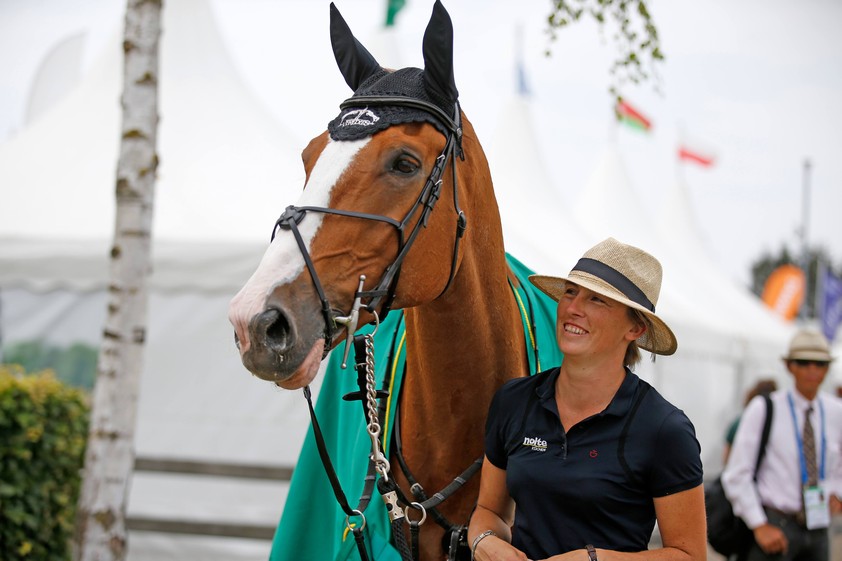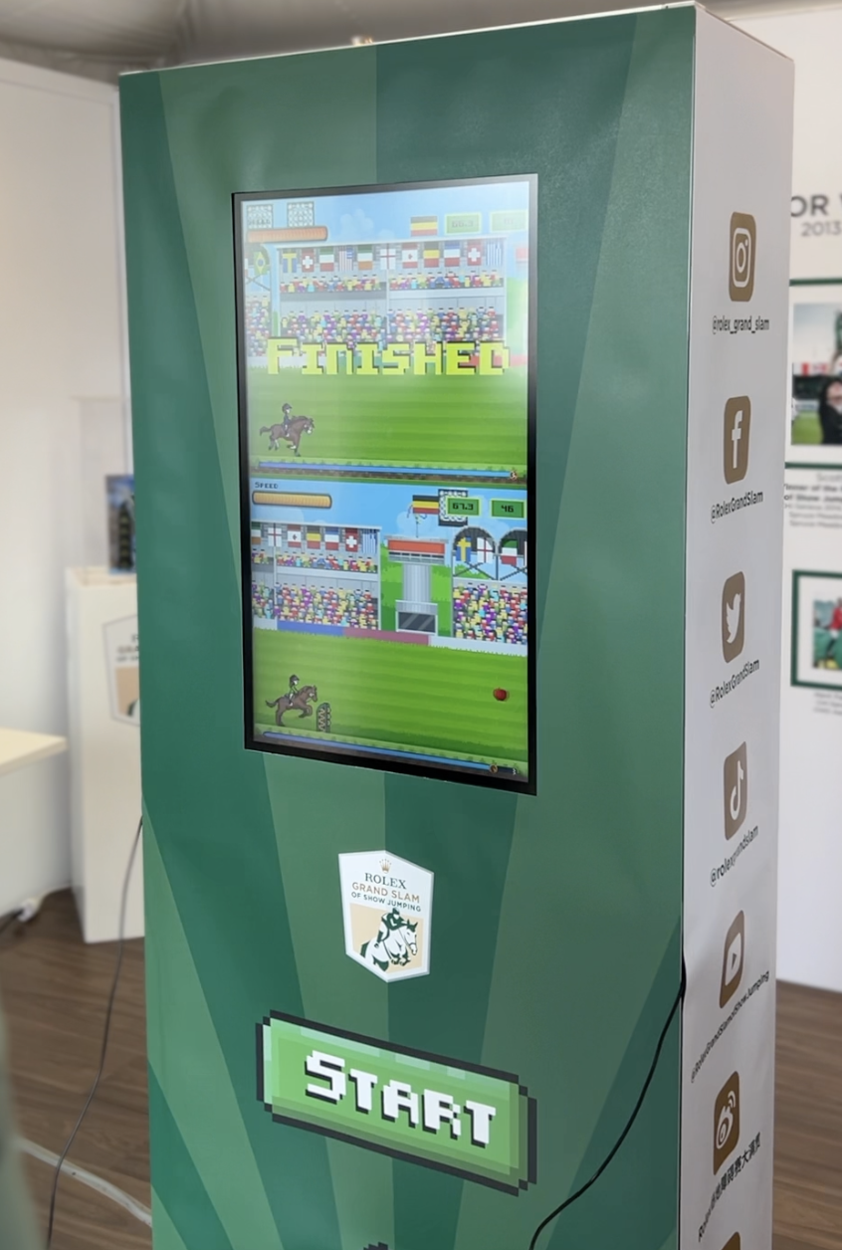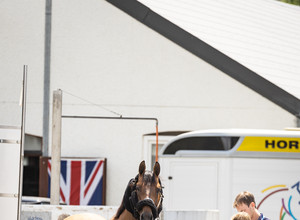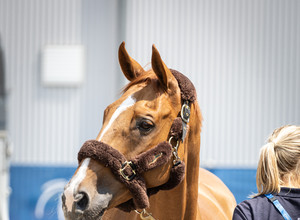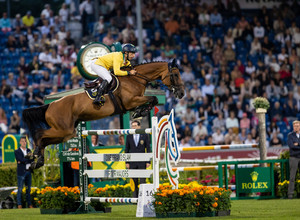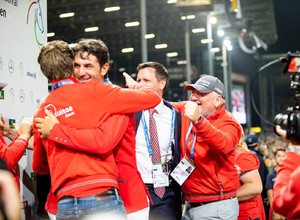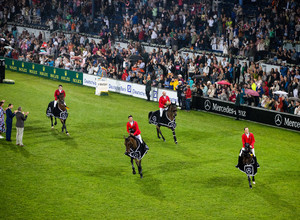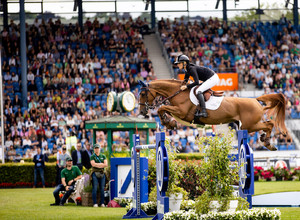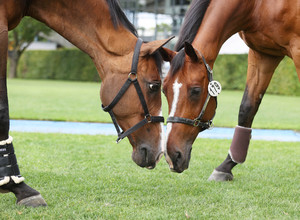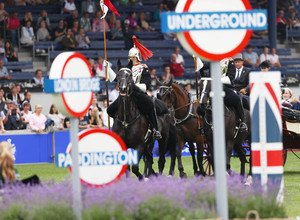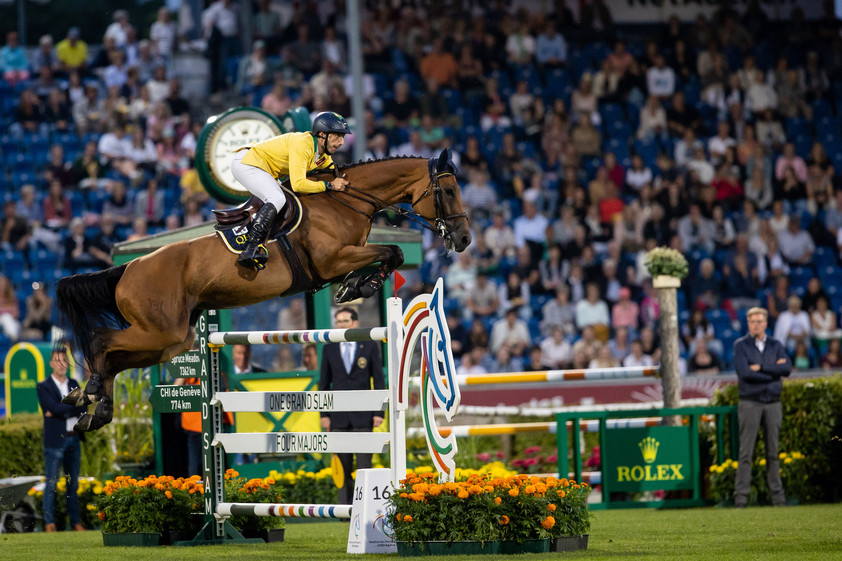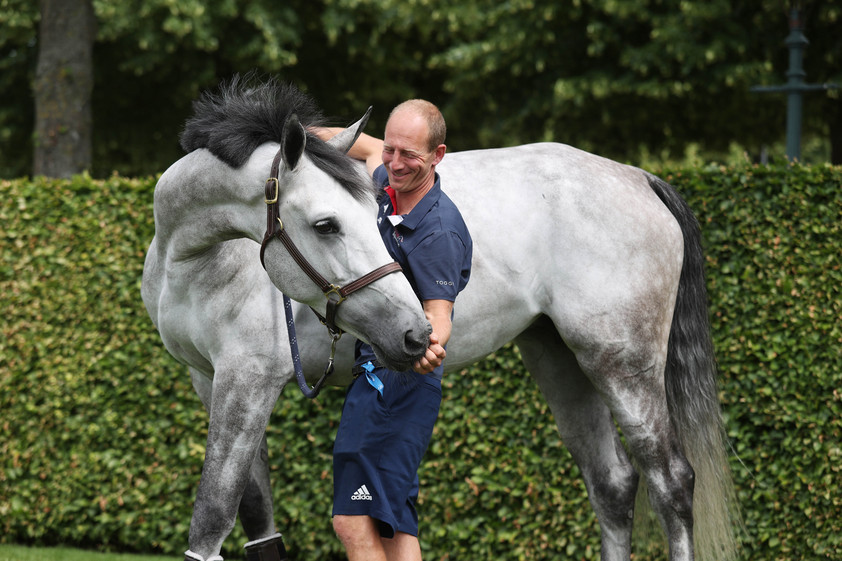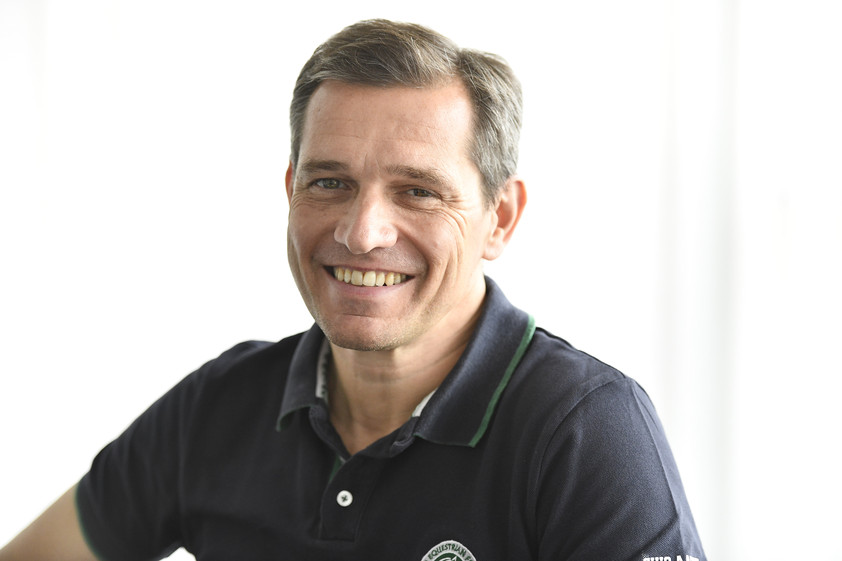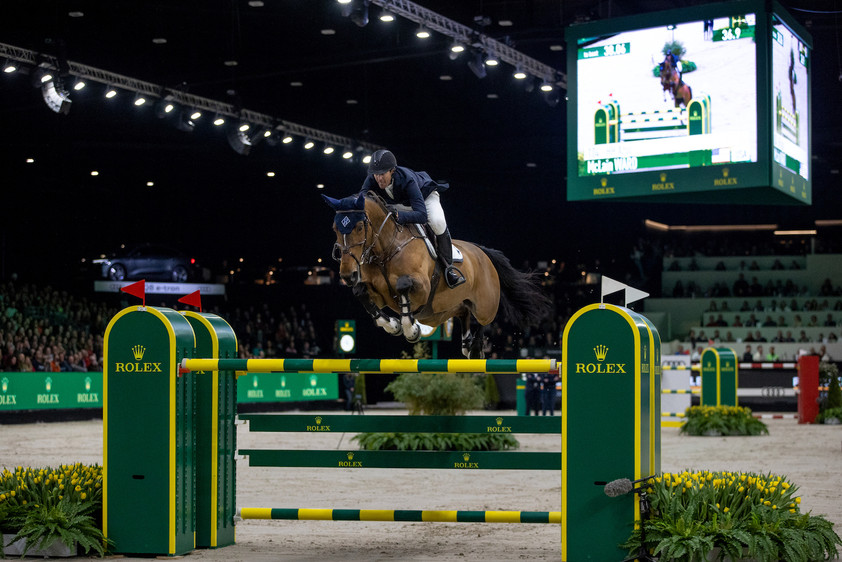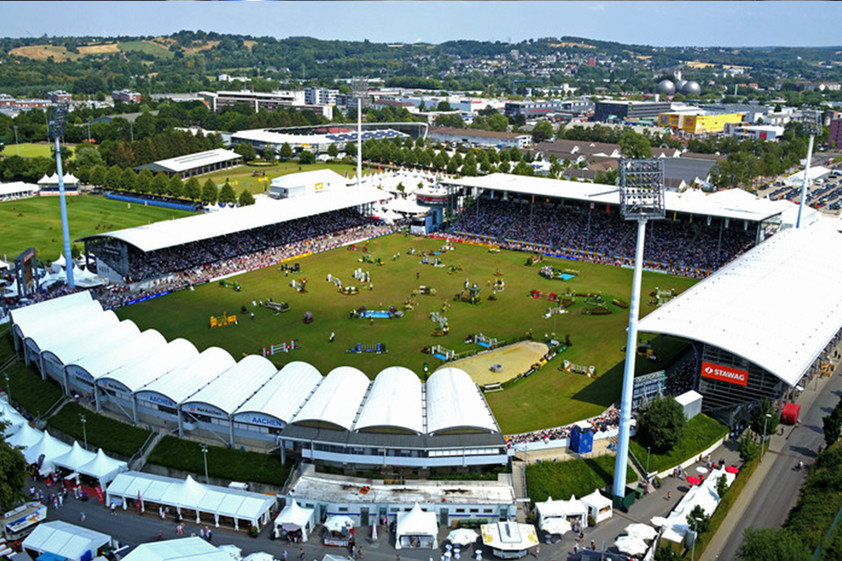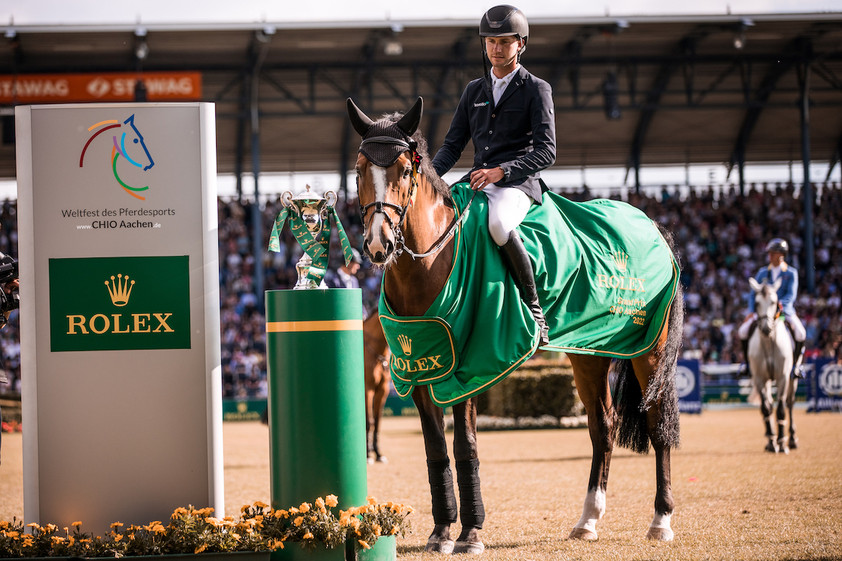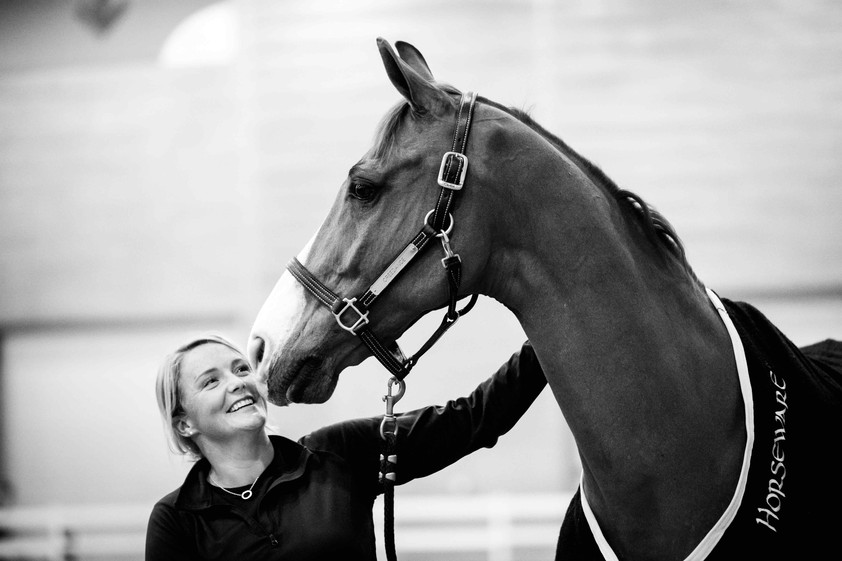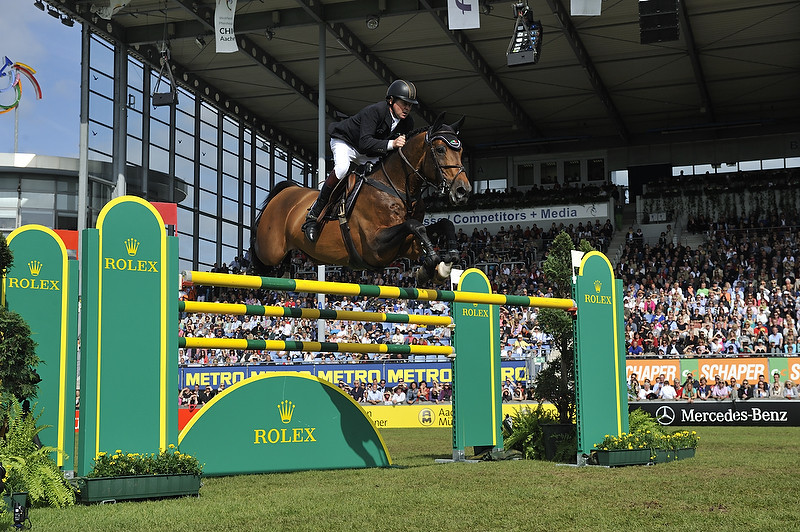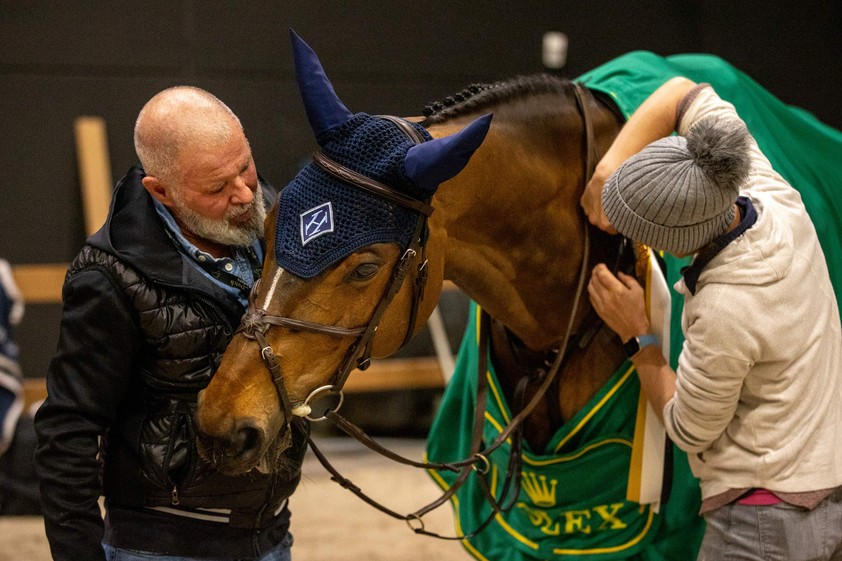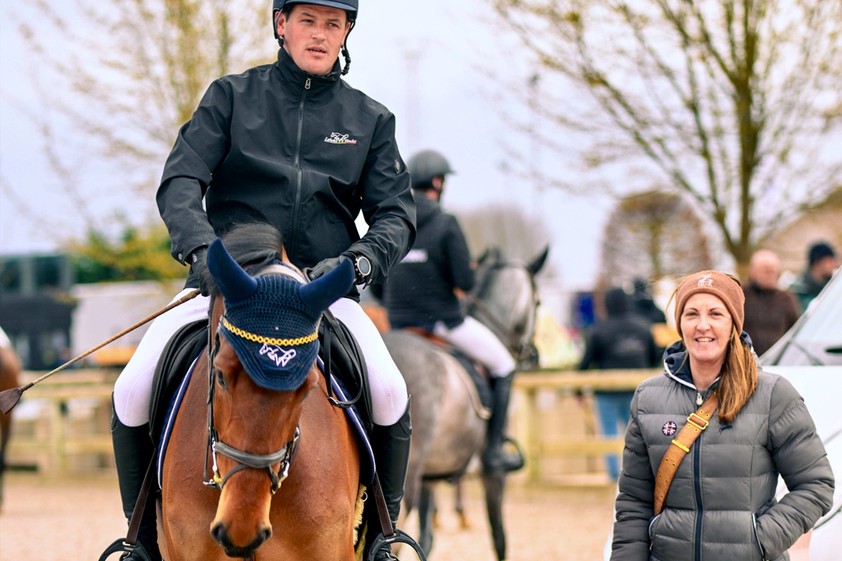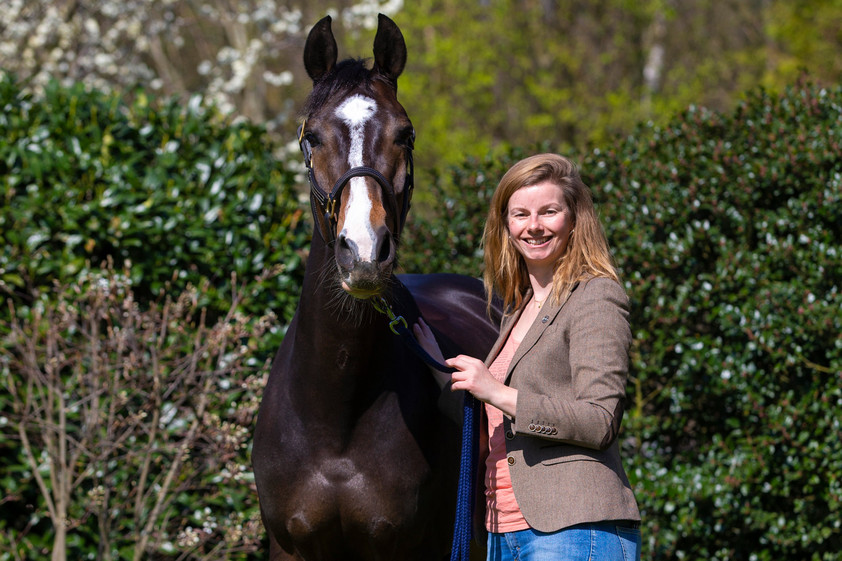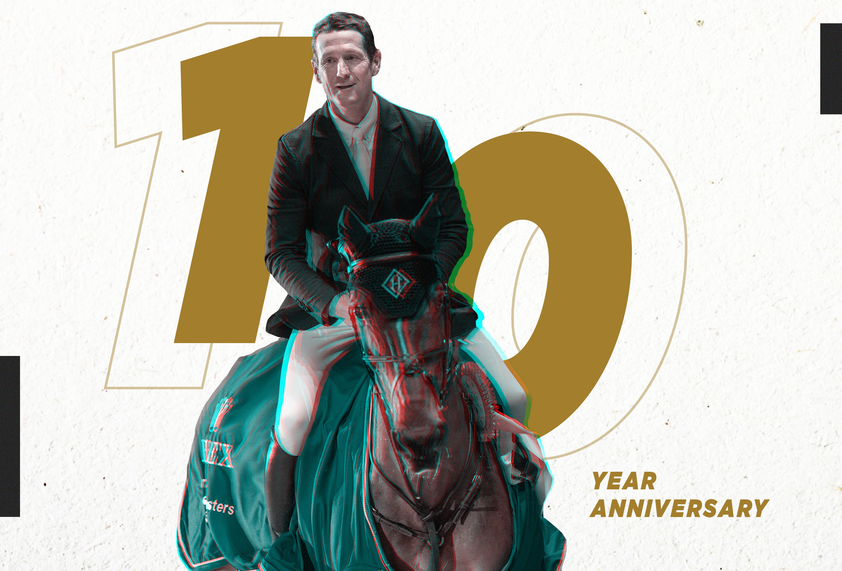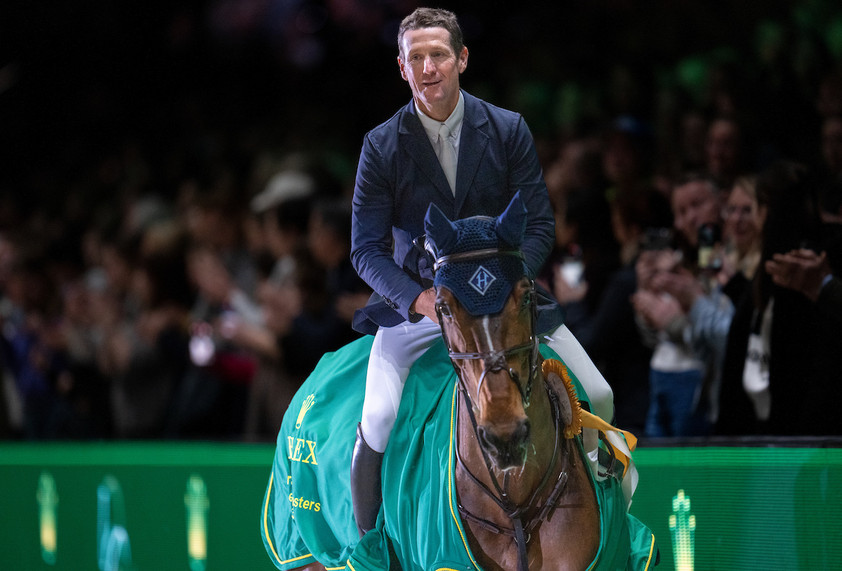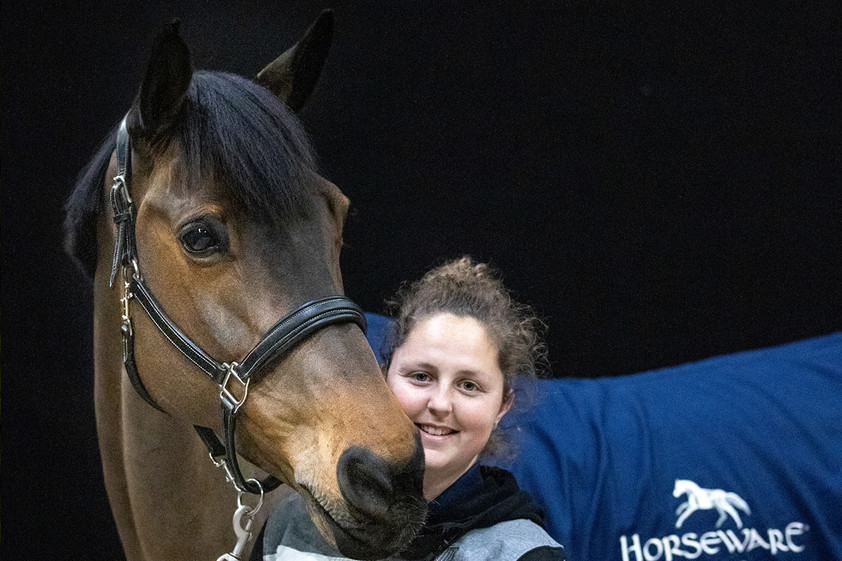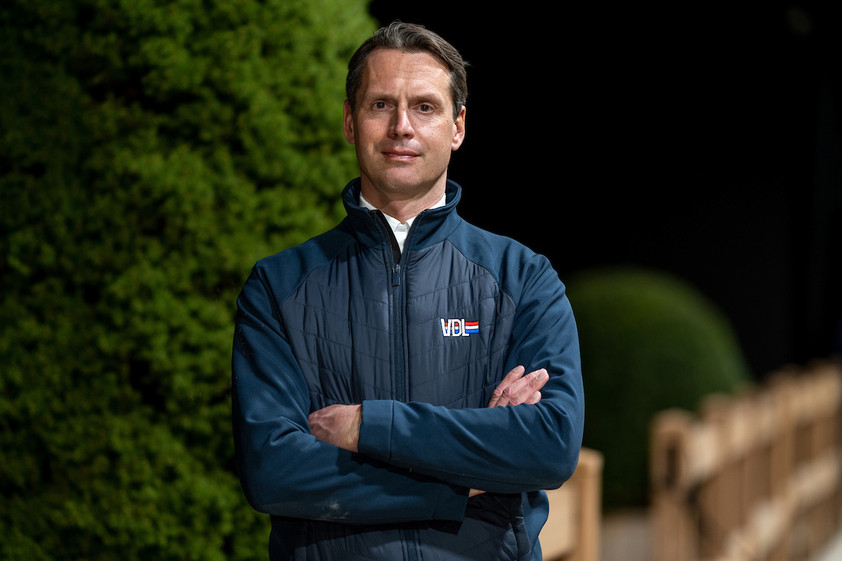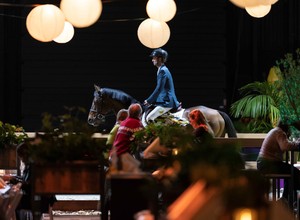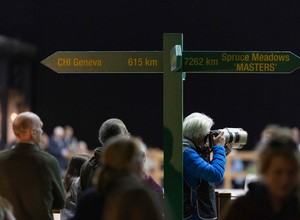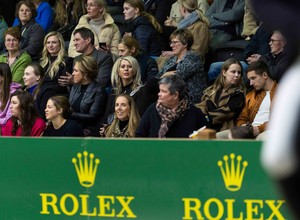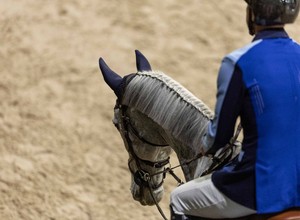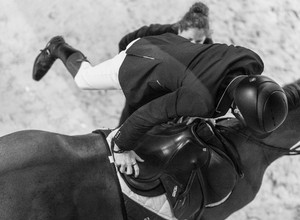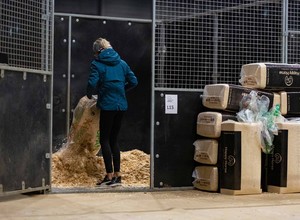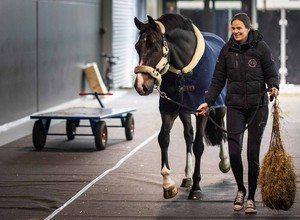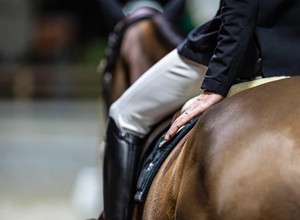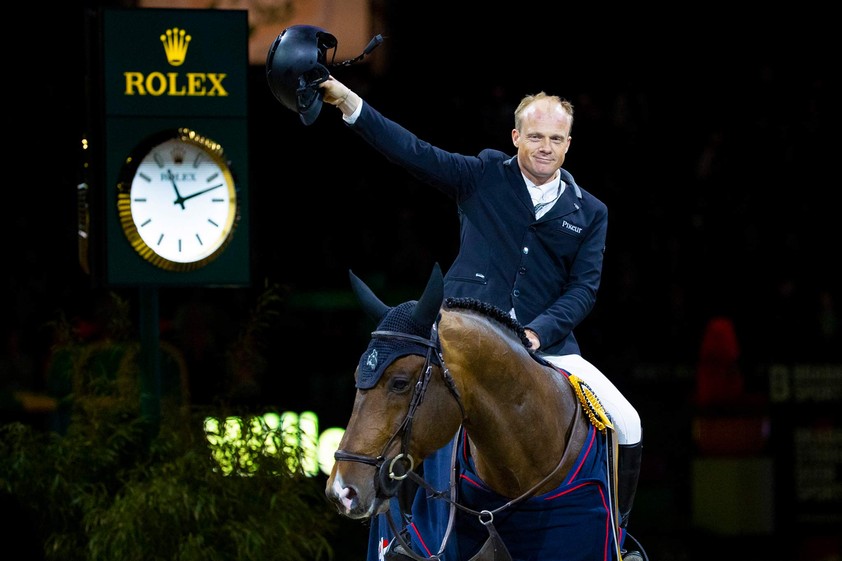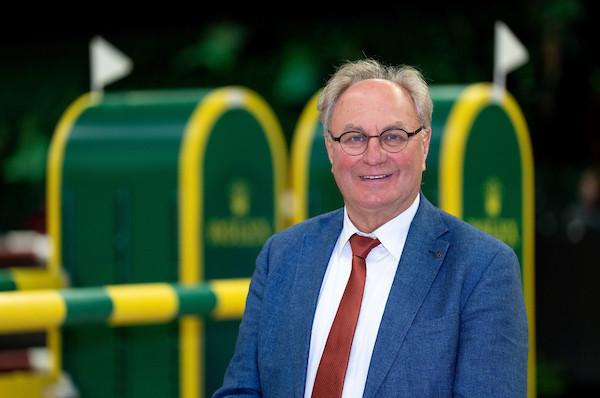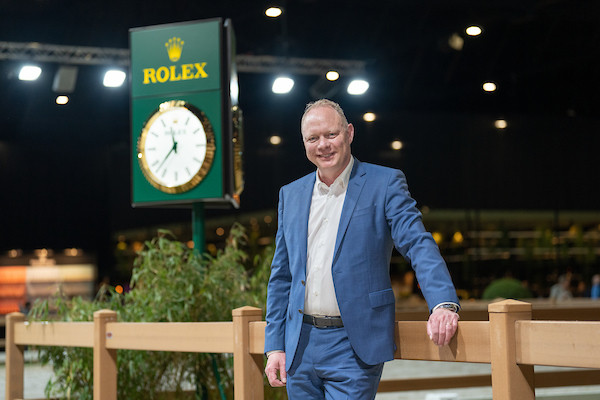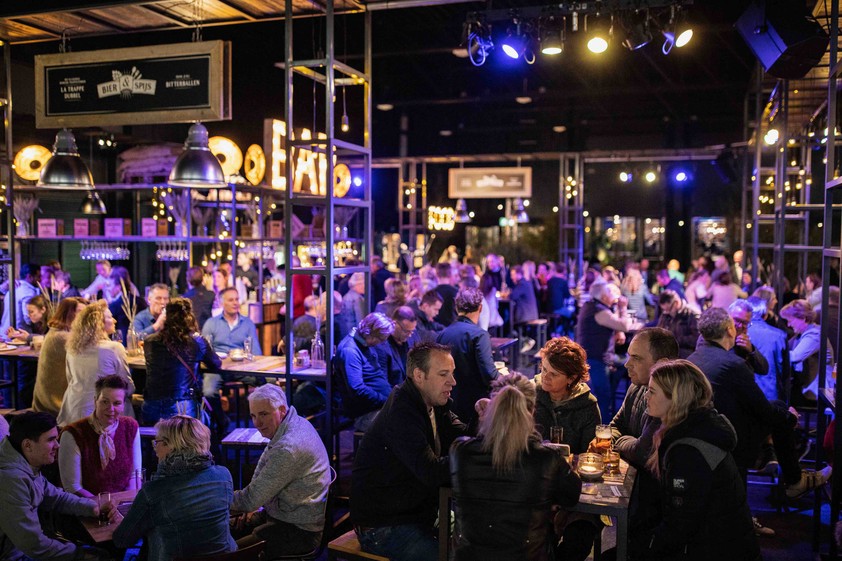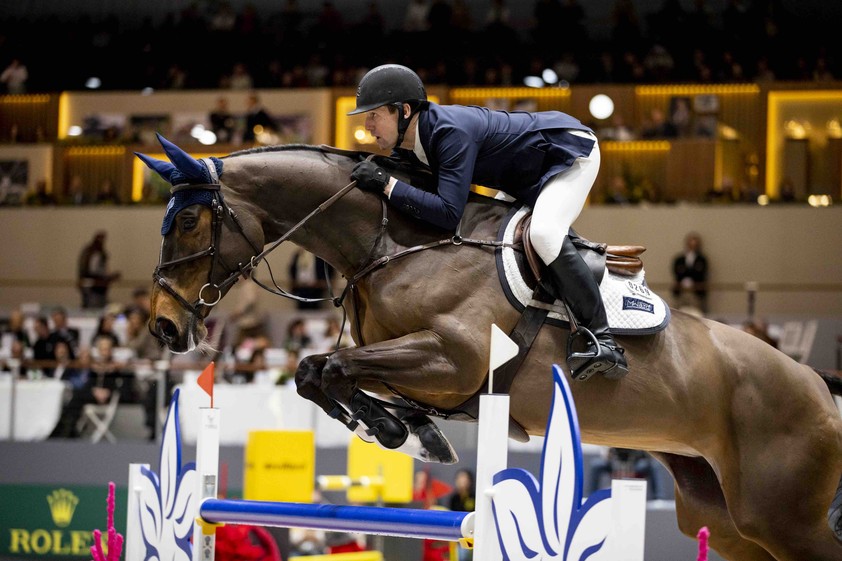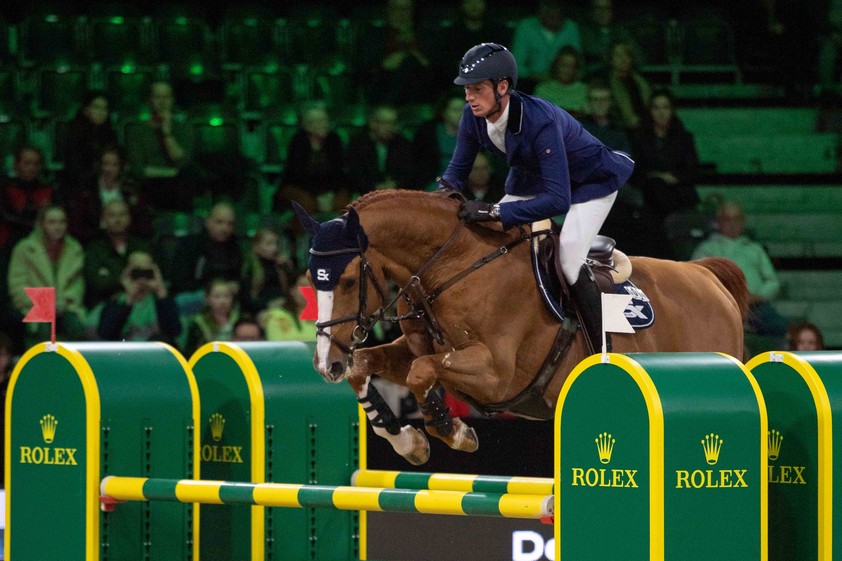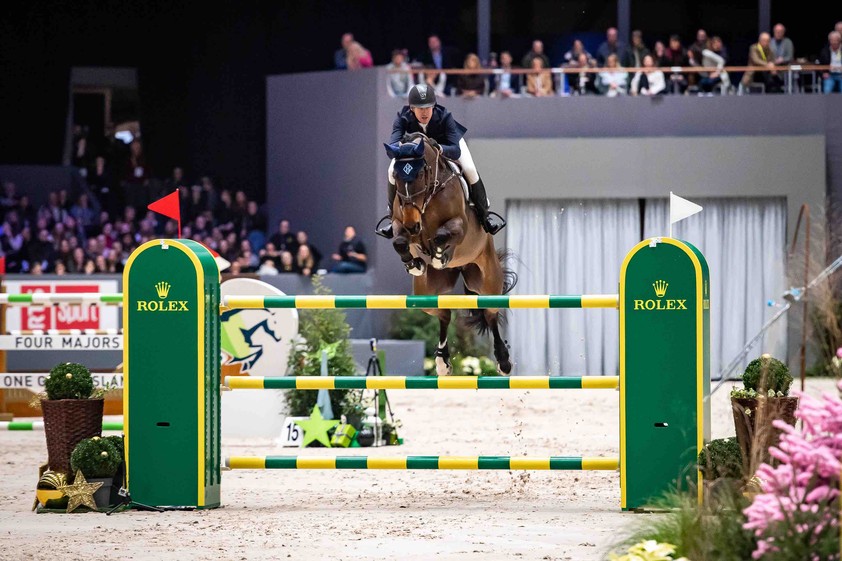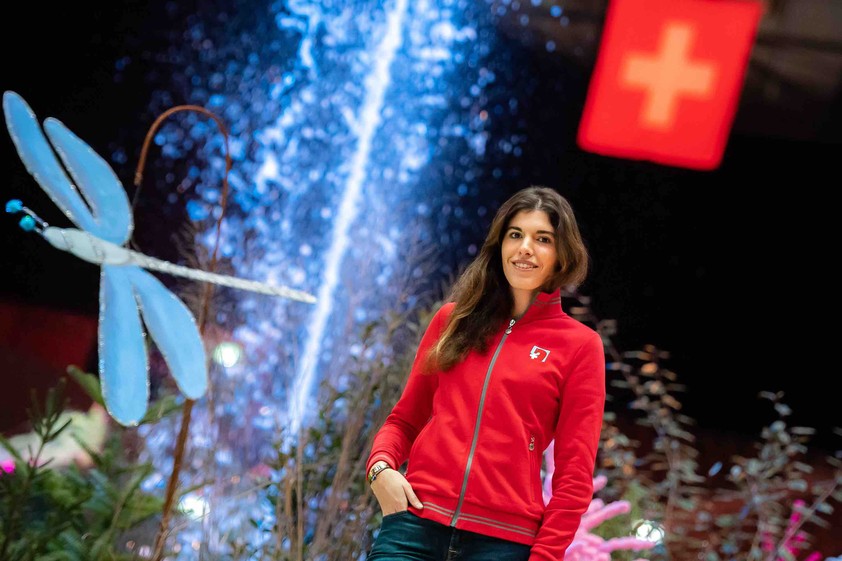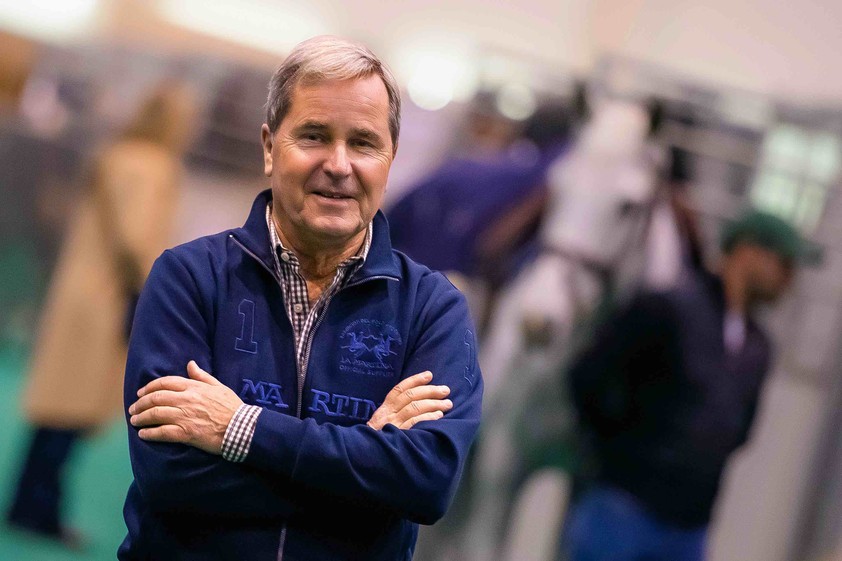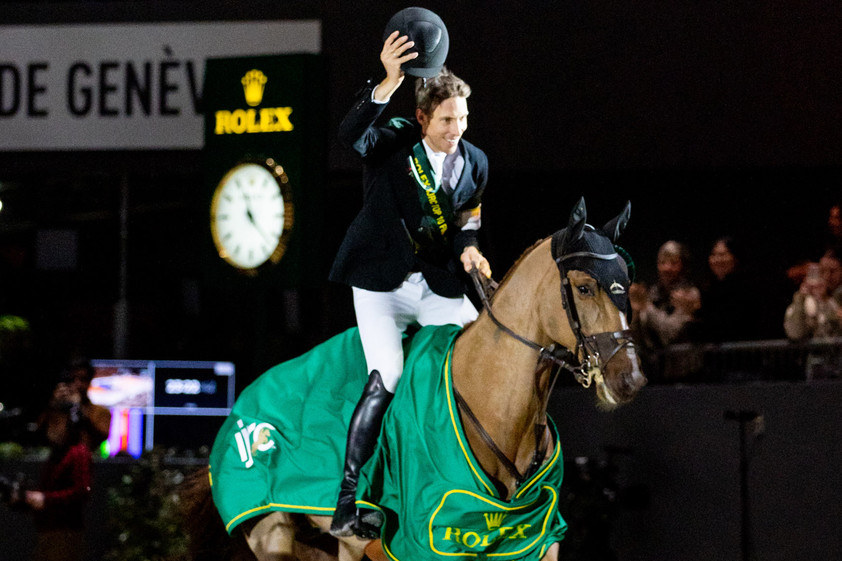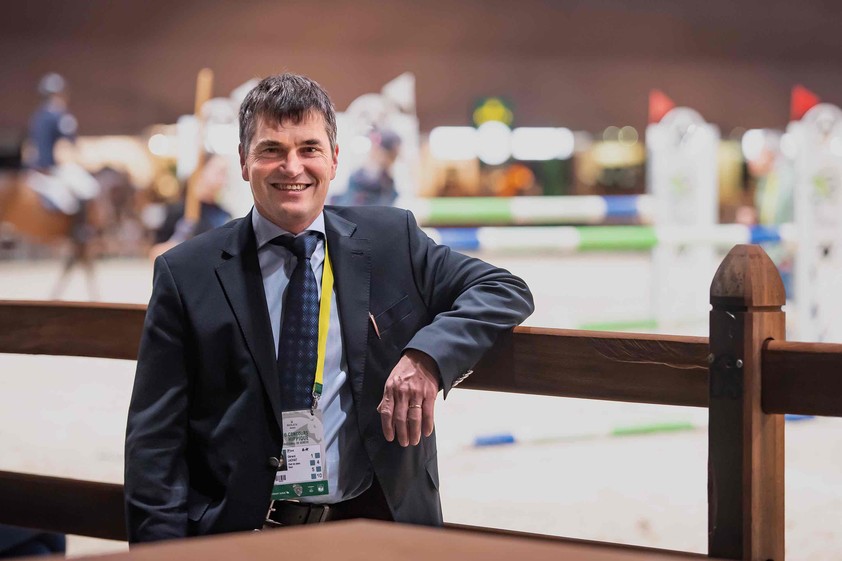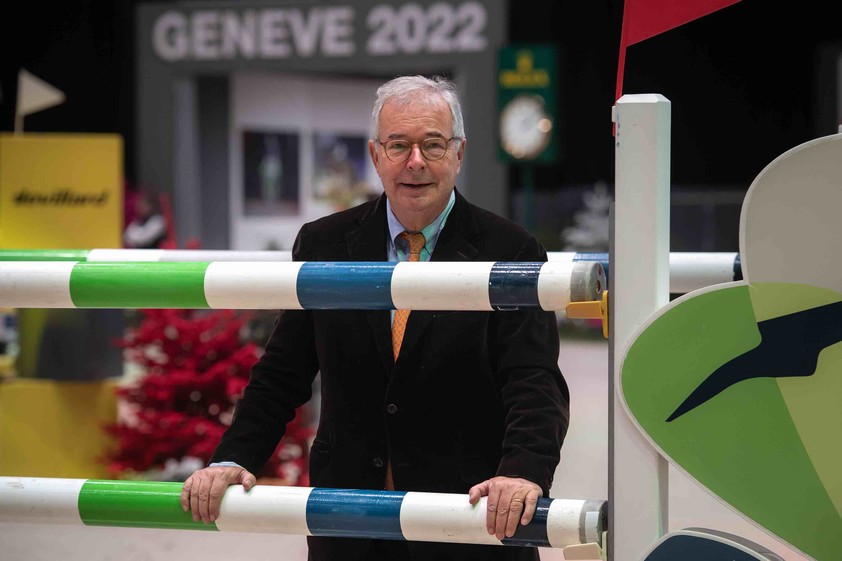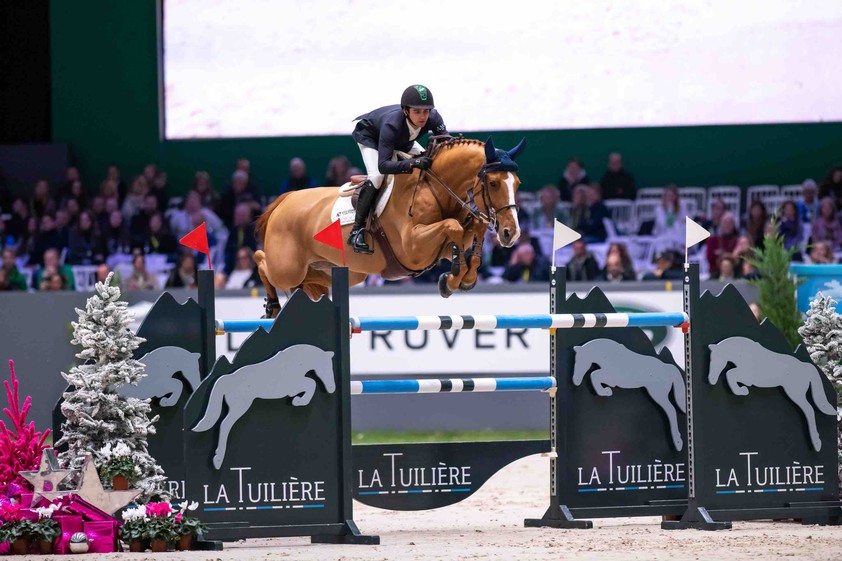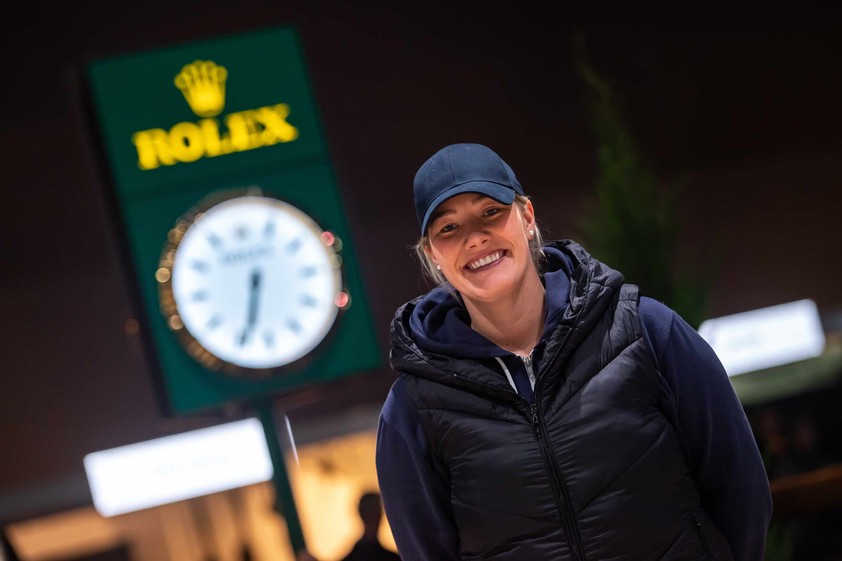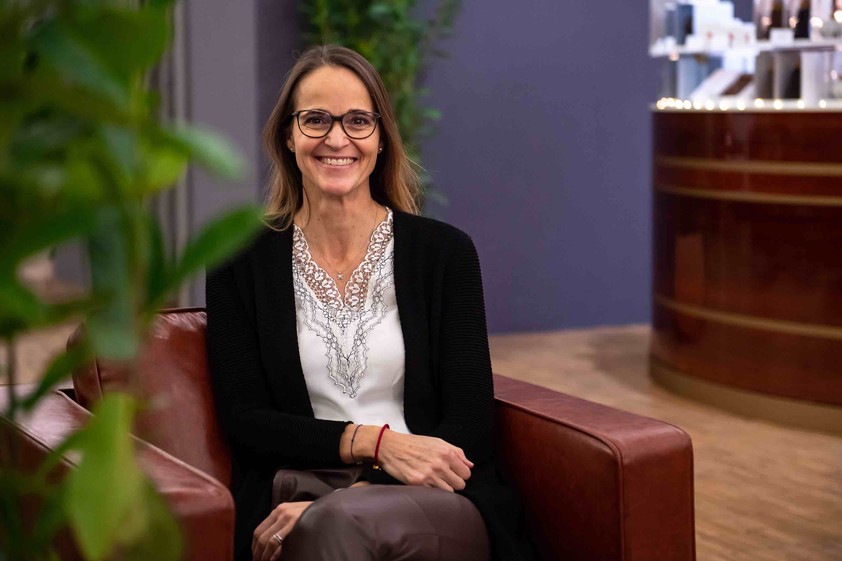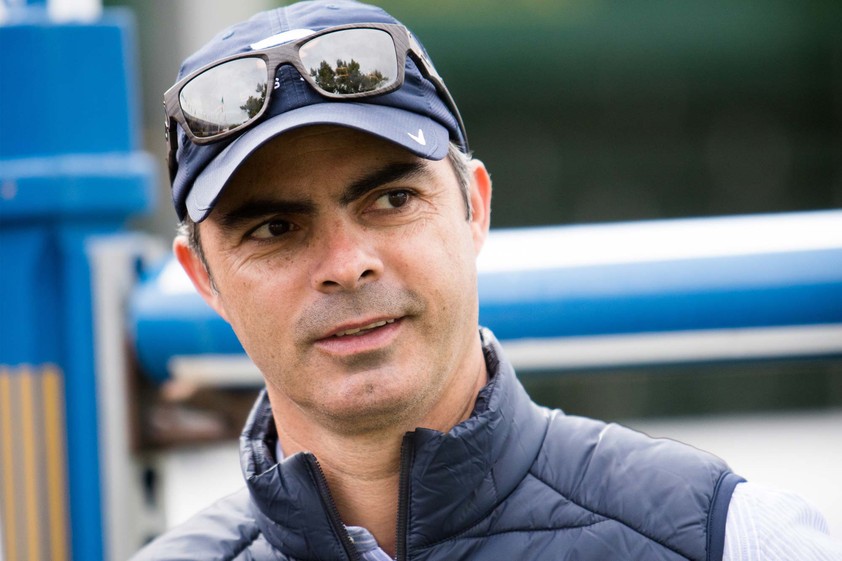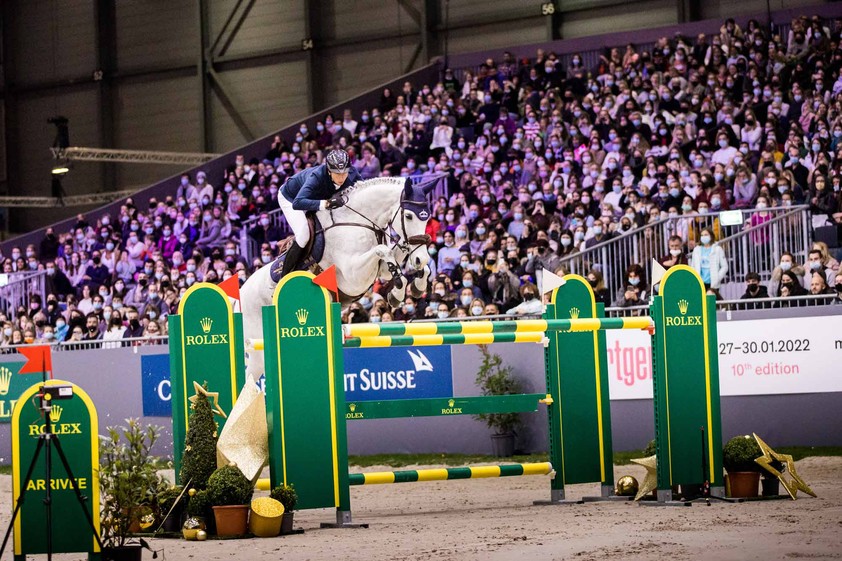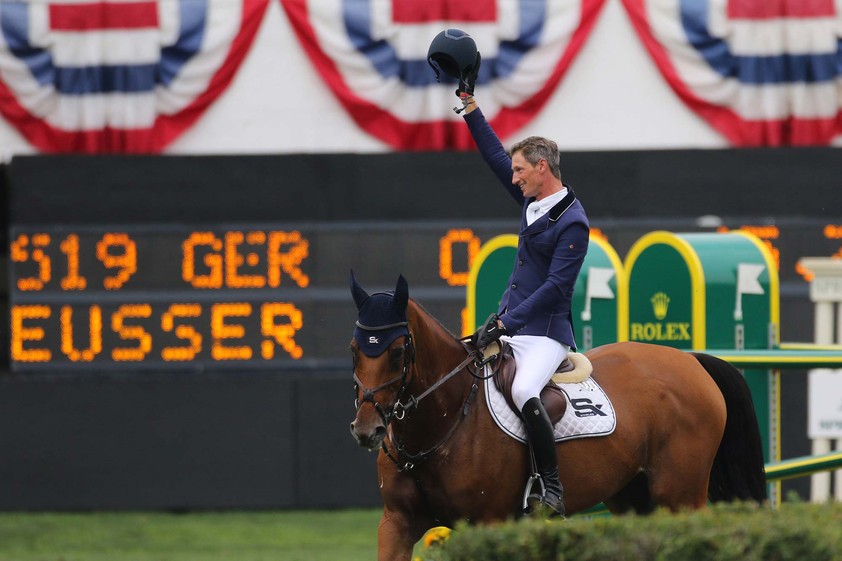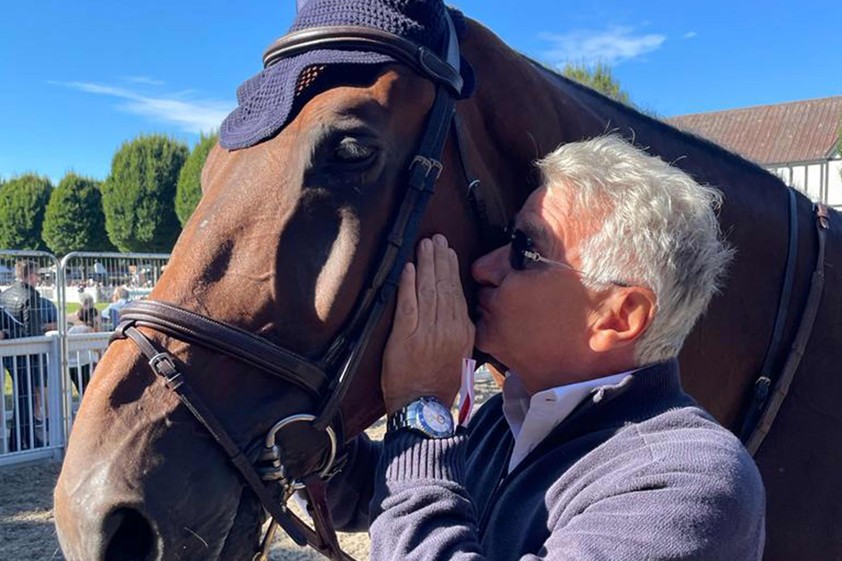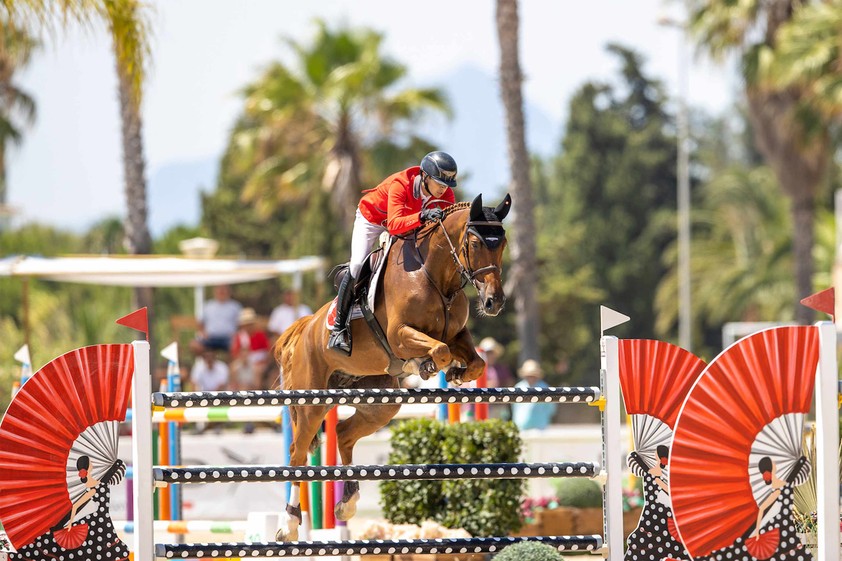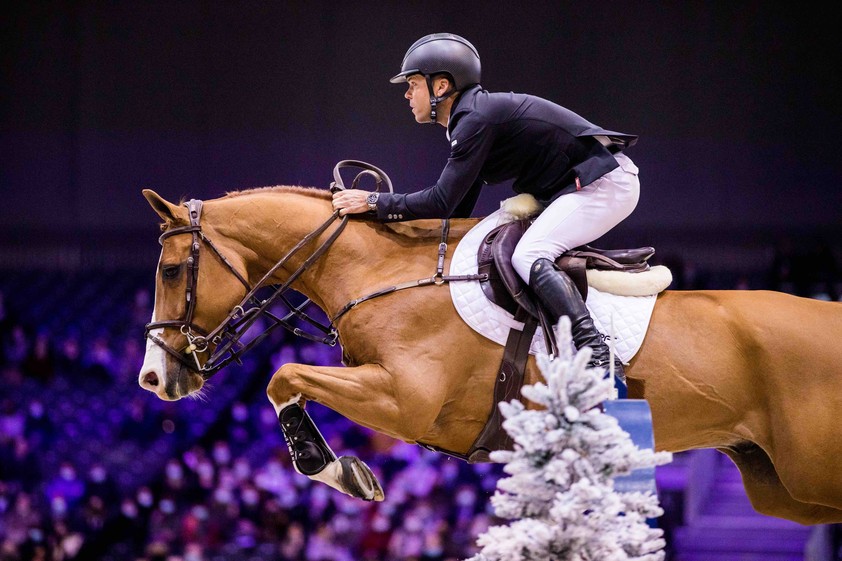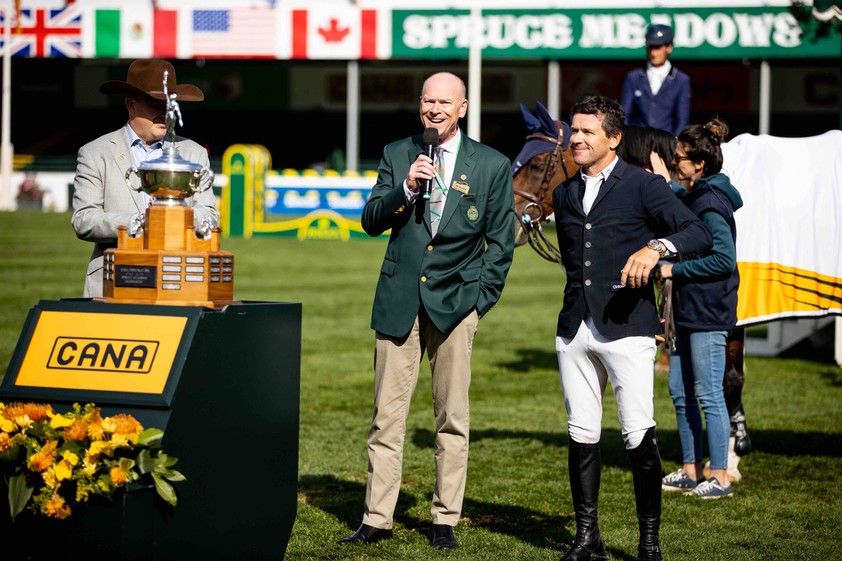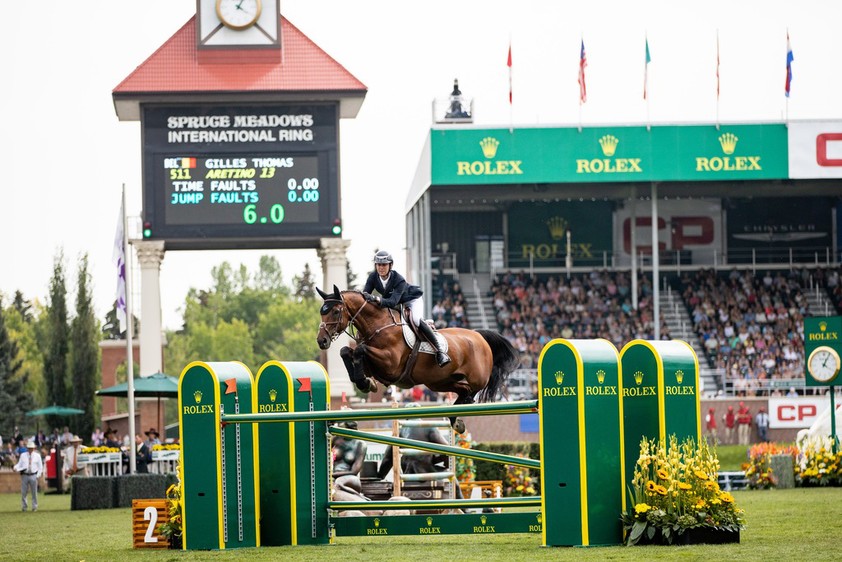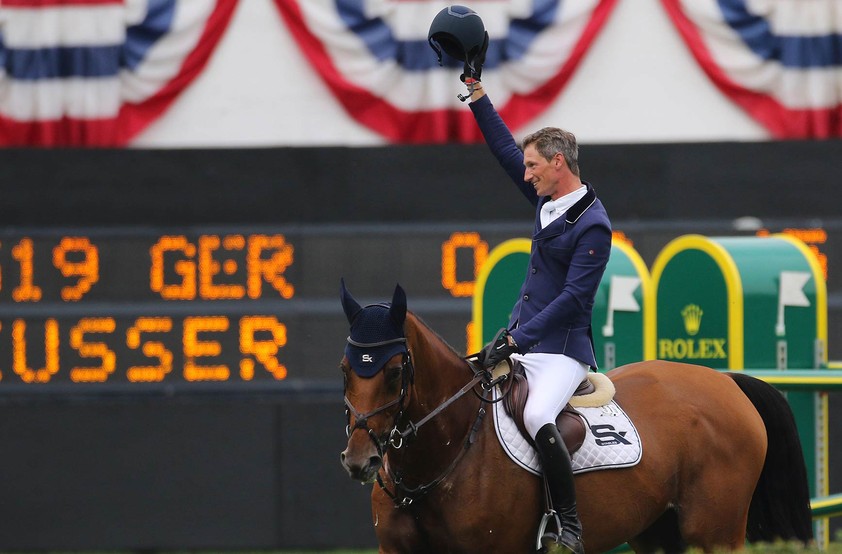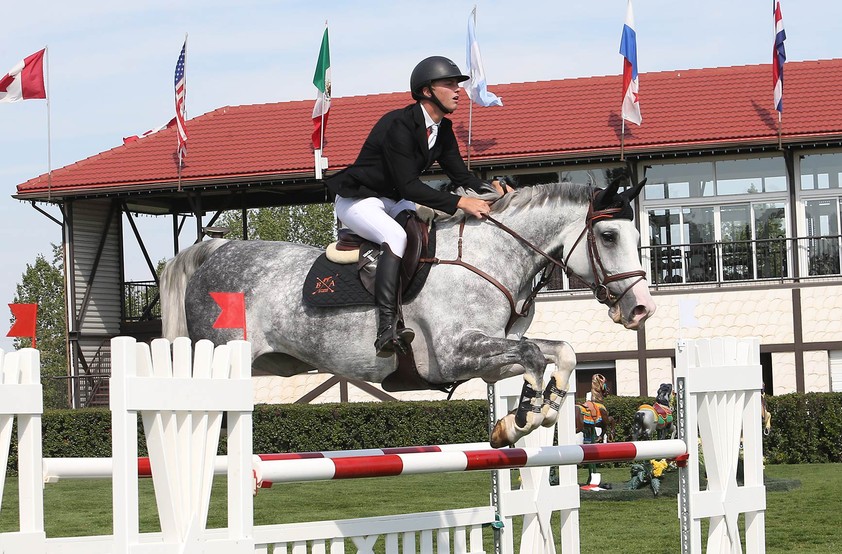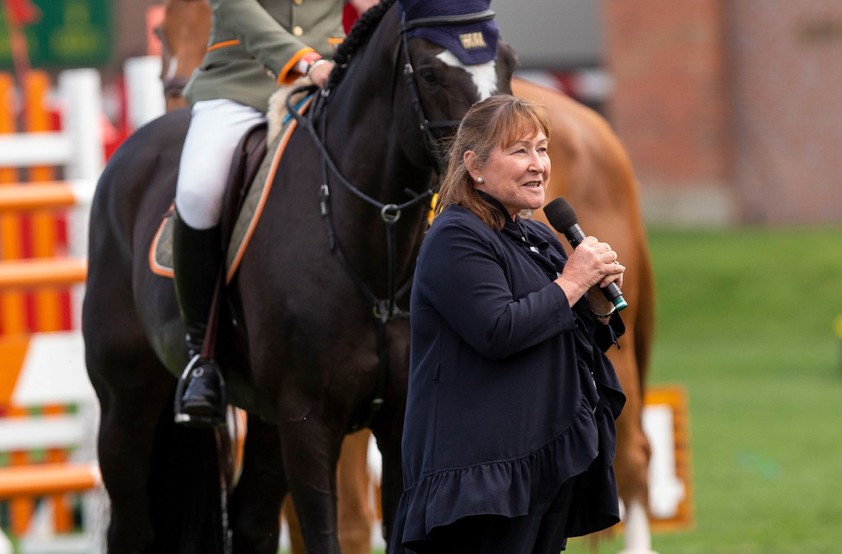Can you introduce yourself, tell us who you work for, and what your role is?
My name is Melina, but most people call me Mel. I have been Marcus Ehning’s groom for the last seven years, both at shows and at home – I do everything!
What is he like to work for?
Great! He is very easy going and he trusts me a lot. Everyone at our stables are like family – Marcus’ sister manages the stables now, she used to groom for him before. I really enjoy working with Marcus, he is helpful, never late – in fact, he is often too early! When you need help, he is generous with his time. He is quite rightly, strict in the warm-up, but overall, he is friendly to everyone, including all of the grooms.
Can you explain the role that you have as a groom to coordinate the wider team, for example vets, physios, etc.
Between four and six weeks before the shows, we as a team, decide which horses we are going to send where, and manage together how we organize their physiotherapy, vet checks and everything else. We tend to leave Marcus slightly out of it, so he can concentrate on the riding. With the help of the management team at home, we organize all the health certificates, stabling, packing of the lorry etc.
How special was it being part of Marcus’ team when he won at CHIO Aachen?
It’s still a bit unbelievable, no one expected it. Stargold is so amazing for what he achieved at Aachen! He had already got so many good results previously in the year, but this was the first time he had jumped the Rolex Grand Prix at the CHIO Aachen. Everything came together this year, and it was just brilliant. It was the second time since I have been a groom for Marcus that he won the Rolex Grand Prix at Aachen, it was an incredible day!
How special is Stargold, and what is it about him that makes him so successful?
He’s really simple. He is a stallion, but he behaves like he is not a stallion! He is not difficult to work with at all, and is very easy to figure out. He loves food and being in the field, although he doesn’t like hand walks – he prefers the crazy stuff! When I am with him at the shows, often in the mornings I’ll put a saddle on him and take him out for a hack, sometimes with other horses too.
As a groom you travel a lot with your horses, how do you ensure that they travel well?
You know your horses very well after working with them every day. You can see when they aren’t drinking well, or when they aren’t happy, so you know when to try and change things. For example, when to give them mash or water, and when to watch them to check they are eating enough and feeling happy.
Every horse is different. Some of them are super with drinking and eating, some of them don’t touch it. While some love to have their food buckets on the ground, others love to hang them up. Some love to eat hay, others don’t touch it – they are all different. However, because I know them so well, I know what they like and don’t like.
You can train horses to travel, or, if it’s a new horse, then ask their previous grooms how they were with travelling to make life easier.
Some horses are very excited when they come off the lorry, others are ready for bed! They are all unique characters, which makes it more fun!
How much do you enjoy coming to the Majors – The Dutch Masters, CHIO Aachen, the CSIO Spruce Meadows ‘Masters’ Tournament, and CHI Geneva? In your opinion, what sets them apart from the other shows?
All the four Majors are different. I have been to all of them, and had the luck to already win at two of them – CHI Geneva and CHIO Aachen. The stadiums are different, but the atmosphere is always great. The Rolex Grand Slam of Show Jumping Majors are different to other shows, there is just something so unique about the four Majors coming together. At the Majors, you always see the best competition and the greatest riders all vying to win.
This atmosphere is particularly special for Marcus at Aachen. He loves to do it, with him being German and Aachen being his home show, he loves to compete there. There is never any discussion about whether we are going to Aachen or not!
It’s the same for other riders too – for Martin Fuchs it’s Geneva because he has the home crowd there. For Dutch riders like Harry Smolders, it’s the Dutch Masters, and for riders such as Eric Lamaze it’s Spruce Meadows.
For the riders, the Rolex Grand Slam of Show Jumping is not only an opportunity to win a lot of money, but a title that stays with you forever. For example, Scott Brash’s Rolex Grand Slam of Show Jumping win is something that everyone will always remember – his three wins, across three different Majors that are all unique is something remarkable.
It is the 10-year anniversary of the Rolex Grand Slam of Show Jumping - how do you think the initiative has changed the sport over the past 10 years?
The Rolex Grand Slam has helped more and more money get invested into the sport, which pushes and motivates the riders. For everyone, even non-horsey people, achieving the Rolex Grand Slam is something remarked as phenomenal. I have friends who know nothing about horses, but they know the Rolex Grand Slam.
What has been your proudest moment as a groom?
There have been a few! I was so proud of Misanto Pret A Tout the year that he won the FEI Jumping World CupTM in Madrid in 2019, having come back from an injury. The German Championships were also amazing this year, with Marcus having last won the title 21 years ago, when he won this year, I thought ‘wow, I made it with him!’
Also, I have been lucky to win a few of the Rolex Grand Slam of Show Jumping Majors with Marcus– we have won Aachen and Geneva together, which makes me really proud.
There are other things, like nominations for FEI Championships, that we work really hard for, and it makes me feel proud when we get selected. I also feel incredibly proud to see horses retiring – obviously you are both happy and sad, but proud to know what they achieved, and excited to see the new generation up and coming.
What is your favourite and least favourite part of the job?
I love to travel; I am probably one of the only grooms left to say this! In the lorry, on flights, everywhere – I don’t mind! I love to travel around the world and face new challenges. It doesn’t feel like work to me, it feels like I am doing my hobby as a job, which I still love, even twenty years on. I couldn’t imagine stopping. When you travel, you meet your friends, new people, see new shows and everything in between.
What advice would give to someone who would like to get into this career?
Being a groom is not easy, it is hard work. If you really love horses, and travelling to shows with them, you will love it. Sometimes you have to forget about yourself, because it is not an eight-hour job, but sometimes more like 24 hours! Although being a groom is a job that you can get a lot out of, and you will have some incredible moments throughout your career.
Every job has good and bad things, some people might get to head home when it hits 5pm, but as a groom it never stops! You are constantly thinking about the horses! You have the opportunity to meet a lot of people, horses and owners, which is fascinating.
What is the grooms’ community like? Do grooms support one another?
I have made some incredible friends, and at shows we try to all get together with barbeques and drinks. My friends are from all over the world. We also sometimes do other things together away from the horses, like going to festivals or concerts, which really strengthens the friendships.
Then there are also the times when you need help, and it’s great to know you have friends on the showground that you can ask for help from. For example, one time I was stuck at the airport because my visa was incorrect. I was two days late to a show, and my friends did my horses, without me even asking. If something is going wrong, my friends will help, because they know that I would do the same for them!
The Rolex Grand Slam of Show Jumping is delighted to announce the development of a new and exciting video game. The retro-style game was fittingly revealed earlier this year at CHIO Aachen – the first Rolex Grand Slam of Show Jumping Major to celebrate the 10th anniversary of the initiative.
Gaining attraction from show jumping fans and world-class riders alike, including last year’s CHIO Aachen Rolex Grand Prix victor, Gerrit Nieberg, the game proved a popular attraction as part of the Rolex Grand Slam of Show Jumping Experience booth, where spectators can also get up close to memorabilia, including the Rolex Grand Slam Trophy, as well as exclusive branded merchandise that is unique to each of the Majors. The booth is also home to a spectacular new VR Experience, enabling you to be virtually transported to both FEI World Under-25 No.1 Harry Charles’ and a multiple Major winner, Steve Guerdat’s yards for a unique behind-the-scenes tour of their facilities and horses.
The video game will once again be available to play at the CSIO Spruce Meadows ‘Masters’ Tournament in September. The multi-player game allows fans to compete over show jumping courses at each of the iconic Rolex Grand Slam of Show Jumping Majors venues, with competitors only able to exclusively compete over the course of the Major they are at.
Players can choose from a variety of different horses and must ensure that they carefully clear each of the fences as well as collect all of the apples to their boost speed to cross the finish line first and accumulate the most points. At Aachen next year, the game will be developed further to provide players to not only choose which horse they want, but also which course they would like to compete at.
Currently the game is only available to those who attend the Majors; however fans will be excited to learn that the game will be available globally online in the autumn, with the courses released in sync with the Rolex Grand Slam of Show Jumping calendar. Followers should therefore be sure to keep up to date with the Rolex Grand Slam of Show Jumping social media channels to learn more about release dates!
Behind the scenes
Wednesday - Thursday - Friday
To download pictures : Click Here
Yuri Mansur & Miss Blue win the Turkish Airlines-Prize at CHIO Aachen 2023
Under the dazzling lights of CHIO Aachen’s iconic Hauptstadion, the world’s best horse and rider combinations gathered to contest the Turkish Airlines-Prize of Europe, the first 5* class of the 2023 Show. The 1.55m competition was held over two rounds, with all clear rounds proceeding to the jump-off. Attracting 53 riders, including the reigning individual Olympic gold medallist Ben Maher, and the current World No.5, Martin Fuchs, the competition was set to be fierce.
The Frank Rothenberger-designed course consisted of 14 combinations in the first round and eight in the second, and provided a suitable challenge for the riders, all of whom had their sights set on early qualification for Sunday’s prestigious Rolex Grand Prix class.
Dutch rider, Marc Houtzager, was first to clear the obstacles, but heartbreak came when he collected just two-time faults. It was, however, the young Swiss rider Edouard Schmitz, who was eighth to canter into the historic arena, who mastered the technical course aboard the impressive 11-year-old gelding Gamin Van’t Naastveldhof. Faults came throughout the course, but much to the delight and cheers of the German crowd, three German riders produced faultless rounds including last year’s Rolex Grand Prix winner Gerrit Nieberg.
Of the initial 53 riders, only seven proceeded to the jump-off. Riders returned to the arena in the same order as the first round, so it was Schmitz once again who set the standard for those who followed, with a clear round in a time of 42.43 seconds. However, his lead was quickly usurped by the Brazilian Yuri Mansur, who crossed the line less than two-tenths of a second faster. The German crowd held their breath as their three representatives entered the arena one after another, but neither Richard Vogel, Philipp Weishaupt nor Gerrit Nieberg could produce the rounds that they may have hoped for, with all three riders accumulating penalties for knocked fences. Mansur’s lead could now only be beaten by one combination, the in-form Martin Fuchs and Conner Jei, but after a slight slip to the second fence, the former FEI Jumping World Cup™ Final winner could not make up the time to secure the win, resulting in the Brazilian claiming his first CHIO Aachen victory.
Speaking on his success, the emotional Mansur said: “This win is so special. In 2018, I came to Aachen for the first time, and I was clear in the first round of this competition, but in the second round things did not go as we wanted them to. But day by day, I’ve worked hard and wanted to be the best. Every year I have returned to Aachen and we have got better and better, and now I have won a class. This is the biggest win in my career.”
Thrilled with his partner, Mansur continued: “This mare [Miss Blue-Saint Blue Farm] is just unreal. She was only jumping 1.30m a year ago and she is only nine-years-old. She is still very inexperienced and so what she has achieved this evening is just amazing. I was one of the first people to import horses from Europe to Brazil at the beginning of my career. I am now the one promoting Brazilian bred horses, and my mare is the best example of how talented they are!”
Interview with David Honnet
Can you introduce yourself, tell us who you work for, and what your role is?
I’m David Honnet, I’m 35-years-old, and I have worked for Scott Brash for seven years now – previously I was the groom for Cameron Hanley. I arrived here on Sunday with Scott’s horses, I am going to be taking care of them all week, and hopefully we will have a good week!
Tell us a little a bit about your journey to CHIO Aachen…
I travelled with the horses on Sunday morning, we left the yard and took the ferry – in total it was a 10-hour trip. The trip went well, but since Brexit, everything takes a bit longer with the paperwork and checks. I got here to Aachen pretty late, and the show vets were really helpful. All the horses travelled well, they are all really used to it. Hello Jefferson has been everywhere in the world, so it was no problem for him. Hello Mango is also a very good traveller, she was in Spain for the beginning of the year, so she has done a few long trips. Hello Valentino is also a very good traveller.
If there is a horse that doesn’t like to travel, what can you do to help it?
Break it down, don’t do big days. Only do small journeys, never more than 600 kilometres at a time if the horse is bad at travelling. If possible, I would advise that you travel through the night, it is always quicker and smoother. You usually do not experience as much traffic or get stuck on the roads, so if it suits your plan and the person driving is able to drive through the night, I would definitely recommend travelling through the night.
Can you tell us about the horses that you have brought with you and what their characters are like?
Hello Jefferson, who is in really good shape, will be competing in the Rolex Grand Prix. He was very successful here last year, finishing second, so we hope to do just a bit better here this year! The Rolex Grand Prix is a tough test, but it is such an amazing experience to jump in it.
Hello Valentino is a nine-year-old and he is here to gain experience. He has a lot of quality and potential, but I don’t think we expect much from him this year because it is a big test and he’s only nine. He is here to gain experience and hopefully in the years to come he will be able to win the Rolex Grand Prix.
Hello Mango is eight-years-old and she is going to be a superstar for sure! She had a very good beginning to the year in Spain, we then gave her a bit of a break to try to get an embryo from her, but it didn’t really work, but she is back and feeling fresh and jumping well. At only eight-years-old, she’s one for the future.
What are the facilities like for both yourself as a groom and the horses at CHIO Aachen?
They are perfect. My main concern when I get to shows is always safety first, and here everything is very safe and comfortable for the horses. I have been to this show a number of times and there are always little improvements and the attention to detail for the horses is incredible. This morning I noticed a new wash bay and it’s things like this that make the show great.
How much do you enjoy coming to the Majors – The Dutch Masters, CHIO Aachen, Spruce Meadows ‘Masters’, and CHI Geneva? In your opinion, what sets them apart from the other shows?
I have to say it’s the Sunday afternoon in Calgary and Aachen, that have the most amazing feeling. Then when you go clear, it is incredible – it is only an afternoon, but it feels like a week, there is so much emotion. It is really very special! Both Spruce Meadows and Aachen have two rounds and a jump-off, so those two Grands Prix feel really unique, there is so much emotion in an afternoon.
‘S-Hertogenbosch and Geneva are also incredible Grands Prix. CHI Geneva is the last big event of the year, so you want to finish on a high. The Rolex IJRC Top 10 Final also adds to the prestige of the show.
How special was it to join Scott’s team after he won the Rolex Grand Slam of Show Jumping in 2015?
I remember exactly where I was when Scott won the Rolex Grand Slam of Show Jumping – I was watching with my girlfriend at that time on the sofa, hoping for him to win it. At the time I had no idea I was going to work for him one day. The year after he won at Spruce Meadows, I was working for him. In 2016, when he once again won the CP ‘International’, presented by Rolex in Calgary we were watching at home with his mother and we went crazy when he won. Scott and I are both calm people and there is rarely any tension. We have some very sharp horses, and so the cooler you stay the better it is for the horses, they don’t need you to put any stress on them.
What qualities do you think that your team has that enables Scott to be so successful?
I think the main thing would be trust. We all trust each other and that is what makes our team so strong. Within the team, you need so much quality and skill, I have some, Scott has some, and then the people at home do as well. Our team trust each other and this probably is what makes the difference between our team and the others.
What is the most important and useful piece of kit that you carry when Scott is competing?
It is really simple! Something that is common to all the groom and horses is that we all give them treats when they come out of the ring, so that I think is something that I always have in the bag. There is no lucky charm, they just need a treat when they get out.
What is the grooms’ community like? Do grooms support one another?
Yes, it is a small and close community. Obviously, you cannot like everyone, and you need a strong character to do this job as there are a lot of big characters, but once you’ve got your friends, everybody helps each other. Once you find people you trust, you can ask them if you are struggling or if you need advice, like ‘how should I do that’ or, ‘what should I do if I have this problem’. I have been doing this job for years, but I remember at the beginning of the year I went to ask for advice from another groom because I had a difficult horse I needed help with, and that is what is so great about this community.
Interview with General Manager at CHIO Aachen Michael Mronz
How has planning been going for this year’s event?
We are looking forward to it, I think it is going to be a great show and we have a fantastic partner country this year, Great Britain. We are delighted that Her Royal Highness The Princess Royal joined us for the opening ceremony, I think that it was very important for the sport, as well as the fans from Aachen, Europe and around the world – we are incredibly excited about the upcoming days.
This year CHIO Aachen is partnered with Great Britian, can you tell us about this relationship and what spectators can expect to see.
It was always a dream for us to have Great Britain as a partner country – they have a tremendous relationship with horses, especially the Royal family. The Musical Ride of the Household Cavalry performed in the opening ceremony, and we asked spectators to dress themselves in the ‘British way’. We also included a number of the fantastic British riders in the opening ceremony, including Nick Skelton, the first winner of a Rolex Grand Slam of Show Jumping Major in Aachen ten years ago. We are also delighted that a very strong dressage team from Great Britain will be competing here including Charlotte Dujardin and current FEI World Champion Lottie Fry – it is going to be a great week.
Is there anything new that CHIO Aachen has introduced this year? Will you be doing anything special to mark the 10th anniversary of the Rolex Grand Slam of Show Jumping?
This year, the Rolex Grand Slam of Show Jumping will celebrate its 10-year anniversary, and there is a chance that McLain Ward will win the Rolex Grand Slam and become only the second rider to achieve this feat after Scott Brash in 2015. It would be unbelievable for this to happen on the 10th anniversary – if you were to write a story, you would write it like this. There will of course be a very strong field of competitors, on one hand the riders want him [McLain Ward] to win, but on the other hand the riders want to win themselves. There will be some very competitive classes, especially on Sunday with the Rolex Grand Prix.
Away from the competition, we have really focused on our digital innovation and new products. This year we launched a new app with a lot of new services for the spectators. Fans can now plan their own customized special CHIO Aachen day, and highlight classes they don’t want to miss, access all the start lists and can follow all the riders around the course, for example in the SAP Cup on Saturday. Communication with our spectators is one of the team’s focal points this year and we think the app will be a great addition to CHIO Aachen.
The first Rolex Grand Slam of Show Jumping Major happened at CHIO Aachen 10-years-ago. How has the initiative positively impacted Aachen as a show?
We are extremely honoured and happy to have such a strong relationship with Rolex, and incredibly lucky that the brand is so supportive of the sport. CHIO Aachen also incredibly fortunate to be supported other brands such as like Allianz and Turkish Airlines. The Rolex Grand Slam of Show Jumping gave CHIO Aachen an amazing opportunity to place the show together with three other elite shows; Spruce Meadows, Geneva and ‘s-Hertogenbosch to create a new level in show jumping.
There are now over 100 5* shows on the calendar, and those spectators who aren’t so familiar with the sport don’t understand which are the best shows. The Rolex Grand Slam of Show Jumping helps to identify the top four shows on the calendar, as it easy to compare them to the tennis and golf Majors, which is helpful for the spectators. In addition, it helps the riders because they can plan their season with their horses around these four Majors. I think the Rolex Grand Slam has made a tremendous change in the sport.
What has been your personal highlight from the first 10 years of the Rolex Grand Slam of Show Jumping?
At the press conference, held in Gothenburg in 2013, we launched the Rolex Grand Slam of Show Jumping and I think it was a real surprise for the equestrian world – from the idea to the concept, and our presentation. That was an incredible moment.
Of course, when Scott Brash won the Rolex Grand Slam of Show Jumping in Spruce Meadows the atmosphere was unbelievable. Nick Skelton’s victory in 2013 on Big Star at the very first Major was also incredible. Each Major has its own special moment, for example, last year in Aachen, Gerrit Nieberg had an unbelievable round in the jump-off and everybody was surprised when he won – nobody knew how good he really was and he then went on to finish fifth at Spruce Meadows too over an incredibly tough course. I think the Rolex Grand Slam of Show Jumping showcases new talent and new stars, which is special.
What is your advice to someone who wants to get into the sporting events industry?
Well, it depends, I would say if you look to the Aachen team, we have a nice spilt between members who are passionate about equestrian sport and those who are into marketing and communication. I think you need decide what direction you want to go in before you try and enter the industry – do you want to be more involved in the sport, or the marketing? I think it is difficult try and focus on both areas and so in the beginning of your career it is important to decide for yourself which is more important. I think my main piece of advice is just to be yourself and decide what you want, and then you will be successful.
For you, as well as CHIO Aachen, what are the key components that make a successful sporting event, or sporting major?
Firstly, and most importantly, the riders and the horses are essential. Secondly, the infrastructure has to be in the perfect shape, so that the world’s best horses and riders can compete at their best. Another point is the atmosphere – ensuring that the spectators have everything they need and the facilities are up to standard. I think if you want to present professional sport there has to be a professional infrastructure. Professional infrastructure means a professional media presentation, but at the same time also a professional atmosphere with a huge crowd of spectators. Then of course entertainment for the spectators, not only the sport but the food and shopping villages.
Like the tennis legends Nadal, Federer, and Djokovic, who have dominated the tennis world and its Majors, how important is it to Aachen to have the best in the world competing at your event?
Well, of course, it is important to have the best horses and riders at the showground, but due to the nature of the sport sometimes you have to accept that the best horses and riders are injured. We are fortunate that at Aachen we have a very strong field in all five disciplines.
Riders are different from other athletes who compete in, for example, tennis or Formula One, where you will have a few athletes who dominate for a couple of years and then the next generation will then come up through the ranks. In equestrianism, the rider can be 60-years-old and still compete at the top level. Therefore, the riders have a longer time in the sport, and so I think you have a larger number of top names than you do in other sports.
Aachen is known as the Wimbledon of the equestrian world, how do you ensure that you continue to innovate and adapt to ensure you maintain this status?
It is a privilege for both myself and the team to work for Aachen. We have the possibility and the honour to ride on the heritage and the history of the Aachen show. The club was founded 125 years ago, and next year we celebrate 100 years of show jumping classes.
There is also the responsibility to develop the show, and always look for what could be the next step. For example, when we held the FEI World Championships in 2006, we installed a floodlight system. Today, on four out of six days of the show we have night classes, which reach more spectators than the afternoon performances via television broadcasting. We have also built new infrastructure, grown our number of facilities, spectators, and so-on.
In the past we have done a lot of investment and have ideas in mind for the future. We started Aachen CAMPUS during the Covid-19 Pandemic, where we train and educate those who are in the equestrian industry or who want to join it, offering classes and over 100 training days during the year.
In the future we would like to include para-riders and other things at the Aachen show. So, I think we have a lot of strong ideas in place which we are looking forward to realising and developing to take the Aachen show to the next level. We have a big responsibility to ensure that Aachen continues to be the best of the best, and I am delighted that we have a very open-minded operations and advisory teams.
Do you and CHIO Aachen organisers take inspiration from any of sport’s other major competitions, e.g., in tennis or golf?
I personally think you can learn from the smallest show and from the biggest one – it also doesn’t matter what sport it is. It would be arrogant if I, for example, thought I knew how everything works and how everything runs. There are always small events that I go to and see things and think wow, that’s a great idea. I don’t instantly think ‘I have to copy that for Aachen’, it is more that I take the idea and join it with one or two other ideas, so it comes out as a new idea that is applicable to Aachen. I really like to go to other sporting events, including the Grand Slam tennis tournaments and major golfing events, but also to smaller equestrian events – you can always keep learning!
Congratulations! You are still the Rolex Grand Slam of Show Jumping live contender, how are you feeling ahead of CHIO Aachen?
I feel good, but I am always cautiously optimistic. We've tried to make sure that the horses are in the best form possible. We compete HH Azur very sparingly because of her age and just aim her towards big events. You have to have belief in your programme and trust that you have got everything right, especially when you're not competing regularly, but she feels good. We are very focused on CHIO Aachen in general – we look at Aachen as a championship. For us, it is the biggest and most prestigious event in the world. I am trying to keep grounded and not let other possibilities seep into my head – I think you get easily distracted by these things.
How did it feel to win at The Dutch Masters?
It felt incredible. It was a class that I didn't think was setting up very well for us when there were so many clear rounds. The Dutch Masters is held in a small indoor arena and with her big stride, I thought it would be difficult to be fast enough. I had a plan to try to do everything we could to win, but I did not expect to win and so when it all came together it was extremely exciting and fulfilling. I then became the only person, apart from Scott Brash, to win two Majors in a row, which is a huge accomplishment and something that I am very proud of.
How have you been preparing, and which horse are you hoping to compete with in the Rolex Grand Prix?
I am lucky to have a great string of horses and I also have some really exciting horses coming up through the ranks. I will be bringing Callas, Contagious, and HH Azur to Aachen, they have been competing very well throughout the spring and early summer. HH Azur has only done one small national show, just to make sure she was fit and give her a jump in a competitive setting. We have kept her preparation the same as we have done for all the Majors – keeping her fresh and targeting the event.
CHIO Aachen is one of the biggest stages in equestrian sport, how does it feel to compete there?
For me, it's the biggest stage. In my opinion, it is the mecca of our sport, and it is the place that means the most for riders to win. So far, the Rolex Grand Prix has eluded me, but I've been very close on a number of occasions. It is the one Grand Prix in the world that I desperately covet, and the fact that it is part of the Rolex Grand Slam of Show Jumping only heightens the energy. There is no place like Aachen; the atmosphere, the crowd, the venue, the history, the level of the sport is all unmatched. I think that everybody rises to the occasion there – it is a very special place.
The last two Majors have been held indoors – will any of your tactics change competing in the Main Stadium at CHIO Aachen?
You have to think more about fitness in a bigger outdoor arena as the course is longer with more galloping involved. On paper, a big arena would suit HH Azur as she has a very big stride, but she has performed exceptionally well in indoor arenas. It truly is a testament to how great she is that she is able to be so successful in multiple venues.
She has also performed brilliantly at Aachen – I think she has been in the Rolex Grand Prix jump-off two or three times, as well as double clear in the FEI Nations Cup™ at least two or three times. I need to ensure that I stay focused and keep my head right so that we can deliver the result that we are capable of.
What do you think are the attributes that a horse and rider must have to be able to win a Major?
You need a horse that has the talent and physical abilities that it takes to jump those courses, but they also need to have the brain to understand what they are being asked to do. It takes years of training and honing those skills for everything to come together at the right time. There are only four Majors a year, and therefore usually three or four winners – so there are not that many combinations who have been able to achieve this feat.
What would it mean to you and your team to win the Rolex Grand Slam of Show Jumping at CHIO Aachen?
Honestly, I think that it is unexplainable. I have a long history with Aachen, with some good and bad moments. Since I was a small child, it is the competition that I have always dreamed of winning – I have always said it has been the girl I could never get a date with. This will be the last time that HH Azur competes at Aachen, so to win the Rolex Grand Prix there with her and for that to mean that we had won the Rolex Grand Slam of Show Jumping – that truly is something that I do not think I can describe.
The Rolex Grand Slam of Show Jumping is celebrating its 10th anniversary – how big an impact has it had on the sport?
I think the greatest impact that it has had is that it has raised the level of competition above any other competition in the world. It is so important, and we needed that in the sport. We need the Rolex Grand Slam Majors to be separated from the other 5* events, as they encourage riders to continue to raise their game and perform in a different gear. I think that the riders have recognised that these are the best events in the world and aim for them – very much like The US Open or The Masters in Augusta or The French Open, these are the most coveted competitions in our sport.
The equestrian calendar is very full! How do you decide which shows to enter and which horses to compete with?
It is a busy schedule. Like most sports, there is an event every week that you could go to if you chose. I am very lucky to have a great team behind me, as well as a great group of supporters and owners. I, therefore, have a strong string of horses of all different ages and levels. My team means that everything moves well, and they ensure that the horses are kept healthy and fresh. To be honest, I do not over-compete – if you look at the FEI World Rankings, I have normally competed in fewer events than most of my colleagues. I like to come home occasionally and aim toward an event.
We look at the schedule anywhere from six months or a year ahead when, for example, we are aiming towards an Olympic Games or a major Grand Prix. We therefore we work backward from that date. The longer-term plan is a little looser and the shorter-term plan is a little tighter. I like to compete in Europe to test my skills against the best in the sport. The level in the United States has also come up considerably in the last few years and we have a lot of great events here now. We lay out the schedule for the year, depending on the horses we have and what the main goals are, and then we break it down into a more detailed schedule on a shorter timeframe.
In tennis, Novak Djokovic has dominated and has now won 23 Grand Slams, do you think there will ever be such dominance in show jumping?
I think to some degree; you see a group of riders that are always very close to the top of the FEI World Rankings over a long period. You could pick a handful of riders, who over the last decade, have been near the top of the rankings. The major factor that is different in our sport is the horse. So, while a human athlete can be at their best for a certain amount of time, your horse may get injured or not feel good, thus you have this variable that it is you and the horse, which differentiates our sport.
I don't think you'll ever see a rider at the top of the FEI World Rankings for a decade. But, for example, Henrik [von Eckermann] right now has been World No.1 for nearly 12 months, in a time when he arguably has the best horse [King Edward], and he is a brilliant rider. It is likely that when the horse is retired, Henrik will stay near the top, but it is probable that he won't dominate in the way he does in this current moment.
If you look through the history of the sport, whether it has been Baloubet du Rouet, Milton, Shutterfly, Hello Sanctos, all of these horses and their riders were a little better than the rest and dominated the sport. I think it is hard to imagine one rider staying at the top of the ranking for more than a couple of years – two or three years at best. I do think that if you look over the last decade or even 15 years, you will see the same names who have stayed consistently at the top.
From 23 June – 2 July, CHIO Aachen will once again welcome the world’s finest horse and rider combinations to the unmatched Aachen Soers Showground. Often compared to The Championships, Wimbledon, CHIO Aachen is a globally renowned event steeped in history and prestige. Over the course of the show, The World Equestrian Festival will host five equestrian disciplines, and will welcome over 360,000 spectators, all whom will be eager to experience the unique and electric atmosphere that CHIO Aachen offers. In addition, 10-year anniversary celebrations of the Rolex Grand Slam of Show Jumping, the sport’s ultimate challenge will begin at CHIO Aachen.
The show will have a Royal opening, with Her Royal Highness The Princess Royal attending the iconic Opening Ceremony on Tuesday 27 June, celebrating the show’s partnership with the United Kingdom this year. Her Royal Highness The Princess Royal is sure to have fond memories of the show as her daughter, Zara Tindall, won individual gold at the FEI World Equestrian GamesTM held at the venue in 2006. The theme of the evening will be based on the Beatles’ legendary song “All You Need is Love” and will include performances from breath-taking Musical Ride of the Household Cavalry and the exhilarating Shetland Pony Grand National.
The 5* show jumping commences on Wednesday 28 June with the Turkish Airlines-Prize of Europe. Held under the floodlights of the Main Stadium, the class provides riders with their first opportunity to qualify for the feature class of the show, the Rolex Grand Prix. The next evening will see the return of the Mercedes-Benz Nations´ Cup, a team competition held over two identical rounds, where only the top eight teams progress through the final round. With the FEI European Championships taking place later in the summer, riders will be eager to impress their selectors. The pinnacle of the show, the Rolex Grand Prix, will take place on Sunday afternoon in front of 40,000 knowledgeable and passionate fans. Much like The Masters Tournament in golf, this is the competition that all of the riders want to win. This year history could once again be rewritten, as American rider, McLain Ward, looks to secure the win to become only the second person in history to win the Rolex Grand Slam of Show Jumping following his previous wins at CHI Geneva in 2022 and The Dutch Masters earlier this year.
Dressage will take centre stage in the Deutsche Bank Stadium across the course of the show. The highlight for the crowd will come from the Deutsche Bank Prize, where harmony and precision between horse and rider will be showcased. Dressage fans will also be delighted to learn that FEI Individual World Champion, Lottie Fry, will perform as part of the “Horse & Symphony” on 23 and 24 June. Music will be provided live by the Aachen Symphony Orchestra and is set feature a variety of classic British songs.
Hosted on the final Friday and Saturday of the show, the SAP-Cup, welcomes world-class eventers. Often referred to as equestrianism’s version of a triathlon, the three disciplines involved test the horses’ bravery, athleticism, and accuracy. Eventing legend SAP Hale Bob OLD, Ingrid Klimke’s multiple medal-winning horse will retire in front of his home-crowd on Saturday 1 July.
Away from the sporting action, ticket-holders will be treated a variety of different shopping outlets as well as a huge range of food and beverage stalls.
CHIO Aachen returns from 23 June – 2 July and will play host to the second Rolex Grand Slam of Show Jumping Major of 2023. This year, CHIO Aachen will celebrate the 10-year anniversary of the Rolex Grand Slam of Show Jumping, the sport’s ultimate prize, having hosted the inaugural Major in 2013. The 10-day show will culminate with the Rolex Grand Prix, which will see some of the world’s top horse and rider combinations from 16 different nations, including seven Rolex Testimonees, compete over Frank Rothenberger’s masterfully designed course.
Rolex Grand Slam of Show Jumping – Rider Watch
All eyes will be on one rider; America’s McLain Ward as he aims to become only the second person to win the Rolex Grand Slam of Show Jumping. The World No.3, who won the Rolex Grands Prix at both CHI Geneva and The Dutch Masters aboard the 17-year-old mare HH Azur, will be looking to write his name into the history books. Ward has experienced success at the show in the past, last year taking victory in both the Turkish Airlines-Prize of Europe and RWE Prize of North Rhine-Westphalia, as well as placing fifth in the Rolex Grand Prix. As a fierce competitor who knows how to win in the unique Main Stadium, he will be one to watch. Ward will be joined by four compatriots who will all be making the long journey across the Atlantic Ocean to the celebrated venue, including his 2020 Tokyo Olympic teammate, Laura Kraut.
He will, however, face competition from the very best in the world including last year’s victor Gerrit Neiberg. The German, who recently took the top spot in the CSI5* Grand Prix in Hamburg, will be seeking to continue this form to become the first rider to win this prestigious class back-to-back. In total, 18 German riders will contest the international showjumping at this year’s World Equestrian Festival including Daniel Deusser and Marcus Ehning, both of whom are also past victors of this prestigious class.
Looking ahead to the 2023 edition, Nieberg stated: “I cannot wait to return to CHIO Aachen to try and defend my title. Winning the Rolex Grand Prix in front of my home crowd truly was a dream come true and something that I will never forget.”
Switzerland’s Martin Fuchs, a double Major winner at CHI Geneva, comes to CHIO Aachen on the back of an impressive victory in the Rolex Grand Prix at CHI Royal Windsor Horse Show with Conner Jei. Fuchs will be hoping to claim his first victory in the Rolex Grand Prix at CHIO Aachen. Fellow countryman, Steve Guerdat, is another amongst the talented field who has never won this coveted title. Guerdat, known for his horsemanship skills, will bring four horses with him to Aachen, including the exciting Dynamix de Belheme and Venard de Cerisy, the horse he rode to victory in the CP ‘International’, presented by Rolex in 2021.
Belgium’s Nicola Philippaerts also returns to the hallowed grounds of CHIO Aachen on stellar form, having taken the Rolex Grand Prix at CSIO Jumping International de la Baule earlier this month with the brilliant mare Katanga V/h Dingeshof, who will also jump at CHIO Aachen. Philippaerts will be joined by his twin brother, Olivier, who similarly will be brimming with confidence following a victory in the CSI5* in Stockholm last week with H&M Miro. They will be joined by Belgian teammates Gregory Wathelet, Wilm Vermeir, and Vereecke Koen.
Great Britain’s Scott Brash will be hoping to improve on his second place in the Rolex Grand Prix last year to reclaim the title he won in 2015 enroute to winning the Rolex Grand Slam of Show Jumping. His teammate, the individual Olympic champion Ben Maher, will be competing at his first Rolex Grand Slam of Show Jumping Major since his injury in February. He will be bringing his his FEI World Championship™ partner Faltic HB, as well as two less experienced mounts Dallas Vegas Batilly and Enjeu de Grisien. Rolex’s youngest Equestrian Testimonee Harry Charles, brings forward the experienced, yet evergreen stallion, Balou du Reventon and is another who could produce a good result on the final day of the World Equestrian Festival.
Other notable entries include show jumping legend Rodrigo Pessoa, who has returned to the top of the sport with a new string of horses, World No. 12 Ireland’s Shane Sweetnam, and the ever-competitive Frenchman Simon Delestre, the current World No. 7.
Can you introduce yourself, tell us who you work for, and what your role is?
My name is Denise Moriarty, and I have been the head groom for Kent Farrington for 11 years now. Our relationship is great – we know each other so well. Kent is very good at involving us all in every step of the horse’s journey, he wants us to understand why he is doing something. For example, if he is trying a new bridle or bit, he shares his feeling as a rider with us so that we can better understand. There is a lot of communication and trust.
You often make the long journey across from America to Europe, how do you ensure that your horses travel well so they can continue to perform at their peak?
We like to make sure that they are extremely fit so that they can handle the travelling and recover quickly after the journey. For example, before CHI Geneva, we would fly and land in Europe on the Monday before the show. They would then trot-up on Tuesday, with their first class taking place on Thursday. The biggest thing during their transportation is to make sure that they stay calm, and that they are eating and drinking properly. We try and make the experience enjoyable for them.
I fly with the horses and honestly, it is much nicer to fly with them than on a normal commercial flight. You do not have to queue or wait for the stewards to come around with food and drinks – you can just help yourself. With the permission of the pilot, we can walk around and go and check on our horses, which is really nice. Each of the planes that we fly on is different, for example Qatar Airways has a huge upstairs area for us, but some of the domestic flights are a lot smaller and we sit on the jump seats – but these flights are only a couple of hours, so it is okay.
If there is a horse that doesn’t like to travel, what can you do to help it?
If I have a horse that does not like to travel or is new to it, I will try and pair them with a more experienced traveller, as they learn and feed off the more experienced horse’s energy. If an anxious horse sees the other horse not reacting, it calms them down and helps them to understand that there is nothing to worry about.
I also like to make sure that everything is laid out for them properly – so the ramp is safe, and the partition is open – I try and make sure that everything is totally clear to them. It is important that their first travelling experiences are positive, sometimes we will use earplugs to take away the sharpness and help it be an enjoyable experience. I have found that if they have a good experience the first couple of times, then they will be good travellers in the future.
Can you tell us about the horses that you currently look after and what their characteristics are like?
There are a lot of big characters in our barn! But we like this, and we let them be themselves – they are all very different.
Creedance is just happy about everything, and is excited about every day, even though most of his days are the same. He loves getting his halter on and going out for a ride or a jump. Landon is very much the same way. He is excited to do his work, but he can be a bit cheeky and become quite stallion-like at the shows, even though he is not one! For the most part, they are great horses, of course, they have their little quirks just like people do, but they are sweet horses.
How much do you enjoy coming to the Majors – The Dutch Masters, CHIO Aachen, Spruce Meadows ‘Masters’, and CHI Geneva? In your opinion, what sets them apart from the other shows?
I think it is just the prestige and the respect for the Majors. You get all of the best horses and riders competing there and the facilities for everyone including the grooms are incredible. They are the best of the best.
The shows are held in venues where everyone who attends understands horses and has a connection with them. The crowds’ involvement and all of the hype and energy that they create add to the unique atmospheres. You just don’t see that at other shows.
I have always loved CHI Geneva – it is one of the pinnacles of our year. The atmosphere at CHIO Aachen is just unbelievable, and the size of the fences at Spruce Meadows makes it such an incredible competition. Then, The Dutch Masters is filled with such knowledgeable horse people, and the staff there are amazing. Each of the four shows have something so unique and special about them.
How special was it being part of Kent’s team when he won at CHIO Aachen and CHI Geneva?
They were both such special moments. Gazelle was amazing, she just kept on fighting and wanting to win. As I have mentioned, these shows are the best in the world and to watch your rider and the horse that you look after everyday win – it is something words can’t describe.
Did you do anything differently?
Honestly, with Gazelle, we try and keep everything the same. She will let Kent know once he gets on whether she is in a winning mood – he will be able to feel it. As long as everything works out, then it is normally a good day.
What has been your proudest moment as a groom?
It is hard for me to pick just one. We have had Gazelle since she was seven-years-old and so we have built her up into the horse that she is today, seen her grow, and watch her highs and lows. To look back at her win at CHIO Aachen, and to remember watching her jumping three of the biggest and testing rounds in the sport, and to still see her fight to clear the last fence and gallop to the finish line, wanting to win as much as Kent did, it was amazing. It was an incredible feeling – what these horses do for us is just unreal. That win meant a lot.
Of course, watching Kent and Voyeur win the team silver medal at the 2016 Olympics in Rio was another incredible moment.
What are your favourite and least favourite parts of the job?
My favourite part is just being with the horses. As grooms, we are very lucky, we get to work outside all day, and we are always moving. It is great because we are active and healthy. We get to go to some of the nicest places in the world, and there is always a chance to just take a deep breath and appreciate what you do. For me, the travelling is the hardest part – there can be a lot of long days and it can be quite tiring, but it is just part of the job.
What advice would give to someone who would like to get into this career?
To watch and learn – you must also have a passion for the horses and love what you do. If it is not something you enjoy, then you should not be doing it. Even now, I still watch other grooms and how they do different things or how they deal with a difficult horse – you always keep learning in this job.
It is a great industry to be in – I have made lifelong friends from all over the world. You just have to leave yourself open to be social and take all the opportunities that you can.
What is the grooms’ community like? Do grooms support one another?
We are all in this job for the same reason – we love the horses. We all share the same passion and all work hard. A lot of my friends who are grooms have been with their riders for a long time, so it is like a small family on the road together. There is always someone that you can call to get advice from, even the other day I had to call Sean because I couldn’t get the electricity in the lorry to work! Someone is always willing to help – it is a great community to be a part of.
How special was it winning the very first Rolex Grand Slam of Show Jumping Major at CHIO Aachen in 2013?
It was incredible winning the first Rolex Grand Slam Major at CHIO Aachen in 2013. I had been lucky enough to win this Grand Prix three times before, but to be the first Major winner of the Rolex Grand Slam of Show Jumping was incredibly special. I was in a great position heading to the next Major, CSIO Spruce Meadows ‘Masters’, but unfortunately Big Star got injured so we couldn’t go.
Can you remember your emotions and how you felt at that moment?
Winning in Aachen was truly amazing, it is the best show in the world. In terms of it’s stature, I would place it on par with The Masters in golf, and The Championships, Wimbledon in tennis. Winning with Big Star was amazing, he was the most phenomenal jumper, it was also incredibly memorable for me as his owners and my family were there which made it far more special than a normal show, or any other Grand Prix.
Can you tell us about Big Star and what made him so special?
Big Star was such an incredible horse – he had it all. I would rate him 11 out of 10 for everything. He was so scopey, careful, and incredibly intelligent. He was always so excited to jump – he loved it.
I bought Big Star when he was five-years-old. Laura [Kraut] found him when she was at a show in Holland in 2008 where the American Team were at a training camp ahead of the 2008 Olympics in Beijing. She was at the show a day early and saw him jump, and knew I needed to have him.
The Rolex Grand Slam of Show Jumping will be celebrating its 10-year anniversary later in the year – how big an impact has it had on the sport?
The Rolex Grand Slam has had a huge impact on the sport of show jumping – it is incredibly prestigious. To win the Rolex Grand Slam, riders need to win three out of the four Majors – each Major is incredibly difficult to win as a stand-alone competition, so combining these shows really makes it the sport’s greatest challenge and something that everyone wants to win. In total, including the pre-Rolex Grand Slam of Show Jumping era, I won CHIO Aachen and CSIO Spruce Meadows ‘Masters’ four times each, The Dutch Masters twice, and CHI Geneva once – so I wish the initiative had been around sooner.
Do you have a personal favourite moment over the past 10 years?
My favourite moment over the past 10 years has to be when Scott Brash won the Rolex Grand Slam of Show Jumping. Everyone was backing him and wanting him to win his third Major at CSIO Spruce Meadows ‘Masters’, a feat which at that point had not been achieved – it was such an incredible moment for our sport. I hope someone will do it again – maybe McLain Ward will achieve this at Aachen this year, the mare has been jumping fantastically and I am sure he will be giving it his best.
Throughout your career you had a number of highs and lows, how did you ensure that you kept moving forward?
I have always tried to buy young horses and bring them through. It is incredibly important to always younger horses moving up the levels – this allows you to constantly remain at the top, as hopefully when you retire your best horse, the next one is ready to step up. All of my horses apart from Dollar Girl were bought as young horses, including Arko III and Big Star. It is very satisfying to produce a horse up to the point that they compete in or even win a Grand Prix or Major.
Now you have retired from the sport, what do you do, and do you miss the thrill of competition?
I do not miss competing anymore. I competed for so many years and I ended my career on a good note in 2016. Currently, we have numerous students that we train, in addition, we also source young horses with the aim to produce and sell them to owners or riders.
During the winter, we spend a lot of time in Florida, for the Winter Equestrian Festival in Wellington, which is three-months of hard work. After that, we usually come back to Europe to follow the European tour. We will be attending CHIO Aachen this year – we are aiming to win.
What is the best piece of advice you have been given?
I am not sure what the best piece of advice I have been given, but the piece of advice that I always give to my students is to remain patient, stay consistent in your training, and do not give up. In this sport, you have to have patience, especially when training young horses.
The Rolex Grand Slam of Show Jumping is delighted to announce that it is launching a new Podcast series to celebrate one of the most important groups – and often unsung heroes of the sport – the grooms. Much like a caddy in golf, or a mechanic in Formula One, the grooms play a vital role in the success of their horses and riders. Launching in June the podcast will be released on Spotify and Apple Podcasts quarterly ahead of each of the four Majors that make up equestrianism’s ultimate challenge.
Each episode will vary slightly, depending on each participant and their individual stories, but will mainly focus on and highlight the important role that grooms and the whole team behind the scenes have on the success of a top show jumper. In addition, it will explore their careers so far and the relationship that they have with the horses that compete in the Rolex Grand Slam of Show Jumping.
First to feature in this exciting new series are the grooms of World No.3 and current Rolex Grand Slam of Show Jumping Live Contender McLain Ward – Virginie Casterman and Lee McKeever. The knowledgeable duo have worked in the industry for numerous years and have experienced both the highs and the lows of the sport. Whilst Casterman has been part of the team since the end of 2016, her seven years with Ward is eclipsed by McKeever, who has been with the American rider for over thirty years.
Speaking during the Podcast, Casterman stated: “I have wanted to be a groom since I was 13-years-old. I love what I do, so I don’t really feel like I am working. We travel a lot and so we are away from our home base for around 10 months of the year, but for me home is wherever horses are.”
Together as a team, they travel the world with Ward – who refers to them as ‘the best in the game’ – and his horses. They know what it takes to take care of horses at the very top of the sport, including keeping the extraordinary HH Azur, also known as Annie – who is now 17-years-old – fit, healthy, and able to keep winning that the highest level of the sport.
McKeever followed: “Annie [HH Azur] is like a professional athlete, she knows her venues. When she arrives at Rolex Grand Slam Major, she knows that they are something special – she is a winner and rises to the occasion. She is like a person; she wants to do her best and loves winning. Looking ahead to Aachen, she has always jumped well there, so hopefully the Rolex Grand Slam is something we can achieve!”
Embryo transfer
Nathalie Beaufort started to dream 18 years ago about breeding a foal. However, it did not go entirely without a hitch: "My husband Pedro was competing HH Azur's dam, Sion vd Zuuthoeve. I asked Pedro if he could ask Sion vd Zuuthoeve's owner if I could flush an embryo from the mare. Sion vd Zuuthoeve was actually meant to become a dressage horse, but Pedro was very successful with her in show jumping. It was agreed, and so we took the mare to the vet to have her inseminated. I had already looked at possible suitable stallions, and Pedro thought Argentinus would be a good choice. We tried three times and it just didn't work. The vet said a son of Argentinus, Thunder van de Zuuthoeve, was available. He was a young stallion and nobody knew of him, but when I saw him in the stable I instantly fell in love – he was fantastic to look at. He cost half the stud fee of Argentinus and we had fresh semen. She [Sion vd Zuuthoeve] became pregnant in one attempt and the embryo transfer went very well. The following year HH Azur was born, her birthname is Azur Garden's Horses. She was a beautiful filly with long legs, and it was such a special feeling for me when she was born. She stayed with us as a yearling and two-year-old – I don't like my young horses being reared in a big group of young horses as I am afraid of accidents. I have bred other foals and sometimes when they are weaned from their mothers, I let an older horse raise them. I have not bred another foal like HH Azur. When you breed a foal like HH Azur it is difficult to have a real eye to judge the other foals as she was just so special.”
Her career as a jumping horse
The next important chapter for HH Azur began when she turned three-years-old. She was broken-in and step-by-step she was prepared for a career in the sport. Nathalie recalls: “At three-years-old, we started her under saddle. It was incredible, every time you did an exercise that she hadn’t done before she made you feel like she knew that exercise. It was so easy for her to understand what we wanted from her. After a couple of months, I told Pedro we were going to stop her training and let her go back into the pasture, and when she was four-years-old we would pick it up again a bit. We took her to a competition maybe three times as a four-year-old, just as a learning experience. Then she went back in the pasture until she was five. As a five-year-old, we did the same again, and then as a six-year-old, she did a few international young horse competitions – not to win or place, but again for her experience. The most important thing for us was that she understood what we were asking of her and that she enjoyed it, we then we built up to three-day shows. Even as a six-year-old, she was allowed to go out to pasture again after the season – it is very important for horses to be able to breathe and come into themselves in the field. HH Azur was fine with it all. As a seven-year-old, when we began again people started to recognise her and wondered why she was so good. We didn't really want to show her to the outside world when she was five and six-years-old, we wanted to show her quality when she was seven. By then we were already getting offers from people who wanted to buy her. Pedro turned everything down because he thought she would be an Olympic mare – he had all this belief in her since she was three, but he realised he was not a good rider enough for her. He was a good rider for two-star level and we also didn't have a sponsor or much money to ride at top level. Just riding well doesn't get you there, everything around it has to be good too."
François Mathy
The success of HH Azur did not go unnoticed. The interest in her began to grow. Nathalie looks back: "At the end of her seventh year, François Mathy Sr. came by and was very fond of her. He thought we were asking a lot of money for her, but he one day he came by with McLain Ward, who was very surprised by HH Azur's quality. Pénélope Leprévost had also been to try HH Azur, no one really knows this, but François Mathy Sr. also worked with Pénélope at the time. Initially, HH Azur was ridden in the international classes by François Mathy Sr.’s rider, Spaniard Diego Perez Bilbao. A few months after that, HH Azur left for America with McLain Ward. There HH Azur's next chapter began."
Emotions
It brings a lot of emotions for a breeder to see the horse that they bred and raised compete at the highest level. How does it feel for Nathalie Beaufort to see HH Azur compete at the highest level? “I experience HH Azur's success with two emotions. The first is a great pride and an intense admiration for her when I see her jumping with McLain. But at the same time my heart is in my throat because she is no longer close to me. These two emotions often mix and bring tears to my eyes. Azur left at the dawn of her eight birthday. We looked after her for over seven years, selling her was emotionally very hard. It creates a lot of emotional bonds when horses stay with their breeder for so long. I knew she had a great career ahead of her and that the financial means to get to that level are not insignificant. When she left for HH Farm with McLain Ward as her rider, I felt comforted. She was going to be fine in this new structure and today I can only continue to admire this magnificent mare. She remains one of the most beautiful stories of my life with my horses.”
About the author
Adriana van Tilburg is an equestrian journalist with thirty years of passion for breeding and bloodlines of showjumping horses. She started to write about breeding and bloodlines after Diarado became the champion of the Holsteiner stallion approvals in 2007. She worked as a groom for some of the best people in showjumping to get a better understanding about breeding and sport. In 2016 she took the step to become a freelance journalist and writes for several studbook magazines and other equestrian publications.
In the history of equestrian sport, there are riders whose names and achievements will be immortalized in history. By winning the Rolex Grand Slam of Show Jumping in 2015, British rider Scott Brash added his name to the record books. Followers of the sport now wait with bated breath to see if America’s McLain Ward can add his name this illustrious list at CHIO Aachen, 10 years on from the initiative’s conception, following his wins at CHI Geneva and The Dutch Masters. In doing so he would become only the second person to win the Rolex Grand Slam of Show Jumping.
Considered to be the sport’s ultimate challenge, the Rolex Grand Slam of Show Jumping comprises four of the most prestigious and historic shows in the world; CHIO Aachen, the CSIO Spruce Meadows ‘Masters’, CHI Geneva, and The Dutch Masters, and rewards the rider who wins three consecutive Majors. Much like the Majors in tennis and golf, the Majors that make up the Rolex Grand Slam of Show Jumping are deemed to be the most esteemed and celebrated in the sport. The 10year anniversary celebrations will begin at CHIO Aachen, often referred to as the Wimbledon of the equestrian world, from the end of June to the beginning of July, and will conclude at The Dutch Masters 2024.
The impact of the Rolex Grand Slam of Show Jumping on the sport has been significant over the 10 years since its inception. Bringing together the four Majors, who all strive for quality and are united together in their search for perfection, has set the standard for show jumping venues. The Rolex Grand Slam of Show Jumping Majors have a cumulated history of 300 years and are deep-rooted in traditional values.
Such is the prestige of the Rolex Grand Slam of Show Jumping that it attracts the world’s best horse and rider combinations from across the globe, resulting in unmatched levels of competition. Looking ahead to the future, the initiative also supports show jumping’s stars of the future by inviting two promising riders to each of the four Majors to provide them with experience competing at the top-end of the sport.
The past 10 years of the Rolex Grand Slam of Show Jumping has provided some of the most remarkable moments in the history of the sport. Most notably, when British rider Scott Brash raised the bar to unprecedented levels by winning consecutive Majors at CHI Geneva in 2014, followed by CHIO Aachen, and finally CSIO Spruce Meadows ‘Masters’ in 2015. Even more remarkable is that he achieved this feat on the same horse, Hello Sanctos, making him the first and only rider to win the Rolex Grand Slam of Show Jumping.
The only winner of the Rolex Grand Slam of Show Jumping, Scott Brash expressed: “Winning the Rolex Grand Slam of Show Jumping was such an incredible moment in my career, words really cannot describe the feelings and emotions I felt when I lifted the trophy. It was even more special that I achieved this feat with one horse, Hello Sanctos—he truly is my horse of lifetime.”
Speaking on behalf of the Rolex Grand Slam of Show Jumping Steering Committee, Marcel Hunze stated: “The Rolex Grand Slam of Show Jumping is an unbelievable initiative, it has bought together four of the very top-level shows and attracts the best horses and riders in the world. Over the past 10 years, the Rolex Grand Slam of Show Jumping has really elevated the sport, not only in the quality of competition, but also the entertainment for fans and the welfare for both horses and the grooms.”
Olympic and World individual champion, Rodrigo Pessoa continued: “The Rolex Grand Slam of Show Jumping has been incredible for the sport. The four Majors are really special shows in our calendar that all of the riders and owners aim for and dream of winning. Looking back at the past 10-years of the initiative and seeing what has been achieved, I am very excited to see what will happen in the next decade.”
For more information please contact, press@rolexgrandslam.com
NOTES TO EDITORS
ABOUT THE ROLEX GRAND SLAM OF SHOW JUMPING
The Rolex Grand Slam is considered by the sport to be the ultimate equestrian challenge, primarily due to the sporting prowess required to achieve this feat. It is a quest taken on by the world’s top riders, vying to secure the legendary status associated with winning the Rolex Grand Slam of Show Jumping.
The format of the Rolex Grand Slam of Show Jumping is simple: anyone who wins three Majors in a row receives the Rolex Grand Slam trophy and a €1 million bonus in addition to the prize money won in each of the Grand Prix events. If that same rider then continues their success by winning a fourth Major in succession, they will be rewarded with an additional €1 million bonus.
ROLEX AND EQUESTRIANSIM
With over a century of knowledge and expertise in watchmaking, Rolex is driven by tradition and craftsmanship, along with innovation and a passion for perfection. These values are reflected in the brand’s support of equestrianism. For over 60 years, Rolex has cultivated an enduring legacy with this elite world and is now a major presence at play behind the finest riders, competitions, and institutions.
The brand’s contribution to excellence in equestrianism is based on this heritage, encouraging modernization while respecting the elegance of this prestigious sport. Whether supporting leading athletes, the historic CHIO Aachen in Germany or the iconic Rolex Grand Slam of Show Jumping, Rolex has built on a relationship that began in 1957, through an alliance with British show jumper Pat Smythe. A pioneer in equestrianism, she became the brand’s first equestrian Testimonee.
McLain Ward and HH Azur keep the Rolex Grand Slam dream alive
The pinnacle class of The Dutch Masters came in the form of Sunday’s Rolex Grand Prix, part of the Rolex Grand Slam of Show Jumping. The Brabanthallen’s knowledgeable crowd was full of anticipation, ahead of being treated to unparalleled levels of precision, bravery and athleticism from the world’s best show jumpers. 35 horse and rider combinations, including eight of the top 10, all battled to claim one of the most prestigious prizes in the sport, the Rolex Grand Prix.
First to master Louis Konickx’s expertly designed 17-obstacle course was the World No.1, Henrik von Eckermann, aboard his FEI World Championship gold medal-winning partner King Edward. Next into the arena, France’s Julien Epaillard, produced a faultless round to ensure a jump-off. Rolex Testimonee Martin Fuchs, current Rolex Grand Slam of Show Jumping Live Contender McLain Ward, and winner of the 2022 Rolex Grand Prix at CHIO Aachen Gerrit Nieberg also showed their class to join the elite group of riders going through to the second round. Meanwhile, the Dutch crowd came alive when the winner of the VDL Groep Prize on Friday evening, Willem Greve, rode an immaculate round of jumping.
With 16 riders, including the top four ranked riders in the world, making it through to the jump-off, fans were set for a true spectacle of speed and agility. Sweden’s Henrik van Eckermann laid down the gauntlet with a breathtakingly fast clear in the time of 38.52 seconds, however this lead was soon eclipsed by Julien Epaillard, who came home 0.46 seconds faster. Live Contender McLain Ward then stepped up the pace once again to keep chances his of the Rolex Grand Slam of Show Jumping alive. France’s Simon Delestre looked to take the win away from Ward finishing 0.09 seconds faster, but heartbreak came when the final Rolex oxer fell. This left Ward to take the victory and retain his title as Rolex Grand Slam of Show Jumping Live Contender.
Speaking on his extraordinary win, McLain Ward said: “I don’t think it has quite sunk in yet, it was lot of stress having to watch the remaining 12 riders in the jump-off. The level here so high, and I think later tonight I will realise what we have achieved. The Rolex Grand Slam of Show Jumping has truly raised the bar of the sport and winning a Major is one of the greatest moments in a riders career. I am so proud of my team and my horse – and a little proud of myself.”
Commenting on his horse, the Rolex Grand Slam Live Contender said: “She is smarter than everybody else and is truly a queen. I think she understands what is happening and really rises to the moment. She loves her job and the partnership that we have created is truly so special. We will now aim her for CHIO Aachen to try and win the Rolex Grand Slam of Show Jumping.”
Behind the stable door:
Joseph Stockdale's groom Charlotte Attwell
Tell us a little a bit about your journey to The Dutch Masters…
We have been in Holland for the past few weeks, competing at Kronenberg, and then training over here as well, so actually I had a very leisurely drive to The Dutch Masters as we were only an hour away. It was much nicer than having to drive from the United Kingdom.
This is your first time at The Dutch Masters, how are you finding it, and how are the facilities for the horses?
The facilities for the horses are great, this is our first time here and I am really impressed. The show has made sure that the horses’ welfare is a priority and you can really see this in the stables and the arenas.
Do you do a lot of driving, and how do you keep yourself entertained on long journeys?
During long drives, I like to sing, I’m not very good but it keeps me awake. Also having a great selection of snacks helps!
Can you tell us about the horses that you have brought with you and what their characters are like?
We have brought Equine America Cacharel, our best mare. She competed at the FEI World Championships in Herning and has done a lot of FEI Nations Cup™ competitions. We love her, and she has the best character. She is totally spoilt and loves her treats.
The second horse that we have brought with us is Equine America Bingo de Chateau. He is very cheeky, and gets spoilt as well, but maybe that is my own fault! He is a real character and can be quite naughty in the warm-up, but is incredibly talented.
We have also got a new horse with us this year called Ebanking, who is a nine-year-old stallion. The Dutch Masters will be hist first 5* competition so it will be interesting to see how he progresses, and reacts to the atmosphere. Currently, he is looking on top form.
If there is a horse that doesn’t like to travel, what can you do to help it?
We are quite lucky as all our horses have become so used to travelling that they are incredibly well behaved. They all drink, have their hay nets, and are very calm.
How much do you enjoy coming to the Majors – The Dutch Masters, CHIO Aachen, Spruce Meadows and CHI Geneva? In your opinion, what sets them apart from the other shows?
I have attended CHI Geneva along with The Dutch Masters, and these Majors are just a different level compared to other shows. You are just blown away when you arrive in the arena and see all of the facilities. Now, I need to get to CHIO Aachen and CSIO Spruce Meadows ‘Masters’.
What has been your proudest moment as a groom?
My proudest moment is definitely winning team bronze at the FEI World Championships – you cannot get better than that. I was so nervous during the whole week, I remember waiting in the back as we found out that the team had won a bronze medal and that was an incredible moment. It is really hard to explain my feelings in words from that moment. It was a such great team effort and one we are all very proud of.
How much riding do you do?
I used to ride but I don’t as much anymore as I don’t have the time. I am quite happy being on the ground looking after and spoiling the horses.
What are your favourite and least favourite parts of the job?
My least favourite part is the packing and unpacking of the lorry, as it is so time consuming. My favourite part is forming a bond with the horses. I spend a lot of time with Cash and Bingo as they come to most places with me. The bond that you form with them is incredible as you know those horses inside and out. It is really nice as the horses want to spend time with you and see you – it is a great feeling. I do not view this as a job, it is a way of life and I love it .
What is the grooms’ community like? Do grooms support one another?
You definitely form a community with grooms as you are constantly travelling and attending shows with each other. You always ask which shows your friends are attending or where they are travelling on to from a show. It is really nice that people try to keep track of one another. Our team only really started 5* competitions last year, but everyone is really nice and welcoming. It is a really nice atmosphere as everyone tends to go to dinners together as well, and we all share our advice with each other.
What attributes do you need to have to be a top-level groom?
You definitely have to be committed, as if you are not, you will not advance. You have to want to win as well! Anyone can become a groom, as you learn on the job, but it is important to be dedicated and willing to learn. No one is perfect at the start; you definitely work your way up. It is really beneficial to spend time around other grooms, as you learn so much from them and everyone has their own methods. There is no right or wrong method, you have to find what suits you.
What is the best piece of advice you have been given?
The best piece of advice that I have been given is to not panic. It is important to take your time with tasks, and to ensure that things are done in a correct manner.
What are the three items that you would take with you on to a desert island?
I would take my phone, my dog Otis and finally I would bring crisps with me as they are a great snack!
Rider interview with:
Leopold Van Asten
Why is The Dutch Masters such a special show?
The Dutch Masters is an extraordinary show. It is local to me, my stables are only thirty-five minutes away. This means that my friends, family and sponsors come to support me which makes the show extra special.
How did it feel to win the Rolex Grand Prix here at The Dutch Masters in 2017?
Winning the Rolex Grand Prix here at The Dutch Masters in 2017 is one of my favourite memories, it was unfortunately not considered part of the Rolex Grand Slam of Show Jumping, as it was the year before The Dutch Masters became part of the initiative. As always with Rolex Grands Prix, it was an incredibly competitive class, and it was indescribable to win in front of the home crowd.
Tell us a little bit more about the horse that you won on here…
I was riding VDL Groep Zidane N.O.P., who is now retired. He is in a field close to my home, and still looks in great shape. I had a fantastic career with him and we won several Grands Prix, but the most special was here at The Dutch Masters.
What are your goals and ambitions for 2023?
I am focusing on the FEI European Championships at the moment. I am also directing my energy on developing and training my younger horses; I have two ten-year-olds here with me at The Dutch Masters. They are both very talented, so I am very much looking forward to this upcoming season.
What has been the proudest moment of your career so far?
The proudest moment of my career would have to be winning the Rolex Grand Prix here at The Dutch Masters in 2017. I have won the Dutch Championships three times, which is something that I am very proud of.
How important is the team behind you?
As a rider, it is impossible to compete without a supportive team. The grooms are the most important people behind the scenes, as they work incredibly long hours and ensure that they are happy and in peak condition. We also have a fantastic team who remain at home with the horses who are not travelling, and they are vital for the training and development of the younger horses.
Who has been your biggest inspiration throughout your career?
Whilst growing up, I looked up to riders such as John Whitaker and Jos Lansink. They have both had inspirational careers and there is a lot that can be learnt from them.
What does The Rolex Grand Slam of Show Jumping mean to you as a rider?
It is an unbelievable opportunity that the Rolex Grand Slam of Show Jumping was created within our sport. It has totally elevated and revolutionised the sport. The four Majors that are part of the Rolex Grand Slam of Show Jumping are the best shows in the world, and it is an incredible feeling to compete in them.
Who are you competing at The Rolex Grand Prix on Sunday?
I am planning on riding VDL Groep Nino Du Roton who is still slightly unexperienced at these 5* shows. He has competed at 1.55m but I believe that he has the capabilities to perform well on Sunday despite it being a slight step-up. He had a good show last week, so I will only jump him in the 1.40m class before the Rolex Grand Prix. I am hoping that it will go well.
Behind the Scenes Gallery
To download the pictures click here
Groom Interview with:
Virginie Casterman and Lee McKeever
Willem Greve and Grandorado TN N.O.P. win the VDL Groep Prize
Held under the bright lights of the Brabanthallen, 39 riders, representing 13 nations, contested Friday’s feature class – the VDL Groep Prize – on the second day of The Dutch Masters 2023. This impressive line-up featured no less than 8 of the world’s current top 10-ranked riders, including the Rolex Grand Slam of Show Jumping Live Contender McLain Ward, World No.1 Henrik von Eckermann and the Rolex Grand Prix defending champion Daniel Deusser. In addition, seven Rolex Testimonees and 12 riders from the home nation contested Louis Konickx’s masterfully designed course.
First to enter the arena was Britain’s Scott Brash, the only winner of the Rolex Grand Slam of Show Jumping, riding the nine-year-old stallion Hello Valentine, who set the standard with a flawless clear round. Second to go, Simon Delestre with the feisty Cayman Jolly Jumper, followed suit to ensure a jump-off. To the delight of the Dutch crowd, three riders from the home nation secured a place in the second round, including 60-year-old Loewie Joppen, who put in an impressive performance aboard Havel van de Wolfsakker Z.
12 horse and rider combinations successfully made it through to the jump-off, over a shortened course of 8 fences. Brash set the early pace as the first to go, with a clear round in a time of 42.10 seconds. His lead looked to be in jeopardy as Delestre set-off meaning business, coming home in an exceptional 37.54 seconds, but accruing four faults enroute. Janne Friederike Meyer-Zimmermann, the only woman in the jump-off, temporarily took over pole position as third to go, but with Delestre’s speedy round, the following riders knew the time was beatable.
The lead changed several times before Dutchman, Willem Greve, set the crowd alight riding Grandorado TN N.O.P., stepping up the pace once more to post a clear in a time of 36.62 seconds. It was left to Rolex Testimonee Harry Charles, as last to go, to attempt to knock Greve off the top spot, but despite an impressive display of speed and agility, his time of 37.93 was only good enough for second place.
Speaking after the class, Greve said: “I am extremely happy to win in front of my home crowd. The first round was big, but it was fair on the horses – it is the second biggest class of the show so it should be a real test, and I thought it made for a great competition. I have had this horse since he was three-years-old, so I have a produced him throughout the levels, which makes this win even more special. He is just such a super horse, and I have worked hard over the winter to improve his rideability and his fitness – he is feeling fabulous now, so I am looking forward to Sunday.”
When asked about his tactics going into the jump-off, the Dutchman said: “I was near the end of the class so I managed to watch a few other combinations before I went in. I thought that if I got a good jump at the second fence, that I could do seven strides to the next and then take advantage of his big stride down to the last fence and it worked out very well!”
Walking the Course with:
Louis Konickx
For you, why is The Dutch Masters such a special show?
The Dutch Masters is such a special show as it draws the best show jumpers in the world to compete here in ‘s-Hertogenbosch, and this is incredible to witness. In 1994, when we hosted the first World Cup™ Final, it was a very extraordinary day and one that will go into the history books. The fans that come to this show are so vibrant, passionate and knowledgeable, and this really adds to how unique it is. As a course designer, the lead up to a show can be challenging as you are questioning whether the courses will be a correct fit, but you just have to trust in yourself.
Can you tell us a little bit about the course that you have designed for Sunday’s Rolex Grand Prix?
I have designed this year’s Rolex Grand Prix course with my assistant Quintin Maertens – who is a very talented individual. We are extremely happy with the size of this year’s arena as it allows us to build lots of challenges and different distances. We have some tough lines that require the riders to be totally precise in their rhythm, speed and power.
How many clears are you expecting?
Sometimes the number of clears can be viewed as a dilemma for course designers. In Holland, and in many other countries, fans like it when there are lots of clears in the first round as it results in an interesting jump-off, especially if someone from their own country makes it through. I think I will be happy if there are around 10 people in Sunday’s jump-off.
Which rider do you predict will win Sunday’s Rolex Grand Prix?
The first round of the Rolex Grand Prix can play to the strength of certain riders, such as Harrie Smolders who is incredibly consistent. However, the pressure instantly increases in a jump-off, and it is a different atmosphere, so it is certain riders like France’s Julien Epaillard, who are so fast, that can came out on top and win here. I hope that the winner will be a Dutch or Belgian rider, or even a legend of the sport such as Marcus Ehning.
How did you become a course designer?
In the area that I grew up in, there was a course designer whose courses the riders did not like– he tried hard but unfortunately he was not that talented. To succeed in course designing, you need to understand the space and how best to utilise it in each arena. Whilst I was still studying, so when I was 25-years-old, I remember approaching him with a suggestion of what could be changed in that particular arena. He then suggested that I pursue my interest in course designing.
I continued to ride alongside studying to become a course designer so this lengthened the process but it allowed me to create an understanding from the riders perspective as well. As I progressed, people started to trust me, which resulted in me working on better and more renowned shows. I remember Arno Gego from CHIO Aachen contacting me saying that they had a show in my local area and he asked whether I would be interested to work as an assistant to him. This was a great steppingstone as it allowed me to become an assistant to the main course designer for some of the most renowned shows in the world, which was an invaluable learning experience.
When and where was the first course that you designed, as head course designer?
The first big international course that I designed as head course designer was at CHIO Rotterdam. Emile Hendrix, the show director, and Frank Kemperman gave me the opportunity to design the course and emphasised that they would trust me and support my suggestions. This was an important moment in my career, and it is incredible to think that it was for Rolex. Frank Rothenberger also helped design the course for that show.
What are your passions away from course designing?
I am still riding, it is still important for me to follow this passion of mine.When my daughters were small, I took up playing guitar again – in fact, I have joined a new group now, and we were actually rehearsing yesterday evening, I am definitely the oldest but it is a very fun hobby.
Finally, I used to sail a huge amount with my brother when we were teenagers.,I I have started sailing again. Once I was in Lausanne, Switzerland looking out onto Lake Geneva and in that moment called my brother to tell him of my urge to get a sail boat. So, I currently have a decent sized sail boat, which myself and my daughters have great fun on!
Which course designer has inspired you the most throughout your career?
The course designer who has inspired me the most is Arno Gego. He has contributed so much and influenced a significant amount to our profession. He has worked hard to create a base that all course designers can work up from and he has inspired so many people to push their standards higher.
Could you tell us about your relationship with Gerard Lachat?
When I reflect back on my life, it is noticeable that my life has been linked to Rolex competitions and this is brilliant. I met Gerard in San Patrignano at a 5* competition, where I was invited to help design the course. We have built some of the greatest courses in the world together such as Rolex Grand Prix at CHI Geneva and here in ‘s-Hertogenbosch as well as courses at the FEI World Championship in Herning and so many more. We have built a friendship that goes beyond our profession and we still ride together.
The Rolex Grand Slam was formed in 2013 and will this year celebrate its 10-year anniversary; how beneficial has this initiative been for the sport of show jumping?
The Rolex Grand Slam has really benefited the sport of show jumping as it provides variety with the different Majors that have been encapsulated within it – each has their own unique and captivating atmosphere. As a course designer, it is great to see that every Major has their own signature which makes the show so special. As there are only four Majors every year, it increases the importance and prestige around them. As a result, the Rolex Grand Slam of Show Jumping attracts the best riders from all over the world. It is extremely influential in the sport and has become a dream of many riders to compete at the Majors. In addition, it has promoted riders to be tactical with their horses and to make sure that they are fresh for each of the Majors – this has actually benefitted the horses, as the riders do not over-jump them to ensure that they are at their peak levels of performance for these shows.
Word from the Organiser:
Marcel Hunze
You must be delighted that this year’s edition of The Dutch Masters is going ahead with full capacity?
It is great that after several difficult years due to the pandemic that we can have a full edition of The Dutch Masters with crowds, hospitality and the entertainment village all returning. The after parties are also promising to be fun this year!
How has planning been going for this year’s event?
The planning has been going very well! We have seen a huge amount of interest from the fans that are looking forward to attend again. As a result, we are expecting a lot of crowds and exhibitors to be at the show to watch the best riders of the world – so everything is going smoothly at the moment.
Is there anything new this year that The Dutch Masters has introduced?
In 2020 a lot of changes were made, but unfortunately the event had to be cancelled only one-hour before the show was meant to start, due to the Covid-19 pandemic. For this year’s edition, we have implemented these changes, so it is a great opportunity for those attending to see the differences in the set up. The team have added new restaurants, have improved facilities for the audience, and have increased the size of the warm-up arena for the riders. We hope that everyone will enjoy these changes that we have made.
What qualities do you look for in team members? And what makes a successful team?
There is a considerable team working on the show each year – there are about 1,500 staff working during the event. We always try to build a trusting environment between management, staff and volunteers so we can work effectively with each other. Our goal is to build a long-term relationship with the team and that everyone is aware of the high standards we are looking for at The Dutch Masters. This therefore allows the effective running of the event.
What is your advice to someone who wants to get into the sporting events industry?
My main advice is to make sure that they gain a multitude of experience in the sports industry, and to not only focus on the area that they are interested in. This will allow the individual to gain a variety of skills and knowledge that will benefit them later in their chosen sport as well as understand how the industry works in general. Finally, it is vital to have an eye for detail as this will benefit and contribute to the successful running of an event.
For you, what makes a successful major sporting event?
At a successful major sporting event, a balance between fans, sponsors and media needs to be achieved. I believe that for sponsors, it is vital for the facilities to be amazing but if there are limited fans, the atmosphere is not the same which can result in an unsuccessful event. Similarly, if an event does not have sponsors that support and invest in the event, it too will be unsuccessful. In my opinion, creating a successful major sporting event is a blend of sponsors, athletes, media and fans that are in attendance, as they all rely on each other at the end of the day.
Later in the year will mark 10 years since the launch of the Rolex Grand Slam of Show Jumping; how successful has it been and how has it positively changed the sport?
We are incredibly proud that The Dutch Masters became associated with the Rolex Grand Slam of Show Jumping in 2018. It is an unbelievable concept, and it is incredibly important to the sport of show jumping. It has elevated the sport in both its prestige, as well as the level of riders who are drawn to compete. This year at the show, eight out of the top ten are attending. It also ensures that the highest quality of the event is delivered and that we as event organizers do not stray away from this goal. It is a great concept for riders, fans and sponsors – it has definitely been an absolute success.
Do you and The Dutch Masters organisers take inspiration from any of sport’s other major competitions, e.g., in tennis or golf?
It is definitely beneficial to observe the organisers of other major sport competitions. We also organise an ATP and WTA tennis event in the Netherlands alongside The Dutch Masters. It is a combined tournament that takes place on grass ahead of The Championships, Wimbledon. We apply and use several interchangeable skills and methods when organising both tennis and show jumping events as both can benefit from each other and this has enabled the successful running of events.
The highly anticipated Dutch Masters returns this year from 9-12 March with a spectacular schedule of sport and entertainment. Hosting the first Rolex Grand Slam of Show Jumping Major of the calendar year, this iconic show will see some of the world’s best horse and rider combinations fight to claim one of the most prestigious prizes in show jumping, the Rolex Grand Prix. This year, The Dutch Masters will welcome the return of both a second arena and national competitions. This second arena, as per tradition, will host the majority of the national competitions taking place throughout the show.
The action in the main arena begins on Thursday 9 March with the FEI Dressage World Cup™ Grand Prix presented by RS2 Dressage, where elegance, precision and harmony will be seen in abundance. Crowds are sure to be in awe of these partnerships they ‘dance’ together. Britain’s Charlotte Fry and the stunning black stallion Glamourdale will surely be the favourites when they enter the arena. The double Individual gold medallists at the 2022 FEI World Championships have gone from strength to strength and have continued to impress judges and crowds alike since their victory in Herning. Rolex Testimonee, Germany’s Isabell Werth and the Netherlands’ Dinja van Liere will also be contesting the top spot on the leader board. Dressage fans will be treated to a masterclass from some of the world’s best in the discipline, including Charlotte Fry, Britt Dekker, Samantha Steenwijk & Anky van Grunsven later on in the day. Meanwhile, in the second arena, the national competition commences with two jumping classes.
With seven classes taking place across the main arena and the second arena, Friday in the Brabanthallen will be action-packed. First off in the second arena is the KNHS Para Dressuur Trophy, which will see para-dressage riders competing in a Freestyle to Music competition. The feature class comes later in the day in the main arena, where the world’s leading show jumpers will be looking to claim the VDL Groep Prize. Away from the dressage and show jumping taking place during the day, spectators will be treated to a vast variety of exceptional shops, bars and restaurants to enjoy.
Saturday sees the second half of the FEI Dressage World Cup™ with the Freestyle to Music taking place in the early afternoon. This class will be one of the last chances for riders to secure points to qualify for the FEI Dressage World Cup™ Final, taking place in Ocala, Florida, USA in early April. Saturday evening sees the return of the ever-popular Van Schijndel Indoor Derby, as well as the headline show jumping class of the day, the Audi Prize. Meanwhile national jumping and dressage classes take place throughout the day in the second arena.
All eyes on Sunday will be on one class, the prestigious Rolex Grand Prix. Here, 40 of the most elite show jumping combinations will take on Louis Konickx’s expertly designed course in the hope of becoming the new Rolex Grand Slam of Show Jumping Live Contender. The competition is expected to be fierce, with numerous former Rolex Grand Slam of Show Jumping Major winners in the field, including last year’s victor and Rolex Testimonee Daniel Deusser, as well as the current Live Contender McLain Ward.
Congratulations! You are the Rolex Grand Slam Live Contender, how are you feeling ahead of The Dutch Masters? Which horse do you plan to compete with in the Rolex Grand Prix?
I am extremely excited to attend and compete at The Dutch Masters. The four Rolex Grand Slam Majors are some of the most prestigious events in the show jumping calendar. These Majors have elevated the sport as they represent an opportunity to showcase the highest quality of jumping in the sport.
I am planning on bringing two of my horses, HH Azur and Contagious, both of whom competed at CHI Geneva. They have been performing very well on the winter circuit. For HH Azur, I have been adapting her training schedule to ensure that she is at her peak performance at The Dutch Masters. Hopefully we will have prepared correctly so that we execute a great performance.
What have you been up to since winning the Rolex Grand Prix at CHI Geneva, and how have you been preparing yourself and your horses for The Dutch Masters?
It is important to take time to yourself between seasons to reset and to feel prepared. Currently, I am competing on the winter circuit in Wellington, Florida as this provides a variety of classes that all my horses can compete in. In terms of the preparations for HH Azur and Contagious prior to The Dutch Masters, it is important for them to compete in the build-up to the show. HH Azur is 17-years-old now, so she does not compete as often anymore – instead we just aim her at the most important competitions. On the other hand, Contagious competes more often, I am planning on jumping with him this week at the 5* classes here in Florida. This will be his last show before we travel abroad.
You have had great success at the Winter Equestrian Festival over the past few weeks – how does that affect your confidence going into The Dutch Masters?
I have a lot of great horses thanks to my fantastic owners, who are very enthusiastic in supporting my goals. I am incredibly grateful to my grooms and my team within the stable, as they keep the horses fresh and healthy. However, in the lead up to these Majors, I can find myself internally questioning whether we have prepared correctly and made the right choices. You can never be certain of those aspects until the competition occurs, but it is important to try to have confidence in our methods and training.
You will be making the long journey across from America to The Dutch Masters, how do you ensure that your horses travel well so they can continue to perform at their peak?
My team and I have become very experienced at this, as over the years as we have attended numerous shows abroad. This has allowed us to develop an understanding of how to manage the logistics of travelling. I feel incredibly grateful to have an excellent team of people who support my horses and me. My grooms and stable workers are brilliant with the horses; it is clear that they are passionate about them and the industry.
As we are based in the United States, we have become used to travelling abroad to attend shows, as the best of the sport is based in mainland Europe. I have always wanted to compete against the very best show jumpers, so it is important that I attend Majors, such as CHIO Aachen, CHI Geneva, and The Dutch Masters. The horses that we select to compete have become accustomed to the travelling, and they now handle the changes very well. Travelling with horses always takes a substantial amount of planning and preparation ahead of the events, but my team are now experts at this.
What are your goals, dreams and ambitions for 2023?
My main goal for this season is to help the United States qualify for the Paris Olympic Games 2024. As soon as we achieve the qualification, we will then shift our focus to becoming the best national team who are ready for the world stage in Paris. This is the ultimate goal, as it is always such an honour to represent your country.
My personal goal is to remain in contention for the Majors in the Rolex Grand Slam of Show Jumping. Every year, I place a great deal of importance on these events, as they are great Grands Prix – they are iconic in their own right. As a result, a considerable proportion of the year is focused on preparing for these events with the aim to execute a great performance. On the day itself, you need a certain amount of luck for your performance to go your way and to win. It is extremely challenging to win multiple Majors, and therefore to win the Rolex Grand Slam of Show Jumping, explaining why only one person, Scott Brash, has achieved this.
You have had so much success with HH Azur – tell us about her and what it is about her that makes her so successful?
HH Azur has an incredible physical ability but what makes her truly stand out is her character. She is a warrior at heart. I use the term ‘Queen’ when referring to her, as she encapsulates every aspect of that term. Two years ago, I thought that it was the end of her career, as she had several injuries but she overcame them. At the beginning of the 2022 season, she was feeling better than ever, and we made the decision to keep competing her and then assess her later on in the season. She ended up having the best year of her career so far. You can directly notice that she is truly passionate and in love with the sport. As long as she is still in love with the sport and happy, we will continue competing. She handles both indoor and outdoor arenas really well; she does not get fazed by much. She is a very smart horse and understands a huge amount of what we do with her. I love spending time with her, whether that is hacking, training or competing – she is such a brilliant horse.
What keeps you motivated and hungry for success?
I am currently extremely motivated and I feel that I am in a good place in my life. I have a really wonderful support network, whether that is from my family or group of owners. I really enjoy my professional and personal interactions with my owners, as we are like minded, we have similar purposes and clearly share the same passion. I continue to enjoy figuring out new strategies to improve myself and the horses, as well as ‘playing the game’ well. I still feel like I am in great physical condition – competing against the younger generation keeps me on my toes and inspires me to constantly aim to be at my best.
The Rolex Grand Slam of Show Jumping will be celebrating its 10-year anniversary later in the year – how big an impact has it had on the sport?
Rolex’s involvement and the introduction of the Rolex Grand Slam of Show Jumping has elevated our sport, in particular the four Major competitions, to a superior level. Once you have represented your country on an international stage, such as at the Olympic Games, the next prestigious goal is to win these iconic Majors. They are the equivalent to The Masters and The Championships, Wimbledon, which gather the best sportsmen and sportswomen in the world.
However, there is an increased challenge in completing the Rolex Grand Slam of Show Jumping, as you are required to win three Majors in a row. In contrast to other sports, we have the variable of the horse; it is one thing to prepare yourself mentally and physically, but ensuring that the horse is in peak condition is a different challenge in itself. Winning the Rolex Grand Slam of Show Jumping is definitely doable, as it has been won before. Hopefully, this incredible feat will be achieved again. In terms of my horse, HH Azur, she was clear in the last three Grand Slam Majors, but unfortunately we were only successful in one jump-off.
The challenge of winning the Rolex Grand Slam brings out the best in our sport, as everyone is training and performing with the aim of being victorious. Last season, at CHI Geneva, we witnessed the greatest jump-off in the history of our sport, and it raised the bar on what is achievable.
Away from show jumping, how do you relax? What do you love to do?
I am lucky that, other than trying to find some headspace, I do not have this urge to get away from the sport. I love every single aspect of it. I am very lucky that I live on two beautiful farms, one in Florida and other in New York. My family enjoy, and are involved in, the sport, as well, so it has become a way of life for me. Of course, it is important to find balance and spend some time away from the horses to keep your head clear but I need to remind myself to do this.
If you weren’t a show jumper, what would you have been?
I imagine that I would have ended up building high-end houses and developments. I have actually built a number of properties and I truly enjoy it. I appreciate the challenge when building and renovating places; it allows me to be creative when I work with landscapes and designs. There are a lot of crossovers with show jumping, as in both you have to think creatively and forwardly.
Do you follow any other sports aside from show jumping?
I follow most sports in general; my eldest daughter is a sports fanatic so we enjoy following multiple sports together. We both enjoy the competitiveness that comes from watching different disciplines. I think it is important to watch other sports so you can observe and learn from the economics and politics and bring their learnings to our sport.
If you were stranded on a desert island, which three items would you take with you?
I would bring my three girls: my wife Lauren, and daughters Lily and Maddox.
The Dutch Masters returns from 9-12 March 2023 and will play host to the first Rolex Grand Slam of Show Jumping Major of the year. The four-day show will showcase some of the finest horse and rider combinations and will culminate on Sunday with the Rolex Grand Prix. Heading to this prestigious event and seeking to claim this pinnacle class will be eight of the world’s current top 10-ranked riders, as well as seven Rolex Testimonees.
Rolex Grand Slam of Show Jumping – Rider Watch
The current Rolex Grand Slam of Show Jumping Live Contender McLain Ward makes the journey from America with two of his top horses – HH Azur and Contagious. The American, who wowed the crowds at CHI Geneva with his exceptional jump-off performance in the Rolex Grand Prix, has continued his triumphant form at the Winter Equestrian Festival this year, recently winning a CSI5* Grand Prix. Ward will travel to The Dutch Masters brimming with confidence and hoping to impress in Europe.
This year’s competition is set to be one of the toughest yet with numerous former Rolex Grand Slam of Show Jumping Major winners in attendance. Leading the way is Rolex Testimonee, Daniel Deusser, the defending champion of the Rolex Grand Prix held under the bright lights of the Brabanthallen. The German is a fierce competitor and knows how to perform at high-pressured Majors, having won two last year. The three-time Dutch Masters Grand Prix winner will be looking to restart his quest to become only the second person to win the Rolex Grand Slam of Show Jumping. Deusser will be joined by compatriot, and winner of the Rolex Grand Prix at CHIO Aachen, Gerrit Nieberg, who will be aiming to claim his first victory at this iconic show.
World No 1. Henrik von Eckermann adds to the impressive list of entries this year and is always one to be at the top of the leader boards. The Swedish rider ended 2022 with a sensational win in the Rolex IJRC Top 10 Final held at CHI Geneva with his incredible gelding, King Edward. Von Eckermann is the ultimate horseman and has now held the World No.1 position consecutively for the past seven months. As a previous winner of the Rolex Grand Prix held at The Dutch Masters, having won in 2019 with the sensational Toveks Mary Lou, all eyes will be on the World No.1 when he rides into the main arena. Fellow countryman, Peder Fredricson, with whom von Eckermann won Team gold at the FEI World Championships last summer, will also line up in 's-Hertogenbosch.
Two of Switzerland’s most decorated show jumpers, World No.2 Martin Fuchs and Steve Guerdat, will also be in attendance. The duo, who have won six Rolex Grand Slam Majors between them, have never been able to claim this prized trophy; however, both riders understand the precision, bravery and athleticism required by horse and rider to be successful, and will be two of the favourites going into the class on Sunday.
France’s three representatives at the show will be Julien Epaillard, Simon Delestre and Kevin Staut. Epaillard, who is World No.3, won over 75 international classes last year, and will be tough to beat if he makes it through to the jump-off on Sunday. Delestre and Staut have strength and depth in both their talent and their string of horses and will no doubt be vying for the top spot in this esteemed class.
The home crowd will be delighted to welcome 14 Dutch riders to the Brabanthallen. At the forefront of the Dutch contingent is last year’s runner-up in the Rolex Grand Prix, Harrie Smolders. Smolders, who led the Dutch team to victory at the FEI Nations Cup™ Final in Barcelona in 2022, will be hoping to go one better than last year, bringing the trophy back to the home nation. Other notable Dutch riders include World No.8 Maikel Van Der Vleuten and Willem Greve, the latter finishing third in this feature class last year.
The only winner of the Rolex Grand Slam of Show Jumping, Britain’s Scott Brash, is never one to count out at a Rolex Grand Slam Major. Brash will be joined by two of his FEI World Championships bronze medal-winning teammates, Under-25 riders Harry Charles and Joseph Stockdale. Charles, who last year broke into the World’s top 15 is one of the most exciting talents in the sport, and will be looking to claim his first Rolex Grand Prix win .
Other riders to look out for at the first Major of year include Austria’s Max Kühner who won this coveted title in 2021, FEI World Championship Individual silver medalist Jérôme Guery, and the World No.7 from Brazil, Marlon Modolo Zanotelli.
McLain Ward wins the Rolex Grand Prix at CHI Geneva and becomes the Rolex Grand Slam Live Contender
Before the Rolex Grand Prix – the highlight class of the 61st edition of CHI Geneva – got underway, 8,000 adoring fans said farewell to an all-time great horse, Martin Fuchs’ legendary gelding, Clooney 51, who was retired in August 2021. After winning this Rolex Grand Slam Major in 2019 with the now 16-year-old grey, a visibly emotional Fuchs paraded Clooney to each corner of the Geneva Arena, to rapturous applause and cheering from all who watched on, before closing with a short speech honouring his loyal companion.
The scene was then set for this year’s Rolex Grand Prix, in which 40 horse and rider combinations representing 14 nations – including 16 out of the current top 20-ranked riders – lined-up, each staking a claim for one of the sport’s most sought-after prizes, as part of their Rolex Grand Slam quests. Course designers Gérard Lachat and Louis Konickx set a technical, 14-obstacle first round test, which would be followed by a nine-effort jump-off, should two or more partnerships navigate the opening round without a fault.
Great Britain’s Ben Maher (Dallas Vegas Batilly) recorded the 1.60m class’s first clear, emulated soon after by Daniel Deusser of Germany with Scuderia 1918 Tobago Z. At the halfway stage, a further seven riders had gone clear, including Gilles Thomas (Calleryama), French duo Kevin Staut (Scuderia 1918 Viking d'la Rousserie) and Simon Delestre (Cayman Jolly Jumper), Andre Thieme (DSP Chakaria) and Christian Ahlmann (Dominator 2000 Z) of Germany, Dane Andreas Schou (Darc de Lux), and Irishman Shane Sweetnam (James Kann Cruz). The second half of the round witnessed just four additional riders progressing to the jump-off, with the Oxer-Liverpool (6a) proving to be the trickiest and most knocked down. These riders included crowd favourites, Martin Fuchs (Leone Jei) and Elian Baumann (Little Lumpi E), American McLain Ward (HH Azur), and a delighted Daniel Bluman of Israel (Ladriano Z), making a final shoot-out of 13 pairings.
Rolex Grand Slam Live Contender, Daniel Deusser set the early jump-off pace and put the pressure on after becoming the first to go double clear in a time of 42.58 seconds. However, it wasn’t to be a second consecutive Major victory for Deusser after Simon Delestre went 0.12 seconds faster, with the Frenchman’s time soon being eclipsed by next gen Belgian talent Gilles Thomas, who went 1.58 seconds quicker still (40.88 seconds). After both Christian Ahlmann and Rolex Testimonee, Kevin Staut were unable to go clear, Saturday’s winner of the Credit Suisse Challenge, Shane Sweetnam, looked like a man possessed, going clear and knocking Thomas off top spot in 40.48 seconds, a time that looked unbeatable. However, next into the arena, Martin Fuchs proved Thomas’ time in fact was beatable, going sub-40 seconds (39.77 seconds), and in turn sending the crowd wild. With penultimate rider Daniel Bluman putting one down, Fuchs’ destiny lay in the hands of American McLain Ward and his 16-year-old bay mare HH Azur. Renowned for their speed and accuracy, the pair glided around the course, going faster than Fuchs at the first two sectors, eventually clearing the final fence over a second quicker than the Swiss, etching their names into Rolex Grand Slam history, with Ward ultimately becoming the Live Contender.
On his first Rolex Grand Slam of Show Jumping Major victory and where it ranks among his career wins, McLain Ward, said: “To win the Rolex Grand Prix of Geneva ranks right up amongst the very greatest moments. Olympic gold medals, the Grand Prix in Calgary – this is a very special moment.”
And on what makes CHI Geneva such a special place to compete at, McLain Ward, commented: “Its people! I mean, it’s spectacular, the atmosphere, the environment, the organisers and sponsors make it so special that the competitors rise to the day.”
Meet the Next Gen:
Alexandra Amar
Why is CHI Geneva such a special show?
It’s a home show so it’s already something special, as you’re competing in front of your home crowd, which is really lovely. For my part, I’ve been selected to compete at CHI Geneva three times, which means a lot to me. Michel Sorg, who is responsible for the [Swiss Team] selection is always believing in me and always giving me my chance. And of course, CHI Geneva is the most beautiful indoor show in the world, so it’s always a very special feeling to be competing here.
How much inspiration do you take from fellow Swiss riders, such as Martin Fuchs and Steve Guerdat?
When I was a little kid I was always lining-up to get a signature from Martin and Steve, so to be competing with them is something that means a lot to me. I’ve been dreaming of it and working hard, and now being there with them, my dreams are kind of coming true. This year, we can also speak about Edouard [Schmitz], who is competing at 5* level; he has had a wonderful year, and I think he is now an idol, who we can all take inspiration from.
Which horses are you competing with this week?
I’ve had a bit of disappointment jumping here this week, as I brought a very green horse with me to jump at this level, to give him his chance, but maybe it was a little bit early. The horse is Lyon Van De Plataan, he’s 10-years-old and a super-quick horse and very competitive, especially at this level. But this arena is very spooky, with a lot of things to look at, so for a horse who is a little bit green, it was maybe a little bit too early, but he’s definitely a horse for the future and one we will keep an eye on.
Which of your young horses are you most excited about?
That’s an easy question! I currently have a seven-year-old, who my trainer Constant Van Paesschen is riding. She’s a wonderful horse and I think next year we will definitely see her competing in the ranking classes. I’m taking her back this winter so I’m very excited. It’s a horse who I love, it’s a horse we have bred, so I’ve literally been growing with her. In two years’ time I believe we’ll see her jumping some of the biggest competitions in the world – she is fantastic.
What are you dreams and ambitions for 2023?
I’ve been selected again for the Swiss team, so I would like to confirm my place and take part in a few Nations Cup competitions, and eventually I would really enjoy stepping up a little bit, which I will really work for. Maybe I can jump my first 5* show in St. Gallen, or get my first selection in a really big event, which would absolutely be a dream for me next year.
What’s the proudest moment of your career so far?
There have been a lot of really happy moments. I would have to say last year when I became Swiss champion with Vinci [Du Gue] – that was something very special, which I was working towards a lot, and with no faults, it meant a little bit extra. I’ve been really proud of how I’ve managed my championships and the way my horse has been with me and fighting for me, so this has probably been the best moment in my career so far.
Who has inspired you the most throughout your career?
Definitely my dad. My trainer, Constant Van Paesschen, has been super with me, carrying me through the sport and helping me through the ups and downs. But my dad has really taught me a lot of important things, not just in sport, but also life lessons that you can apply to sport. He’s taught me to be a fighter and to never let myself down, to take my own path and to just go for it, and I think that’s the most precious lesson that someone could give me.
What advice would you give to someone considering a career in show jumping?
Just believe in your dreams. I used to be a little kid, who was lining up for riders’ signatures, watching those riders with stars in my eyes. But don’t ever think it’s easy, as it’s a hard path, but don’t give up and just go for it.
In your opinion, how positive an impact has the Rolex Grand Slam of Show Jumping had on the sport?
Rolex has always been a wonderful sponsor and a wonderful support for the sport – they’ve made this Rolex Grand Slam circuit legendary. Scott Brash contributed to it by winning the Rolex Grand Slam, which I thought would be impossible, but he made the impossible possible. For me, it’s a just a timeless concept. It’s made up of four of the biggest competitions in the world, the four competitions, which every single rider dreams of competing at and winning. The Grand Slam of Show Jumping will always be a very special circuit and in the hearts of every single rider in the world.
What are your passions away from show jumping?
I study law, so I would say that I am also 100% in my studies. It’s something that has become a passion, which I guess is mandatory to be able to study law, as if you don’t love it you just won’t make it. I play tennis, which helps me to take a break from show jumping – I think we all need something in order to escape and to breathe different air when show jumping becomes a bit too heavy. All of my hobbies are more of less associated with sport and studies.
The Vet Check:
Dr. Marco Hermann
What is your role at CHI Geneva?
I am the veterinary delegate for the FEI at CHI Geneva. I am in charge of looking at the veterinary rules set by the FEI and making sure that they are implemented correctly. This starts with the organisation of the veterinary team and examination of the horses on arrival, making sure that they are sound, that they do not have any signs of the EHV virus or any other contagious disease and ensuring that the horses are fit to compete. Another important job that we have is conducting doping tests and treating any horses onsite who have become unwell or lame.
Have you worked on any other international equestrian events?
I have been fortunate to be able to work on a variety of different international events with the FEI. I was the veterinary delegate for CSI Zürich for 30 years, as well as for CSIO St. Gallen for almost 40 years. I am also in charge of the veterinary service at CHI Basel and was a member of the vet commission at the FEI World Championships in Herning last August.
This is the second year that I will be the veterinary delegate at CHI Geneva. Before, you could work at an event with no break, but nowadays the veterinary delegate (VD) has to change every three years, so next year will be my last year working as VD at CHI Geneva.
How important is nutrition for a horse’s wellbeing?
A horse’s wellbeing is very important – in my opinion it is as important as it is for athletes, although, it is not as well researched as it is in high level human athletes. The horse’s digestive tract needs a lot of fibre, but nowadays people tend to treat a horse’s nutrition as they would a human athlete’s. People now give their horses food with a lot of ingredients that are highly concentrated – horses cannot process this type of food because their digestive tracts are still the same as they were many years ago. In my opinion, the old way of feeding horses is the best way and the supplements that are sold now are not so suitable for a horse’s natural system.
Why did you decide to become an equine vet? Did anyone inspire you?
It was easy for me – even when I was at school, I always wanted to be an equine vet. I do not think anyone inspired me, but for some reason it was always clear to me that this was what I wanted to do. I didn’t even grow up in a horse family – my family was more into cars.
What career achievement(s) are you most proud of?
When you get older you realise that you have done a lot of things. I think the thing that I most proud of is that I built a good reputation in Switzerland and that I am a well-respected member of the veterinary community who is known to have good professional knowledge. I did a lot of colic surgery when I was still fully practicing, and I was able to build up a private clinic which I sold five years ago. It still has a very good reputation and that is the thing that I am most proud of.
What do you enjoy most about being an equine vet?
The thing that I enjoy most about being an equine vet is being able to work with horses – they are the love of my life. Being able to spend so much time with them is a privilege – although sometimes I wish I didn’t have to deal with their owners, but that is not possible! I love being able to treat horses and find out how to help them so that they are no longer lame or ill.
What advice would you give to someone wanting to become an equine vet?
I think that nowadays the younger generation shows more interest in the ‘life’ aspect of the ‘work-life balance’, but to be an equine vet requires a full engagement. You have to be completely devoted to this career, and it will be more ‘work’ than ‘life’. Another key quality that I think people have to have is patience – it is one of the most important things that you need in order to work with horses.
What is a typical day for you like?
It is difficult to say now because I am partially retired, so I can enjoy my life a bit more. I no longer have to drive all day to clients like I did for many years – it could sometimes be from 6am in the morning to 10pm at night. In the past I also used to help students in the clinic. Veterinary practices are open seven days a week, 24 hours a day, which meant sometimes I would be operating all night.
I still have some clients, such as Steve Guerdat and the Fuchs family , who are some of the best show jumpers in the world. I work from my car privately, so I do not need to have a clinic or employees anymore.
Tell us a little bit about your team at CHI Geneva…
At CHI Geneva there will be four vets at all times, two official FEI vets and two t treating vets. It depends on which event you are working at but generally the more horses there are, the more vets need to be on-site. For example, at CSIO St. Gallen, we have five or six vets on-site at all times.
Now you have retired, what legacy do you think you have left in equestrianism?
Now I have partially retired, I spend a lot of time giving speeches and seminars, especially to people who are amateurs and do not compete at a high level. Often, they have a full-time job alongside having a horse, and so I think that sometimes they do not understand the complexity of horses because they do not spend all their time looking after them. I try to educate them on what horses need in order to perform best, how to feed them correctly and how to be a better horseman.
The welfare of the horse underpins what the Rolex Grand Slam of Show Jumping stands for; how do you ensure this is upheld and veterinary standards are constantly improving?
To me, communication is the key, and we need to include all stakeholders in the industry, including riders, grooms, owners and officials, in the conversations. We need to consider all aspects of the sport, but the key thing that we need to remember is that the horse should always be at the centre of these conversations.
Sometimes it can be difficult because there is a lot of money involved and people also have their own personal goals and ambitions within the sport. However, it is so important to recognise that horses are living animals and they are not machines – you cannot just turn them on and off like you would with a car.
In your opinion, what more can be, and should be, done to improve the welfare of the horse?
I think that maybe we should limit the amount of high level competitions and large classes that horses compete in over the course of the year. In our sport we have so many great and well organised events – such as the Rolex Grand Slam of Show Jumping Majors – that there are so many opportunities to compete at the very highest level and often the prize money is so good that riders are tempted to jump in more classes. Therefore, often the horses do not have enough time to fully rest and recover between classes. I think that most top riders understand this, but I think that we should help them to make an informed decision about which tour they follow and what their annual plan is for each of their individual horses – in the end this will stop people over jumping their horses and will thus improve the welfare of the horse.
Henrik Von Eckermann and King Edward win the Rolex IJRC Top 10 Final
A capacity crowd in the Palexpo’s Geneva Arena watched on in anticipation, as 10 of the world’s very best show jumpers and their equine partners battled it out for the honour to be crowned the 2022 Rolex IJRC Top 10 Final champion. Having qualified for this esteemed class, based on November’s FEI jumping rankings, the truly international line-up, comprising riders representing France, Sweden, Great Britain, The Netherlands, Switzerland, The USA and Brazil, would undoubtedly produce unrivalled levels of show jumping.
Just four riders managed to complete the first round of the Gerard Lachat-designed course without picking up a fault, including Thursday night’s winner of the Trophée de Genève, Marlon Modolo Zanotelli, current world number one, Henrik von Eckermann, and in-form riders, Simon Delestre and McLain Ward, with the Frenchman ultimately setting the fastest fault-free time of 65.90 seconds. While those with first round faults still found themselves in contention – particularly Peder Fredricson from Sweden with just one time penalty and Dutchman Harrie Smolders with one down – unfortunately, Ben Maher and Exit Remo had a night to forget, after the pair accrued 31 penalties.
On to the second round and everything was to play for. First to go, Great Britain’s Ben Maher found a small consolation after he and his 13-year-old bay gelding went clear. Local hero Martin Fuchs and Conner Jei were unable to apply any pressure after accruing 12 penalties, while Julien Epaillard and McLain Ward both put one down. Swede Peder Fredricson was able to set the early pace after going clear, thereby finishing with one point; however, his teammate, the inimitable Henrik von Eckermann, went one better, thereby becoming the first rider to go double clear with his superstar gelding, King Edward. The final two riders to go, Marlon Modolo Zanotelli and Simon Delestre, were determined to go one better still. But it wasn’t to be after the Brazilian’s mare hesitated and put the penultimate fence down and the Frenchman, while going double clear, just couldn’t find enough pace, crossing the line over nine tenths slower than von Eckermann, who was ultimately crowned champion of the 21st edition of this revered class, much to his delight.
Thrilled after going one better than last year and achieving a bucket list goal, Henrik von Eckermann, commented: “Yes, definitely – it was one of my focuses after the World Championships when I gave King Edward a bit of a rest, and wanted to build up slowly again, and this was one of the targets, absolutely. It has been a target for many years. Like I said when we had the Rolex IJRC Top 10 Final in Stockholm when Daniel Deusser won it; I walked the course and spoke to Eleonora [Ottaviani] and said one day I would like to win this one, so it’s a very special moment for me.”
Walking the course with:
Gérard Lachat
In your opinion, what makes CHI Geneva such a special competition?
The particular layout of the event makes CHI Geneva special; everything is under the same roof, which makes the riders’ accessibility easier. The show jumpers do not have to go outside, and they have easy access to their hotel nearby. This easy accessibility makes the riders value the competition in terms of logistics. As this is the Rolex Grand Slam, there are some amazing courses, and classes filled with ambitious riders, which raises the competition level. Due to the event being linked with Rolex, the event’s atmosphere becomes naturally prestigious. It is clear that there is a lot of money behind the event, and this adds to the riders’ motivation to take part.
What kind of course have you prepared for the Rolex Grand Prix on Sunday?
It is a fairly long course, similar to last year with 14 obstacles, including two doubles and a triple, making it a real Grand Prix course. We have created the CHI Geneva course differently compared to the Rolex Grand Slam courses in Aachen and Calgary, as for those there are two rounds and a jump-off. In Geneva, we do not make riders do two rounds, so it allows the course to be extended, to be slightly more difficult and to include a jump-off.
How many clear rounds are you expecting?
It's always more or less the same, we try to have eight or 10 without mistakes. If we have 12, it means that there are too many – if this does occur, it will be less than ideal. In general, we always try to have fewer than 12 but we are aiming for eight clears. This is the ideal number, but if there are six or even 10 then these would be fine, as well.
Which combination do you think has the best chance of winning the Rolex Grand Prix on Sunday?
A lot of the riders who compete in the Rolex Grand Prix at CHI Geneva have great performances. It is essential to have a horse that has skill and speed, and is overall in great shape. Another factor that affects a rider’s performance is whether they are personally fit on competition day. Everyone, even the best riders can have bad days. For example, we saw this with Ben Maher, who has won a lot of Grands Prix. I spoke to him yesterday and he said he hopes his luck lasts throughout the weekend. He is a good show jumper, as he views every situation and competition realistically, while weighing up his rivals. At the moment, he is on top form and he has horses that are on great form, as well.
There is always a rider who experiences periods of great form and victories. These riders are often the ones who are at the top of the rankings, such as Steve Guerdat, Martin Fuchs and Henrik von Eckermann. These riders have achieved incredible success recently. But all of a sudden there can be a relatively new rider, such as Julien Epaillard, who comes along; someone who has never been ranked number one in the world, who certainly has the ability to achieve this one day. There is a possibility that Julien does well this weekend if, for example, von Eckermann has a weak performance.
When did you design your first course as head course designer?
Unfortunately, I do not remember my very first course well, but I am certain that it was a small course. I would say it was around a 1,00m or a 1,10m event. However, I remember the first big competition I designed was in St. Gallen – all the pressure was on me. Unfortunately, we experienced terrible weather that weekend so only two events took place. A few weeks later, I gained some more experience and responsibility at CHI Geneva and it went relatively well.
Do you have any passions outside of the equestrian world? What do you do when you are not working?
Being fully transparent, I do not have much time to myself, as I still have my breeding centre that I take care of. We have a lot of foals, and young horses that require a lot of attention and patience when training them. At home, we also have foals that I take care of, so when I do have some free time, I tend to not do much to relax.
Have you ever been intrigued by a particular course?
In truth, I cannot decide on one course, as there have been so many that I have liked. For example, last year’s Rolex Grand Prix course at CHI Geneva was, in my opinion, the best Grand Prix course that I have ever designed. It was appreciated by the audience and the riders, and despite having an event during the pandemic, I was proud of the way it was designed.
On the other hand, there are a lot of courses designed by others that I like and that I think were successful. Again, I cannot make my mind up on one but I really enjoyed the one at this year’s World Championships in Herning. I went with Louis Konickx, as his assistant, and I enjoyed all the courses he designed for the World Championships.
I’ve seen several courses on TV, and I appreciated the Tokyo 2020 show jumping course. It was designed successfully – it was a very professional course that contained several difficulties, and several lines, which were technical. I was lucky enough to receive the plans and I can confirm that it was technical, it was interesting to see – it was a superb event.
Is there a course designer that has inspired you more than others?
It is hard to say whether there have been some who have inspired me more than others but there are definitely course designers that have guided me to my success today. For example, I was inspired and influenced by Rolf Lüdi, and in my career, I have had the chance to work with several designers and it has been very beneficial. Early on, I had the chance to work with Louis Konickx, and that was amazing, as we had the same approach and ideas regarding competition lines. The way we worked together was great – we were supportive of each other’s ideas but we also provided constructive feedback regarding our lines. We criticised each other in a constructive way, and at the end of the day we had the same goal to progress the sport. There was absolutely no tension working with him. I also had the chance to work twice with Uliano Vezzani; it was a different experience, as we have different approaches, and style in terms of the work, but he is an incredible person.
Word from the Organizer:
Alban Poudret
As Sport Director at CHI Geneva, please tell us about your role and your team
I have been Sport Director at CHI Geneva for the past 30 years. Before that, I was involved in the commentary team and did some other little jobs at the show. My role involves being responsible of both the sport, as well as the entertainment – this includes attractions, displays and the whole spectacle of the show. We have an incredible team – Sophie [Mottu Morel], Michel [Sorg] and I, we are great trio, and we discuss all of our ideas together. I pitch new ideas and how to fund them, then if we are happy we will present the ideas to the whole committee.
The committee is made up of 25 people, and then there is a sub-committee that is made up of 10 people, who are focused on equestrianism. The other 15 members are non-equestrians and are, for example, architects, finance or security specialists, who ensure the show is a success and runs as smoothly as possible.
The sub-committee meets regularly, and we all share our thoughts and opinions of the different concepts. It is a very democratic process, and we ensure that the majority agrees with the ideas before we implement them.
During the show, we have extra support from other people, such as Philippe Guerdat, who is the father of Steve. Philippe stopped his jumping career in 1996 and since then he has helped me behind-the-scenes at CHI Geneva. He speaks with the riders about the ground, their wishes and how we can improve things. There are so many people who help to make this show the success that it is today.
We heard you love your statistics – which are your favourite statistics from the last 30 years?
Yes, I love statistics and facts – I spend a lot of time collating them, especially historical facts and looking back at all of the different generations of the sport. For my magazine [Le Cavalier Romand], I have collated the medallists of all the different championships since 1912, as well as the winners of all the major Grands Prix of the last century. Ludger Beerbaum has won the most, with John Whitaker second, Rodrigo Pessoa third, Steve Guerdat fourth and Hans-Günter Winkler fifth – it is very interesting to compare and contrast different generations.
At CHI Geneva, we did not have a list of the champions of the major classes, so I created a record of all of the different winners. Steve Guerdat has won 12 major classes at CHI Geneva, including three Rolex Grands Prix and two Rolex IJRC Top 10 Finals. Rodrigo Pessoa has won 10 of the major classes and Kent Farrington nine.
This year we invited Francisco “Paco” Goyoaga Mollet, a U25 Spanish rider, to compete at CHI Geneva. He came to speak to me at CHIO Aachen, and he told me that his grandfather won the Grand Prix at CHI Geneva twice. In addition, he won the Trophée de Genève and the Nations Cup here – up until 1983 we were allowed to have Nations Cup competitions indoors, but since then in Europe they have to be held outdoors.
In your time working at CHI Geneva, how have you seen the quality of the sport positively develop?
I have to say it's changed incredibly. Thirty years ago, perhaps eight or ten riders could win the Grand Prix on Sunday, but these days 30 out of the 40 starters are in contention. It's not even guaranteed that the best riders will even qualify for the Rolex Grand Prix. It's remarkable how close the competition is nowadays, and I do wonder if it will continue to always be like this. The horses today are so good – this means you have to have an almost perfect horse to be in with a chance of winning. The riders' technique has also improved a lot, the size of the riders’ teams have grown, and overall everything is just so professional. So, sometimes I think where can we go next. In the end, I realise that the situation is fair, which in part is testament to the course designers, who are very clever, and they understand they have to push the riders and their horses, but only very delicately and gradually.
As organisers, we also have a responsibility for the evolution of the sport; for example, to ensure we keep the door open to allow future show jumping talent to compete and develop. We are proud to have invited Victor Bettendorf from Luxembourg, who has had so many 4* Grands Prix victories, but has not had the chance to ride in the 5* shows and last night he was second in the Trophée de Genève!
We have a lot of offers from riders to pay to participate at CHI Geneva, but we are determined to always refuse, to keep our values and our philosophy, which is to ensure that the most talented athletes compete here and not just those who are able to pay. As organisers, we have a big responsibility to safeguard the evolution of the sport.
What is your personal highlight of CHI Geneva?
We have had so many amazing moments. Steve’s [Guerdat] first win in the Grand Prix here in 2006 was incredibly special. He won with Jalisca Solier, who he had only had since September 2006 and had never jumped in a 5* Grand Prix before. The day he got the horse, he rang me and said that he thought with that mare he could win the Grand Prix at CHI Geneva and go to the Beijing 2008 Olympics (Hong Kong) – and he did both. Since then, Steve has won CHI Geneva’s Rolex Grand Prix twice and the Rolex IJRC Top 10 Final twice, but I think his first win was the most emotional.
Another highlight for me was watching the incredible Martin Fuchs win the Rolex Grand Prix last year to make it a historic two wins in a row. This year I am really looking forward to Sunday for the incredible Clooney’s [51] retirement ceremony.
Last year we introduced the indoor cross-country, where Swiss rider Robin Godel won the class. He had a really tough year, as he sadly lost his horse during the cross-country phase of the Tokyo 2020 Olympics. It was really nice that he was able to end his year on a high and go into 2022 with a positive mindset.
Next year marks 10 years since the launch of the Rolex Grand Slam of Show Jumping; what has been your favourite memory?
I have two favourite memories. Firstly, it was incredible to watch Nick Skelton and Big Star win the Rolex Grand Prix at CHIO Aachen. It was one of the most magical horse and rider combinations, and to have them win the first Rolex Grand Prix, as part of the Rolex Grand Slam of Show Jumping at CHIO Aachen was such a special occasion. Then, watching Scott Brash and Hello Sanctos win three Majors in a row was phenomenal, particularly as we thought we would have to wait 20 or 30 years or even more to see someone accomplish this incredible feat. We knew our concept was victorious, not only Scott!
Marlon Modolo Zanotelli and VDL Edgar M win the Trophée de Genève
Staged in the Palexpo’s iconic Geneva Arena, 50 riders, representing 15 nations, contested Friday’s feature class – the Trophée de Genève – on the second day of 2022’s edition of CHI Geneva. The stellar line-up starred no fewer than 17 of the world’s current top 20-ranked riders, including world number one, Sweden’s Henrik von Eckermann and fellow Swede Peder Fredricson, Rolex Grand Slam of Show Jumping Live Contender, Daniel Deusser, local favourite Martin Fuchs and previous Major winner Max Kühner, all of whom would be hoping for a spectacular finish in this 1.60m, 13-combination class in order to qualify for Sunday’s Rolex Grand Prix.
With no obviously tricky fences standing out, at the halfway point, 12 riders out of 25 starters graduated to the jump-off after navigating the Gérard Lachat-designed course fault-free, including current Individual Olympic champion Ben Maher, the in-form American McLain Ward, and last year’s winner of the Coupe de Genève, Harry Charles and his mount Borsato. After the break, the crowd was treated to another six clear rounds and some exceptional levels of horsemanship from riders including the up-and-coming 24-year-old Gilles Thomas, a key member of Belgium’s 2022 Nations Cup Final-winning team. Unfortunately, it wasn’t to be for CHI Geneva debutant, 23-year-old Briton Joseph Stockdale, who, after a super smooth round, picked up an agonising time fault.
Into the jump-off and it was evident early on that the shortened course was proving more of a test than the first round, with the British duo of Maher and Charles, Swedish duo of von Eckermann and Fredricson and America duo of Kraut and Ward all accruing faults. Last year’s Rolex Grand Prix champion, Martin Fuchs and Shane Sweetnam bucked this trend, both jumping fault-free, but with the Irishman eclipsing the Swiss maestro’s time by an impressive 12.06 seconds, which appeared to be unassailable. However, the sole representative from Luxembourg, Victor Bettendorf, soon went one better than Sweetnam, beating him into second place by 0.28 seconds. With just a handful of riders left to go, Bettendorf looked to have things sewn up, but a determined Marlon Modolo Zanotelli from Brazil flew around the seven-combination jump-off over a second quicker than Bettendorf, thereby taking the victory with his superstar partner VDL Edgar M.
Thrilled with his 13-year-old chestnut gelding’s performance in both rounds, Modolo Zanotelli commented: “He was amazing – he has had such an incredible season, and this is his last show of the year. To have a victory this early in the show is definitely something incredibly special.
“I was lucky to go towards the end of the class so I could watch the rest of the riders and know what I had to do. I know my horse incredibly well now and know his strengths which meant I could take some risks at the beginning of the course – luckily today that was enough to win.”
Looking ahead to Sunday’s Rolex Grand Prix and asked if he will be partnered by Edgar, Modolo Zanotelli said: “That is the plan, but I am jumping Like A Diamond in the Rolex IJRC Top 10 Final tomorrow so we will see how she goes and then make a final decision.”
Behind the stable door:
Louise Persson
Tell us a little bit about your journey to CHI Geneva…
I flew from Miami to Belgium with Nayel Nassar’s Coronado and Igor Van De Wittemoere five days ago, and we stayed there until Tuesday night, before arriving in Geneva yesterday morning. They are feeling good and are in a great mood. They both travelled extremely well, eating and drinking plenty. They are very kind, friendly and talented horses. Coronado and Igor travelled in a double container. There are also containers called ‘triples’, which hold three horses, but the horses have less room. To ensure they have a more comfortable journey, we always ship our horses in a double.
This time the plane was also full of flowers, which were being transported to Amsterdam – there were lots of tulips so the whole flight smelt beautiful! The flight is a little cold, as the horses travel better when they are cool, and it’s also better for the flowers. We also had one boat engine on the flight; generally, as well as horses, these cargo flights transport all sorts of things – cars, washing machines, pretty much anything you can think of. The grooms sit behind the pilots’ cockpit and from there we have access to check on the horses, which is what we’re doing every second hour or sometimes every hour, depending on how they travel.
It must be very important to monitor a horse’s hydration, nutrition and wellbeing when they fly?
Yes. Some of the horses don’t drink very well when they fly, so we try to give them a bit of wet mash, which we sometimes add apple juice to, as a way of hydrating them. The hay that they eat of the plane contains a lot of electrolytes, which hydrates them even more. It’s also important to make sure that the horses are properly fed and hydrated and fully prepared before any type of plane journey.
Do you do a lot of driving, and how do you keep yourself entertained on long journeys?
I used to, but now I do not do as much, as I am lucky enough to have use of a transport company that drives for us. I like to listen to music on long journeys, and I am now lucky to travel with friends so we try and get the atmosphere going. I think a lot – travelling is a good time to reflect.
If there is a horse that doesn’t like to travel, what can you do to help it?
I think you have to know your horses really well – in that way you can recognise if your horse does not feel well or if they are stressed, and then you will be able to help them. It is important to know these little things, such as if your horse travels hot or cold – the more you know about your horse the better it will be.
How have Coronado and Igor been preparing for CHI Geneva?
The horses have been jumping at home in the United States. A few weeks ago, they did some big shows in America and Canada so they have had a few quiet weeks since then in the build-up to this Major. I think that they can sense that it is a big venue here at CHI Geneva with a lot of atmosphere, and you can tell that their adrenaline kicks in.
How much do you enjoy coming to the Majors – The Dutch Masters, CHIO Aachen, Spruce Meadows and now CHI Geneva? In your opinion, what sets them apart from the other shows?
Yes, absolutely – they are some of the best shows in the world! Everything is the best of the best – the facilities, the sport, the stabling and so on. They really take care to make sure the horses, riders and grooms do not want for anything.
Do you feel more pressure when you are at one of the Rolex Grand Slam Majors?
There is always pressure in this sport, but I do definitely feel that there is more pressure at a Major. You have the Rolex IJRC Top 10 Final and the Rolex Grand Prix, both are such prestigious classes with a lot of prize money. Everyone wants to win the Rolex Grand Prix on Sunday, and I think the field is so strong this year that anyone could win.
How much riding do you do?
I do not ride much anymore. I used to ride a little bit, but to be honest I think I am better at grooming the horses and giving them treats!
What are your favourite and least favourite parts of the job?
I love being with the horses. It is always a very proud moment when the horses do well at a show – it is a whole team effort to get those results. I also love the bonds that you create with people at the shows. My least favourite part has to be mucking out!
What is the grooms’ community like? Do grooms support one another?
It is a great community. The grooms definitely support each other, which is very important, as the job can sometimes be hard. There is now more support than ever, with the introduction of associations that look after us – it is hard work and it is nice to be recognised.
What attributes do you need to have to be a top-level groom?
You need to be hardworking, passionate, love what you do, and of course want to win!
What is the best piece of advice you have been given?
Monkey see, monkey do. You must always look and learn by keeping your eyes and ears open at all time.
Word from the Organiser:
Sophie Mottu Morel
You must be delighted that this year’s edition of the CHI Geneva is going ahead with full capacity?
It is completely amazing! Ticket sales for this year’s edition of the show have been great. I think we will have a full house on Sunday, and maybe even Friday and Saturday. I cannot explain why this year has been so good for sales, maybe it is Clooney’s [Clooney 51] retirement ceremony or the chance that Martin Fuchs may win the Rolex Grand Prix again for a historic and successive third time. We are happy to see that a lot of people want to come to the show this year. I think people want to be hereto share in a special memory with other people and to cheer for a Swiss victory. Also, last year CHI Geneva was the only event in Geneva in December, so maybe last year people discovered the show and have decided to come back this year.
This year we have an extra day of competition on Wednesday, and we have opened up the show to everyone, as it will be free to enter. This is one of our philosophies to make CHI Geneva accessible to everyone and gain a new audience for our sport.
Is there anything new to this year’s schedule at CHI Geneva?
Yes, the Prix Credit Suisse, comprising three National Jumping classes on the first day of the show. These past years, the competitions were held on Thursday, Friday and Saturday but we realised it would be hard for the riders to get here because the traffic in Geneva in the mornings is difficult, and it’s also easier for the National riders to only come to the show on one day. It also means that we can give the volunteers a break during these mornings, as they do not have to be at the Palexpo so early, and it is also nice for us, the organisers, to have a few quieter mornings!
How important are the volunteers to the successful running of the show?
They are crucial. We have 700 volunteers this year and they are the stars of the show. They give the show so much passion – they want to be there and they are happy to be there, and for me they are so important. The show wouldn’t be the same without them – they are spirit of the show.
What qualities do you look for in team members? And what makes a successful team?
We work like a family – we all want to help each other. We have a lot of responsibilities, and we have to count on each member to do their job correctly. We have to trust our colleagues – there are lots of people doing lots of different jobs but we all come together to achieve the same objective.
What is your advice to someone who wants to get into the sporting events industry?
You have to love the sport that you want to be part of but you also need to follow other major sports, such as tennis, golf and skiing and their sporting events. If you want to be good, you have to look at what the others do well and always strive to improve.
You have to go to events and speak to people working there, and you can take those ideas and translate them for your own event. In addition, I would say, do not count your hours because you will work a lot – but it is also fun because you meet a lot of people and if you are passionate about your sport, you can sometimes meet your sporting idol. All in all, don’t be afraid of the job, speak with lots of people and open your eyes to everything so that you can continuously improve.
Do you and CHI Geneva’s organisers take inspiration from any of sport’s other Major competitions, e.g., in tennis or golf?
Yes, of course. It is so beneficial to look at what other sports are doing. I did go to The Championships, Wimbledon once, which was incredible. I think maybe going to the other sports’ Major events is something we should do a bit more to learn how they do things.
Why does CHI Geneva emphasise giving younger riders opportunities to compete in a Major competition?
Because they are the stars of tomorrow. It is really important for them to compete with the best riders and in the best arenas, and it is a fantastic way to learn. Supporting young riders has been part of CHI Geneva’s long history; even before I came to the show, Alban Poudret and many others made sure it was a priority. Nowadays, we have the U25 classes but before those were introduced, we welcomed the younger generation in the international classes. I think these classes have helped to develop riders, such as Edouard Schmitz, who is only 23-years-old. He started doing the U25 classes when we first introduced them three years ago, and now he is one of the best in the world.
Next year marks 10 years since the launch of the Rolex Grand Slam of Show Jumping; how successful has it been and how has it positively changed the sport?
I think it has been an amazing success. It was 10 years ago we started out on this journey, and now we are having the chance to be able to reflect on it. We have met some amazing people from the other Majors and have learnt so much from each other. It was great when Scott Brash won the Rolex Grand Slam of Show Jumping in 2015 because it gave our concept creditability – it proved it is possible even if it is tough.
The Rolex Grand Slam of Show Jumping set the benchmark and standard for other shows to achieve – the quality of riders that come to compete is phenomenal and the prize money is also incredible. CHI Geneva has learnt so much from being part of the Rolex Grand Slam of Show Jumping, and we are so proud to be part of this family – the other Majors inspire us and make us want to keep getting better. I’m also very grateful and thankful to Rolex – they’ve been a very faithful partner.
What has been your personal highlight from the first 10 years of the Rolex Grand Slam of Show Jumping?
There have been so many. A personal highlight for me was watching Scott Brash win the Rolex Grand Slam of Show Jumping in Calgary – it was breath-taking. Also, watching Steve Guerdat and Nino [Des Buissonnets] win the first Rolex Grand Prix at CHI Geneva, as part of the Rolex Grand Slam of Show Jumping in 2013 is something I will never forget.
You have had great 2022 – what have you enjoyed the most and what are you most proud of?
2022 has been a great year. It has been the first year that things have gone back to normal after the Covid-19 pandemic and it was so great to be back at shows with the spectators there as well. Unfortunately, due to the pandemic we did lose some shows but all in all it has been a positive year.
I have also had a couple of new horses come into my yard that I am very excited about. I have a nine-year-old, Major Tom, who this year has stepped-up to jump in some bigger classes. I am very pleased with how he has handled this, and he will now have some downtime before next year. I have big hopes for him next year.
What are your plans, dreams and ambitions for 2023?
Next year is incredibly important for the Brazilian team as we are looking to gain our qualification for the Olympic Games – so this will be my main goal. We will work towards the FEI Nations Cup™ Final in September and the Pan American Games held in Chile in October. So, 2023 will be a busy year to make sure that we perform well at these events to ensure our place in Paris.
Tell us a little bit about your stable of horses – which ones are you most excited about?
Major Tom, a nine-year-old Belgian-bred is my main horse. We have had him for two years, since he was a seven-year-old, and he is owned by Artemis Equestrian Farm. He has a huge amount of ability and quality so we have been trying to produce him as best we can so that he can tackle the big events.
I also have some other very nice horses that are owned by Artemis Equestrian Farm including Chili, Quality FZ and Venice Beach who are all 5* horses that have a lot of experience and are competitive at top level. I am really excited about the horses that I currently have, and I have a lot of hope for 2023.
This year marks the 21st Rolex IJRC Top 10 Final – what is the role of the IJRC role and in your opinion how important is the club for show jumping?
The Rolex IJRC Top 10 Final is organised by the IJRC. We founded the class after I came back from the Tennis Masters in Portugal and I thought that was something that needed to be added in our sport. It is something that is so exclusive, has great prize money and now the riders really fight to get into the Top 10. The riders always bring their best horses to try and win this prestigious class. I am really proud to be part of it and the IJRC make sure that the class is so well run.
I think that the club is so important. We are trying to improve the sport and make sure that we introduce new innovative ideas to the sport to ensure that it evolves in the right way. The IJRC does a tremendous amount of work to ensure that the committee represents all the riders and additional stakeholders such as owners and breeders – it is an important piece of the puzzle of our sport.
In your opinion what do the decision makers and the rights holders need to focus on to keep evolving and progressing the sport?
I think that we really need to focus on promoting the sport across the world to get more mainstream media attention. Sports such as tennis or football take up much of the media attention and sponsorship – so you really have to battle to be in the media much as possible so that we can keep sponsors, ensure the sport develops and keep the prize money improving.
You have recently been elected as the FEI athlete for jumping riders – what will your role be, and what will you be aiming to achieve over the next four years?
I am the voice of the riders, my voice is what comes out of the IJRC board – I try to defend our interest as much as possible as well as guiding and suggesting changes that I think are positive for the sport. So, my job is to promote the views of all riders across the world, and to speak with riders that have problems, especially ones that are not really known or under the radar. I bring them up with the FEI and help them solve their problems so that the sport can continue to grow.
You have had an incredible career as both a rider and a high-performance manager – what else would you love to accomplish?
My focus right now is on competing, especially with the nice stables of horses that I have, so to compete at a high level is my number one objective. Through my role in the IJRC I am focused on moving forward to keep developing the sport – it benefits me, but also everyone.
How positive do you believe the Rolex Grand Slam has been for the sport of show jumping?
I think is very important to have a brand that is as big globally as Rolex to get behind the sport. We are incredibly lucky to have such a great brand behind our sport – they invest a lot of money, not only in the events, but also in media and press to try and put the word out about equestrian sport. Rolex are so famous and prestigious that our sport being linked to them is a huge benefit for us – I would say it is more a plus for us then it is for them, so we are very lucky to have their support.
The Rolex Grand Slam of Show Jumping has been incredible for the sport. The Majors are something that riders and owners look forward to and aim towards. All of the Majors, both indoors and outdoors, are phenomenal, and something very special in the calendar. The Rolex Grand Slam is something that is very difficult to achieve, with only Scott Brash achieving it in 2015 and I do not know if it is something that will be achieved again – but I hope that someone else will do. I think that if someone was going to be able to do it again it would be Daniel Deusser in the next 12 months – he knows how to perform on these big occasions.
Just like tennis and golf, show jumping has its very own Grand Slam. Which of the other sporting ‘Majors’ do you love watching, and which is your favourite and why?
I am a sports fan in general – I like high quality sport. I love watching Formula One, football, golf and tennis. I think Formula One is my favourite sport to follow but I have been lucky enough to attend some of the Golf and Tennis Majors through my partnership with Rolex, which have been amazing.
What is the best advice someone has given you?
I think it is that patience with horses is the most important thing that you must have. Also, I think that even if things are not going your way, you must keep on pushing and trying and eventually your time will come.
The Rolex Grand Slam of Show Jumping returns to CHI Geneva from 7 – 11 December 2022 with an action-packed schedule, including the 21st running of the Rolex IJRC Top 10 Final on Friday evening and pinnacle class, the Rolex Grand Prix on Sunday afternoon.
Held in the impressive Palexpo in Geneva, the world’s elite horse and rider combinations will tackle some of the toughest tracks of the year, at is what is often considered the sport’s leading indoor show jumping venue. Taking part in this year’s show is a spectacular line-up of athletes including 17 of the top 20 riders, as well as six Rolex Testimonees and 17 riders representing the home nation.
Rolex Grand Slam of Show Jumping – Rider Watch
After his sensational win at in the CP ‘International’, Presented by Rolex at The CSIO Spruce Meadows ‘Masters’ Tournament, Germany’s Daniel Deusser will be looking to continue his impressive form in the Rolex Grand Slam of Show Jumping Majors, having won two of out the last three Grand Prix. Deusser will be aiming to continue his quest to become only the second person to have ever won The Rolex Grand Slam of Showjumping, following fellow Rolex Testimonee Scott Brash’s triumph in 2015. Deusser will also be joined by fellow countryman Gerrit Nieberg, winner of the Rolex Grand Prix held at CHIO Aachen earlier this year.
Home favourite and defending champion, Martin Fuchs, will be the one that everyone has their eyes upon. Having won the last two editions of the Rolex Grand Prix at CHI Geneva, the World No.2 understands the precision, bravery and athleticism required by horse and rider to be successful in this prestigious competition. Joining Fuchs is compatriot and three-time winner of the Rolex Grand Prix at this iconic venue, Steve Guerdat, as well as FEI World Championship teammates Edouard Schmitz and Pius Schwizer.
World No.1 Henrik von Eckermann adds to the impressive list of entries this year. The Swedish rider will come to the show brimming with confidence, having been World No.1 for the past four months and following a recent win in the FEI Jumping World CupTM Qualifier in Verona. The double world champion and team Olympic gold medalist will however be looking to claim his first victory in the Rolex Grand Prix in Geneva. Sweden will also be represented by Peder Fredricison. The ever-competitive Peder, who joined Henrik on the podium in Tokyo and Herning will also be aiming to lift the prestigious trophy for the first time.
Last year’s runner-up Harrie Smolders will be hoping to go one better this year to become the first Dutch winner of the class. A strong contingent of riders from France will also head to CHI Geneva this year, including World No.3, Julien Epaillard, the in-form Simon Delestre and Rolex Testimonee Kevin Staut. Staut, a former winner ofboth the Rolex IJRC Top 10 Final and the Rolex Grand Prix, will be looking to use his knowledge and experience of how to win in this venue to add the last Rolex Grand Prix of the year to his impressive results this year.
Great Britain will be represented by all members of their FEI World Championship bronze medal-winning team. Ben Maher won the Rolex IJRC Top 10 Final last year with his Olympic gold medal-winning partner, Explosion W, and has continued his impressive form throughout the year with new string of horses at the very top of the sport. Scott Brash, is never one to discount in this prestigious class, having won here in 2014 on his way to claiming the Rolex Grand Slam of Show Jumping in 2015. The Under-25 World No.1 Harry Charles will also be in attendance. Having broken into the Top 15 this year, the young British rider has cemented himself as one of the best riders in the world and will be joined by another up-and-coming young rider, Joseph Stockdale, who will be making his debut at CHI Geneva.
Belgium’s Gilles Thomas, who was third at in the CP ‘International’, presented by Rolex at The CSIO Spruce Meadows ‘Masters’ Tournament, will be joined by compatriots Gregory Wathelet, who won the Rolex Grand Prix at CHI Royal Windsor Horse Show earlier in the year, and FEI World Championship individual silver medalist, Jérôme Guery.
Other notable entries include Ireland’s Conor Swail, who has recently won both the FEI Jumping World CupTM Qualifiers in Washington and Sacramento, Max Kühner from Austria who was third in the Rolex Grand Prix at CHI Geneva last year and the USA’s McLain Ward.
Congratulations! You are the Rolex Grand Slam Live Contender once again, how are you feeling ahead of CHI Geneva? Which horse do you plan to compete with in the Rolex Grand Prix?
I am feeling confident ahead of CHI Geneva. My horses have been in good shape over the last couple of weeks. I am really looking forward to Geneva as it is a fantastic show, and I have some fantastic memories from past experiences there. I realise that it will be difficult to win this Grand Prix again, but I definitely have a chance this year. So in the lead up, I am taking it easy.
What have you been up to since winning the CP ‘International’, presented by Rolex at CSIO Spruce Meadows in September, and how have you been preparing yourself and your horses for CHI Geneva?
With your best horses you are always trying to make the best plan. When thinking of CHI Geneva, I have two horses that come into consideration – Killer Queen [VDM] and Tobago [Scuderia 1918 Tobago Z]. Killer Queen had a couple of weeks off after the Spruce Meadows ‘Masters’, where she jumped fantastically. I think that she is back in shape and now she feels good. Over the next two weeks, I do not have a show so I will hopefully bring both horses very fresh to Geneva.
I do not really have a plan yet, I still need to make decisions regarding who I am going to jump in the Rolex Grand Prix, and which horse I will use for the Grand Prix qualifier. A lot of this depends on my feelings during the last training week before we leave for Geneva. It will allow me to observe and assess how the horses are feeling. Maybe one will remain a little too fresh that they need to start with a small class and maybe one will be ready to go straight into a big class. Until now, I have had a very good feeling with both of the horses, they both feel very happy and sound, so I am really looking forward to Geneva.
The Rolex Grand Slam of Show Jumping will be celebrating its 10-year anniversary next year – how big an impact has it had on the sport?
With the Rolex Grand Slam, the four shows have created an important source of motivation in our sport. They have created something that is very unique, with an exclusive format that to this day cannot be rivalled. It really pushes the sport to another level, as before you only had one championship at the end of the season. However, nowadays, all show jumpers look to the Rolex Grand Slam, and treat the four shows as four championships throughout the year. It is a fantastic format. Everybody knows how difficult it is to achieve the Rolex Grand Slam. In 2015, Scott Brash achieved it but this is already seven years ago. Since then, no one has come close to achieving this, but during each season all show jumpers aim to do so. I think that this shows the incredible role of the Rolex Grand Slam.
How important is it for a show jumper to keep learning in this sport??
I worked for Franke Sloothaak over the period of four and a half years. He was a top rider for some time, and I learnt a lot from him. To this day, I am still in contact with him regularly. I still learn from him, as he tends to visit every once in a while. I have to say that mentoring programmes may be a bit different to this now but I am actively looking out for successful riders, even younger ones in the arena during show jumping competitions. In a show jumper’s career, no matter how long one has been doing it for, there is still so much to learn, as every animal is different. Their characters change, and riders must constantly adapt and learn to be able to handle or communicate with different horses. And even with my own experience, every year with my horses, I incorporate new trainings with new and old horses for us to constantly learn and improve. It is important to constantly keep learning in this sport, and to observe and study other riders.
What does your diet and nutrition plan look like? How important is diet and nutrition to your overall training programme?
To be honest, I really do not have to monitor my weight, as I am very tall and slim. I think the most important thing in terms of nutrition, is that one has to be aware that the goal is to feel physically fit and comfortable. Obviously, everyone has to adapt their nutrition to themselves and to their body type. As I said, I am a very tall person, which I do not really think is always an advantage in the saddle. In terms of my weight, I am very lucky that I can still enjoy food and eat whatever I fancy as my weight is easy to manage.
I really try to take the time to do a lot of stretching exercises so my body can remain flexible. Being a tall rider has some disadvantages, and flexibility is a bit of a challenge for me compared to shorter riders. It is important to continually work on flexibility. In our sport, one sits in the saddle for hours at a time, and this is a position where one’s muscles, certainly in the legs, gain strength.
Away from show jumping, how do you relax? What do you love to do?
Nowadays, if I am not training my horses, and not attending a show, I try and spend as much time with my family and young daughter. Before her, I would relax by watching a movie or going on bike rides in the evenings but now that has changed with her around. We take her to hockey training once a week and that is fun. So, yes, I try and spend time with my family.
My wife and daughter play a bit part in my life, and in my overall success in show jumping. There is a lot of travelling when we compete, and this means I am not at home for long periods of time, so people around me need to support and understand my sport and lifestyle. They certainly do this. I am really lucky with my family, as Caroline came from a show jumping background, as well, and is very supportive.
If you weren't a professional show jumper, what would you be doing? Are there any professional sports men who you idolise?
I really do not know what I would be doing if I was not a show jumper. I know for certainty that it would be something to do with the outdoors and that would involve a lot of physical activity. I could not visualise myself sitting in an office throughout the day. It would most likely have been another sport. When I was younger, I played a lot of sports such as tennis, and even rode BMXs.
What would be the perfect day? What would it look like from the moment you wake up to the moment you go to sleep?
My perfect day would be waking up on the Sunday morning of CHI Geneva, and discovering my horses feel great, and then go on to win the Rolex Grand Prix!
What is your favourite holiday that you have been on? Do you find it easy to relax, or do you have to stay active?
It is really hard for me to decide on a favourite one because I have had some amazing summer and winter holidays. When I am away on holiday, I have to stay active. When we were in the Mauritius, I had to do some sort of water sport to ensure that I was doing some physical movement. I cannot spend a couple of days lying still on the beach. This is why I love going on skiing holidays, as you are outdoors and active all day long.
What is your earliest equestrian memory?
I am Swiss-Italian, so I can link my first equestrian memories to when I was living in the Italian part of Switzerland, near Lugano. One memory I have is of some great show jumpers, including Graziano Mancinelli, Piero D'Inzeo and Raimondo D'Inzeo, not because I was fond of horses, but because when watching Italian television at that time, they were such big champions. These are the three champions that still come to my mind, and the first ones that introduced me to the equestrian world.
How did you become a top level owner in the sport?
First and foremost, I don’t come from a family in which I was brought up with horses, so I became a show jumping horse owner a little bit by chance. When my daughter decided to take up horse riding for her enjoyment, I bought her a six-year-old in Ireland called Castlefield Eclipse, which was my first top level horse. It is thanks to Eclipse that I discovered my interest and passion for show jumping. I also discovered that I enjoy being surrounded by the very best riders and that I strive to achieve great results. Eclipse competed at the Olympics in London in 2012, then won in St. Gallen, and then received a bronze medal with the Swiss team at the European Championships in Aachen in 2015. So, I became an owner at first by chance but then my love for being an owner was fuelled by the results that my first horse Eclipse achieved.
As an owner, what is the proudest moment of your career so far?
The first memory that comes to mind is Edouard [Schmitz] and Gamin [Van’t Naastveldhof] winning in Dublin – that was something very special but also unexpected. It could be compared to a tennis player winning Wimbledon due to the tradition and the thrilling atmosphere of the show, which makes the competition so unique. Of course, there are other favourite moments, for example, when Eclipse made six clear rounds in the Nations Cup of Rome, Rotterdam and Aachenn. These are very different memories but are still very important to me.
What qualities are you looking for when purchasing a 5* (or a potential 5*) show jumping horse?
I purchase horses that are quite young, usually six- and seven-year-olds. When you purchase those types of horses, there is potential in their legs, for them to jump at the biggest competitions, but this is not everything, this is only one aspect of what one looks for when buying a horse. Physiology, mentality, and agility are also very important when selecting horses. In my opinion, it is very important to train horses thoroughly; one has to be attentive from when they are young, to ensure that things are not done too quickly, to take the time, and to be patient with them. It’s very important to train the horses well for them to be successful at a high level where there is pressure and stress. As I joined this profession quite late, I had to observe other people and gain experience through learning and buying. I was looking at horses that could have the mentality to be able to continuously perform, and to remain at the top. At this high level, you only have three or four percent of the horses that can remain at the highest level and win competitions.
How much involvement does a rider have when you look to buy a new horse?
When we buy new horses, I always want Edouard to give his advice, which is important, as at the end of the day, he is the one who is going to ride the horse. I like to not only receive advice from the rider but from other people when buying horses, as it allows me to make an informative decision.
Tell us a bit about your relationship with Edouard Schmitz?
I have known Edouard since he was young, and everyone recognised that he was a very talented rider. When I was making decisions on who I wanted to lend my horses to, Edouard came to mind. After discussing with my daughter, we both came to the conclusion that he would be a good choice, as we believed we would be giving a rider the possibility to succeed in the sport. Edouard has always had a very supporting family and it has been such a pleasure to have him as a rider. Our relationship is based on seriousness and humour, and contains a certain lightness, which allows us to not feel too pressured, which is hard in this world. I am not the type of person that would cause stress or pressure, as I believe this can lead to issues, so it’s important for me to have a good relationship with whoever is riding my horses. So, for this reason, I let Edouard decide how to train, and how to handle the horses, as this is not my area of expertise.
How many horses do you currently own, and which is your stand-out horse? Edouard has referred to Gamin Van’t Naastveldhof as ‘the real deal’;
I have two horses with Edouard, a seven-year-old called Karel [Doorman], who has the potential to succeed at a very high level, and an 11-year-old called Babylone Des Erables, who is good but may not have the capability to achieve Karel’s level. Then I have Gamin, who I bought when he was six-years-old – he is my best horse. He is a horse that every rider would love to have, as he has all the qualities that one looks for: power, agility, a fantastic gallop, and he has the mentality.
Which of your young horses do you believe has the potential to be the most successful?
Karel is a horse we hope will succeed at a high level – he is a very quick and careful horse with a great mentality. But as he is only seven, he cannot yet compete in 5* competitions, so this is the only problem that we have with him at the moment. A solution is for us to enter him into some smaller classes, which is a good way to train him and build him up. In a way, Karel has similar qualities to the ones that Gamin had at this age, but he doesn’t have the same body, as Gamin has always been a big horse. Despite this, there is a very good chance that we will succeed, and be able to jump Karel at a high level, but it may be too early to say for sure.
Why do you do it? What is your ambition in being an owner?
My only ambition is passion. I mean, I don't have any special interest at all in horses. In the last 15 years, I have maybe sold only two horses, not because I wanted to do it, but for other reasons. I am really proud that along with Edouard’s family, we have helped him achieve so much, certainly during this last year. This is thanks to his skills and his personal qualities, but also due to the horses that he has.
The Rolex Grand Slam of show jumping, how positive do you believe it is for the sport of show jumping?
The Rolex Grand Slam of Show Jumping is absolutely essential at this level and for the sport. A competition that is supported by Rolex is naturally prestigious, so all the riders dream of competing in competitions like CHI Geneva and the other three Majors at some point in their career. Competitions like the Rolex Grand Slam motivate and inspire young people to start riding and to discover the sport, which in my opinion is very important.
What are your plans, dreams and ambitions for 2023?
My ambition and plan for 2023 is to achieve a podium during the European Championships at Riesenbeck International in September.
What has been the proudest moment of your career so far?
The proudest moment of my career so far was when I received the gold medal during the 2020 Junior Swiss Championships at Chalet-à-Gobet. The horse I rode was called Cosby, and I was very proud of our performance, as we did not touch one bar throughout the whole tournament.
How much are you looking forward to CHI Geneva and how confident are you feeling?
I hope to win the prestigious Land Rover U25 Grand Prix at CHI Geneva. However, as the world’s elite attend the event, I would be very happy if I made the top three, so a podium in my age category would be amazing.
When did your love for show jumping start, and who has inspired you the most throughout your career?
I first got into horse riding and show jumping when I was 10 years old. My inspiration was the Dutch show jumper Jeroen Dubbeldam.
What attributes do you believe a successful show jumper needs?
I believe that to be a successful show jumper and rider, you need to be willing, to be motivated to train, to work, to understand the horses, and to constantly understand and provide them with crucial necessities and opportunities. I also believe that to excel in this sport you need a supportive team behind you.
Tell us a little bit about your stable of horses – which ones are you most excited about?
My stable is primarily a business, we are constantly training and preparing horses to be sold but I personally own and train 18 horses, and I have competed with most of them. I currently have a young mare who is called Filomene Du Sart, and she will help me achieve great things once I compete with her. I will be taking my best horse to CHI Geneva, a stallion called Arley De Vayrie.
How important is your team – your groom, your farrier, your coach, your vet, your owner?
My team, which comprises grooms, farriers, a coach, and several vets, is very important – they all attend the shows with us. This is for precautions, but we want to ensure that the horses needs are met, and are treated excellently. All the decisions, and as a result the teams’ actions, always have the horses’ needs, and health at heart. In the end, this allows us to excel and succeed whilst achieving positive rankings. We bring a few vets, as they know how to treat the horses, and what’s specific to each of them. All our decisions and actions are made to achieve the best for the horses.
What do you love most about show jumping? Competing, the camaraderie with the other riders, travelling the world…
The aspect that I love the most is that I am show jumping with my national teammates. I am constantly observing and learning from my teammates, specifically the improvements that they are making, and this benefits myself as a competing rider.
What is the best piece of advice you’ve been given?
The best piece of advice that I have received is that you truly have to be passionate about our job, show jumping. You not only need to be motivated about training yourself but you need to connect with the horses, which allows you to prosper as a team. Another good piece of advice I’ve received is that in this sport there are a lot of risks but the rewards outweigh them.
How positive do you believe the Rolex Grand Slam has been for the sport of show jumping?
Rolex is an extremely well-known brand, with major prestige. It is every rider’s goal to compete in the Rolex Grand Slam.
Just like tennis and golf, show jumping has its very own Grand Slam. Which of the other sporting ‘Majors’ do you love watching, and which is your favourite and why?
I sometimes watch the tennis Grand Slams, as I looked up to Rolex Testimonee, Roger Federer – being from Switzerland myself, I naturally supported him. From watching the different tournaments, I have noticed the prestige, glamour, and influence of the other Grand Slams, which Rolex is deeply connected with.
What do you do in your free time outside of Show Jumping?
For the majority of my time, I train and look after my horses so I have limited time to myself. However, when I do, I play a lot of football. Another way that I like to relax is by going go-karting with my friends but we do not do this frequently.
If you were stranded on a desert island, which three items would you take with you?
I would bring a boat, as it would allow me to access the closest island nearby, but I would not want to forget about the necessities that I would need to rely on to survive, such as a certain food and a water bottle.
The highly anticipated CHI Geneva returns this year from 7 – 11 December with an extra day of competition added to the already speculator schedule of sport and entertainment.
Taking place on Wednesday 7 December, the additional day will enable the introduction of three classes purely dedicated to national competitions. Starting at 1.15m and going up to 1.35m, the classes will be a unique opportunity for amateur riders to compete in one of the most prestigious Show Jumping arenas in the world. Furthermore, these competitors will have the chance to qualify for a brand-new class taking place on the Saturday evening of the show this year, the Credit Suisse Coupe du Jockey Club. This class is a team competition held over one round, with a jump-off if necessary, to determine a final winner. The teams will be made up of two winners from the amateur classes on Wednesday, an international rider, and an eventing rider, thus joining together a range of athletes competing at the show.
Top level international classes start on Thursday 8 December with the Trophée de Genève, held in the evening, providing the first chance to qualify for the prestigious Rolex Grand Prix on Sunday. Prior to this esteemed class will be the first of three classes dedicated to Under-25 riders, showcasing the next generation of top Show Jumpers.
On Friday 9 December, spectators will be treated to the adrenaline filled Indoor Cross-Country presented by Tribune de Genève which will see some of the top Eventers in the world gather to compete during their ‘off season’. The highlight for many on Friday will be the 21st running of the Rolex IJRC Top 10 Final, which sees the most elite Show Jumpers fight to be crowned ‘best of the best’, in what is often compared to the Nitto ATP Finals in Tennis.
Competition kicks-off on Saturday with the Land Rover Grand Prix which is the final competition for the Under-25s. CHI Geneva has always prized itself on supporting the next generation and this final class will showcase Show Jumping’s up-and-coming talent in the world’s biggest indoor equestrian arena. Following on from this early morning class there will be plenty of action to keep equestrian fans entertained, including the Coupe de Genève; La Grande Chasse and the Credit Suisse Challenge as well as the first of the Driving classes, the FEI Driving World Cup™ presented by the International Institut de Lancy, which will determine the starting order for the six drivers who will compete in Sunday morning’s Geneva leg of the FEI Driving World Cup™, presented by Radio Télévision Suisse.
The final day of the show is set to be a true spectacle with the pinnacle class of the day being the Rolex Grand Prix, the final Major of 2022. Switzerland’s Martin Fuchs will be looking to make history once again in front of his home crowd by winning the prestigious title for the third time in succession. However, he will have the toughest of competition from 39 of the world’s best horse and rider combinations including Germany’s Daniel Deusser, who has already won two of the three Rolex Grand Slam of Show Jumping Majors this year.
What is your earliest equestrian memory?
My brother and I used to go hunting a lot when I was growing up. So, I think that my earliest equestrian memory was when I was around five-years-old, and we would bet with each other who would fall off the least during the day.
As a rider, what has been your proudest moment this year?
This is easy for me. It was winning the Aga Khan Nations Cup™ at The Dublin Horse Show with Count Me In. It was an incredible moment in my career and winning in front of my home crowd was amazing.
What qualities are you looking for when purchasing a 5* (or potential 5*) show jumping horse?
It is difficult to say – I think everyone is looking for the same thing. They have to have good results and the want to win, and then in terms of qualities I think that carefulness and the ability to do the right thing when it is needed are so important.
How did you become a top-level owner in the sport?
This happened because I didn’t have any big sponsors or owners, so I had to do it by myself. Now, I am very lucky because a good friend of mine, Conall Murray at Mannon Farm, has started to purchase horses with me. Together we own Count Me In, Vital Chance De La Roque and Nadal Hero & DB who are my three best horses. Having the support from him has been incredible and makes it a lot easier on me when I can split the cost of the horse.
As an owner, what is the proudest moment of your career so far?
I am very proud of what I was able to achieve without the help of numerous owners. Obviously, I would have preferred some more financial help so that I could have bought more horses and given myself more chance to win. But I am very proud of what I have done on a limited budget, and I have been loving the last couple of years of my career.
How do you balance your dual roles as a world-class rider and a top-level owner?
I find it quite easy. I think that it is all about having a good schedule for the horses. As a rider, I have to travel around a lot, but I always make sure that none of the horses are doing too much at any one time. I try to make sure that their balance between work and rest is right and that the horses are fit, otherwise they do not perform at their best.
How are you preparing for CHI Geneva?
I am bringing my best horses, Count Me In and Vital Chance De La Roque. I jumped Count Me In indoors at The Washington International Horse Show last weekend where he won the FEI Jumping World Cup™ Qualifier. He will go to Toronto next week, and then have a few weeks off before we go to CHI Geneva.
Vital Chance De La Roque jumped in Sacramento a couple of weeks ago, where he also won the FEI Jumping World Cup™ Sacramento presented by GV23 Wines. He will go to Las Vegas next, which is about a month before CHI Geneva. Both horses have been jumping really well indoors and will have had a couple weeks rest before CHI Geneva – so I hope they will continue their form until the end of the year.
How many horses do you have in at the moment? Are there any young horses that people should be looking out for?
At the moment I only have five or six. I haven’t got too many young ones at the moment. Usually I have some in Ireland that I will produce over there and then if I think there are any future 5* horses, I will bring them over to North America when they are eight-years-old.
You must be incredibly proud of Count Me In; tell us a little bit about him, including when you first noticed his potential? What makes him stand out from other 5* horses?
Before I purchased him, I knew the horse relatively well. He was jumping on the circuit with Beth Underhill and was always a successful horse who was very careful and who jumped a lot of clear rounds, although not at the level he is jumping at now.
So, when he became available, I decided to take the risk on him, even though he was 14-years-old. The gamble has really paid off and I think that he has surprised not only me but a lot of other people. He has been an incredible horse to me, and we have a great partnership. He continues to go from strength to strength – he has changed my career and I have only had him for just over a year.
What are your hopes and ambitions for 2023 and beyond?
I think that your ranking is a reflection on the consistency of success that you are achieving – I am very proud of the fact that week in and about that my horses are able to win and place well in a lot of very big competitions. But a big aim of mine would be to win a medal at a major championship.
I passed on the opportunity to compete at the FEI World Championships this summer with Count Me In. I think that for a horse of his age, it was too big an ask to jump over numerous days. I did not want overexert him or for him to hurt himself. I think that if we had gone then we would have done well, or even won a medal because of his quality. But it was the right for the horse and his longevity in the sport to not go. It is so important to make the right decision for your horses and keep their best interests at heart.
How positive do you believe the Rolex Grand Slam is for the sport of show jumping?
The Rolex Grand Slam of Show Jumping is the most prestigious series in the sport. The prize money is incredible, and it is made up the best shows in the world. It is a privilege to jump at the Majors when you have a horse good enough to do so.
Out of the Rolex Grand Slam of Show Jumping's four Majors, which is your favourite, and why?
CHIO Aachen is obviously a very special place. I also spend a lot of time at Spruce Meadows and compete there all summer – the venue is just so incredible. CHI Geneva is also one of the best indoor shows in the world. But I think I would have to say CHIO Aachen is my favourite, you only go there once a year, which I think makes it more special, and the crowds are amazing.
Who has inspired you the most throughout your career?
I admire a lot of the great riders, and I try to watch and learn as much as possible from them. If I had to choose one, then I would have to say John Whitaker. I think that he is one of the most naturally talented riders – he has had a lot of very different horses and he rides them all unbelievably well. His longevity is incredible, and he has always been very inspirational to me.
What is the best piece of advice you’ve been given?
You should always believe in your own ability. Throughout your career you are going to have good and bad results, so you must believe in yourself and your ability to keep moving forwards.
What do you love to do away from show jumping?
I love sport and I really enjoy playing golf or watching sports when I get the opportunity.
You have had a great year, what has been your highlight?
I have an such an amazing year – it is hard for me to pick just one highlight! I had my first 5* victory in the King George V Gold Cup at Hickstead in July which was amazing, and then coming third in the CP ‘International’, presented by Rolex at the CSIO Spruce Meadows ‘Masters’ Tournament was a fantastic result. Most recently being on the Belgium team and winning the FEI Jumping Nations Cup™ Final was incredible for me. I don’t think I can choose just one of those moments!
What are you hoping to achieve between now and the end of the year?
I am hoping to ride at CHI Geneva – that would be amazing. Then in Belgium we have the have a 5* show which includes a FEI Jumping World Cup™, in Mechelen, between Christmas and New Year’s Eve. This show is always very important to Belgian riders, and my family are involved in the organisation of it, so I really hope I can have a good result in the FEI Jumping World Cup™ there.
What are your hopes and ambitions for 2023 and beyond?
My ultimate dream is to compete at CHIO Aachen, in my opinion it is the best show in the world and the Rolex Grand Prix there is one of the most prestigious classes in the calendar. I am also aiming to compete in a Belgium senior team at a big championship. I have competed in Junior and Young Rider teams, but to be part of the Belgium team at the FEI World Championships or the Olympic Games and win a medal would be a dream come true.
After your great performance in the CP ‘International’, presented by Rolex at The Spruce Meadows ‘Masters’ Tournament, how will you prepare for CHI Geneva?
I’m not totally sure whether I will be competing there yet, but I hope that I will. They are two very different shows, but I would still take Aretino 13, as even though the arena at CHI Geneva is indoors, it is still very big. If I go to CHI Geneva, it will be the only indoor show that Aretino 13 competes in because he is a big horse and needs more space, so suits outdoor arenas better. CHI Geneva is such an amazing show and so I will plan to take my three best horses if I go.
Tell us a little bit about your current stable of horses and their personalities…
I am very lucky at the moment because I have a stable filled with very high-quality horses, and that has enabled me to have such a successful season. I have around 12 horses in total and four of them can jump in a 5* Grand Prix. I also have some very talented seven and eight-year-olds that I have very high hopes for the future.
Which of your young horses are you most excited about?
I have an eight-year-old stallion called Ermitage Kalone by Catoki. He has been breeding a lot this year and is very popular in Belgium, the Netherlands and Germany. He is a very good jumping horse and is well bred himself which is why I think he has been so popular.
Next year he will turn nine-years-old and so we will start to jump him more – he is currently jumping at 1.45m and in 2* Grands Prix and finding it very easy. My plan is that next year he will be my second horse for the 5* shows, and I will hopefully take him to a 3* FEI Nations Cup™ – we will build him up slowly throughout the year. I think that he will really start to be a top horse in 2024.
What keeps you motivated?
I love the feeling of winning and achieving top results, and this year has really given me that experience. It has been an amazing year, where I have been able to go to some of the best shows in the world, where the organisation is amazing and I am competing against my idols. Of course, there are a lot of shows in the calendar, and you have to go to most of them to keep your rankings points up, but I am very lucky that I have enough top horses to swap them out across the season to keep them fresh.
The Belgium team has been so successful this year, how does it feel to be riding on the same team as great riders such Wathelet, Philippaerts, Guéry, etc.
At the beginning of the year, I was third in a big class in Miami, and both Jérôme Guery and Gregory Wathelet messaged me to say they hoped that they we would compete on the same team this year, but I never thought it would happen.
My call-up to the Belgium team came sooner than I thought, and I was selected for the Nations Cup™ team in Falsterbo, where we won. I was then also selected for the FEI Jumping Nations Cup™ Final in Barcelona where I was on a team with Jérôme, Gregory and Olivier [Philippaerts], where we also won and gained Olympic qualification. Everything this year has happened so quickly, but it has been so incredible to be part of such a successful team. It has been amazing to compete on the same team as them as they are fantastic riders and have had such successful careers.
As a young rider, what does the Rolex Grand Slam of Show Jumping mean to you? How positive do you believe the Rolex Grand Slam is for the sport of show jumping?
I think that it is so positive for the sport. The four Majors are at the best shows in the world, and they are so good at ensuring everything perfect for the horses – of course the prize money is incredible as well. There are so many 5* shows but the Majors really stand out to be as something to aim and prepare for, they are the top of the top. I think for riders, these Majors really motivate us, and we want to try and produce our best results there.
Which is your favourite Rolex Grand Slam of Show Jumping Major and why?
Even though I had such a great result at CSIO Spruce Meadows, I think I have to say CHIO Aachen. I live in Belgium, but Aachen is only around an hour drive from my yard. I have been and spectated there a few times and I think it is the best show in the world – I really hope I get to compete there one day.
Who has inspired you the most throughout your career?
My uncle, Marc van Dijck. He is also my trainer and has competed at the top level of the sport as well as representing the Belgium team. Around 10 or 15 years ago he was competing at CSIO Spruce Meadows and CHIO Aachen, and he was actually third in Aachen. He gives me the best advice, but I am also super motivated to make sure that I beat his results!
What is the best piece of advice that you have been given?
I am a very competitive person, so I think the best piece of advice I was given was that it is better to ride for second place and not for first place, and you will eventually win more. I really think this is true because you ride a bit slower, and it allows the time to build up their confidence and ability.
What is a typical day for you at home?
When I am at home, I ride around eight or nine horses. At the moment, my uncle manages my stables which enables me to focus solely on riding the horses, which is great for me. I try to ride all the horses in the morning. We have a lot of young horses as part of our breeding programme, and so in the afternoon I spend my time with the foals and free jumping the younger horses. It is very exciting to see the next generation of horses that we have at the stables.
What do you do in your free time outside of Show Jumping?
I do not have a lot of free time because most shows are on the weekends, but when I am free, I like to meet up with my friends and go for a drink or to a restaurant. I don’t see them that often – so I really appreciate the time I spend with them. I am also very sporty, so play squash once a week with a friend.
If you were stranded on a desert island, which three items would you take with you?
Definitely my pillow – I have to take this everywhere I go, otherwise I get neck pain. Then I think a pocketknife to help me survive, they are always useful. Finally, a speedboat, so that I can get home!
Daniel Deusser and Killer Queen VDM win the CP 'International', presented by Rolex at Spruce Meadows
The German rider is the new Rolex Grand Slam Live Contender
A typically enormous and challenging Leopoldo Palacios-designed course awaited 38 of some of the world’s finest horse and rider combinations, as they contested the pinnacle class of ‘Masters’ week, the CP ‘International’, presented by Rolex, part of the Rolex Grand Slam series, in Spruce Meadows’ iconic International Ring.
In the opening round, no clears after the first 20 starters and a string of DNFs was testament to the gravity of the test that the partnerships faced, with the triple combination after the water jump just one of the obstacles catching lots out. However, 24-year-old Gilles Thomas from Belgium and his 14-year-old gelding, Aretino 13 soon proved that Venezuelan Palacios’ course was rideable, after confidently clearing the 14 obstacles fault-free in a time of 84.72. Despite accruing four faults, Rolex Grand Slam of Show Jumping Live Contender, Gerrit Nieberg and his partner in the Rolex Grand Prix at CHIO Aachen in July, Ben 431, jumped fluently and remained very much in contention. Shortly afterwards, McLain Ward demonstrated his and his superstar mare HH Azur’s class and harmony, notching up the second clear of the round in 83.73 seconds.
Swiss Steve Guerdat and his 13-year-old gelding Venard De Cerisy, looked inspired, recording the day’s third clear in a time of 85.53 seconds. After exceeding the 86-second limit, a time fault for Dutchman Harrie Smolders and his 2019 CP ‘International’, presented by Rolex winning horse, Darry Lou, blemished what was an otherwise flawless round. 2021 CHIO Aachen Major-winning duo, Germany’s Daniel Deusser recorded the fourth clear of the day and the final one of the first round. Six further combinations progressing to the second round, included Mexicans Eugenio Garza Perez and Manuel Gonzalez Dufrane, Swede Peder Fredricson, Rolex Testimonee Martin Fuchs of Switzerland, Irishman Paul O’Shea, and Brazil’s Francisco Jose Mesquita Musa.
The top 12-placed horses and riders from the first round faced a second round comprising even taller fences over a slightly shortened course, with a time limit of 72 seconds. Fifth to go, Martin Fuchs and his 10-year-old grey gelding looked pure class, breezing the course without fault in 69.80 seconds, the first of three consecutive clears with bringing four faults from the first round, which also included Rolex Grand Slam of Show Jumping Live Contender, Gerrit Nieberg and Brazilian Eugenio Garza Perez and his 11-year-old stallion, Contago. However, their hopes were short-lived after 2021’s winning duo of the CP ‘International’, presented by Rolex, Steve Guerdat and Venard De Cerisy, were the first pair to go double clear. Current world number 39-ranked rider Gilles Thomas went next and, much to the delight of the Calgarian crowd, also went clear, meaning a jump-off was triggered. Rolex Testimonee Daniel “Double D” Deusser and his 12-year-old mare Killer Queen VDM made it three in jump-off. And it appeared that Friday’s winner of the Tourmaline Oil Cup, McLain Ward, would make it four, but agonisingly rolled the first of the double Liverpool. A wide-open third round jump-off was set and the knowledgeable crowd waited on in anticipation.
First up, Steve Guerdat put down the first of the double, crossing the finish line with four faults in 41.70 seconds. Next to go, Gilles Thomas nudged and rolled the CP fence and put the final fence down, crossing the line with eight faults in 42.31 seconds. Daniel Deusser calmly entered the International Ring and meticulously navigated the eight-fence jump-off, crossing the finish line within the time limit, thereby winning the 2022 CP ‘International’, presented by Rolex and becoming the Rolex Grand Slam of Show Jumping Live Contender.
On winning the CP ‘International’, presented by Rolex, Deusser, said: “It is an historic Grand Prix here, it’s a class that I’ve followed since I was very, very small. I watched it on television, and I still have VHS cassettes at home that have the Grand Prix here. I’ve watched it over and over again, and I could never imagine to be here, so to win the CP ‘International’, presented by Rolex here in Spruce Meadows is a fantastic feeling.”
Thrilled with his mare Killer Queen VDM, Deusser, commented: “She had a fantastic week, to be honest. I started the first day with a small class and I was doubting to jump her in a big competition, but in the end I jumped her in the big class on Friday, just because she has never been here in the International Ring. I think it was a good decision today, she jumped three fantastic clear rounds and she will definitely have a big, big dinner tonight and some carrots and sweets!”
Meet the Next Gen:
Dylan Munro
What are your plans between now and the end of the year?
As of right now, the older horses that I have here at Spruce Meadows will get a bit of time off and then we’ll be back here in October for Oktoberfest with some of the younger horses. After that, we will have some time off before we head down to Thermal for the winter circuit for the first four months of next year.
What makes Spruce Meadows such a special place to compete at?
I’ve grown up around here, and as a kid you come here and you always dream of competing in the International Ring with the best in the world. The history here, it’s just iconic, and it’s really a dream come true to be able to compete here.
What’s the proudest moment of your career so far?
The proudest moment of my career so far would probably be earning the right to compete in the International Ring once during the Summer Series. I had just stepped up to 1.40m during the Summer Series, so to qualify to compete out there was awesome.
Who’s inspired you the most throughout your career so far?
Most recently, I’d have to say both of my coaches, Kelly Koss-Brix and Ben Asselin. I’ve really enjoyed them taking me under their wings and really showing me the ropes of show jumping and giving me the opportunity to ride some incredible horses.
What keeps you motivated and hungry for success?
What keeps me motivated is that there’s always more, you want to achieve the biggest and the best in the sport, the goal is to be able to jump on Sunday here and to jump in the biggest Grands Prix. All of that motivates me to keep going and keep working as hard as I do.
Tell us a little bit about the horses you have here this week…
I have Face to Face here, or as we know him in the barn ‘Frankie’. I love the horse to death, he’s done so much for me and for my riding career. We’ve really built quite the amazing partnership, and I’m just thrilled what he and I have achieved over the summer. He’s been a great horse for me and I can’t say enough good things about him.
The other mare I have here is Castelle [Van Het Beeckhof Z], she’s owned by Telsec Farm. I’ve been fortunate enough for them to give me the opportunity to ride the horse. She’s a typical mare, she has a bit of an attitude and always wants it to be her idea. But she really is an incredible jumper and I think she has big things in her future to come.
Have you got any young horses you think will be future superstars?
I personally don’t have any young horses of my own, but the one that Ben and Kelly have me riding at home called Macgyver, he’s a full brother to Ben’s good horse Makavoy, who’s now retired and is enjoying his good life out in the field. He’s slowly coming along and figuring it out and I really think he has some top potential.
What’s the best advice someone has ever given to you?
Just this past week Ben said to me that I’ve done all of the hard work outside of the ring so at the end of the day I just have to go into ring and compete. He said I have to trust in the work and processes that I’ve done and the countless hours that I’ve spent training, which will pay off inside the ring. I just have to go in the ring and be competitive and believe that I have the opportunity to win every class.
How positive do you believe the Rolex Grand Slam has been for the sport of show jumping?
I think it’s been amazing. It’s really brought public support back to show jumping and made people really interested in the sport. I haven’t been to Europe to witness some of the big events there. Being here and being able to see the public’s interest and how into the sport they actually get, it’s been great and it’s really good for the sport.
Away from show jumping, what do you love to do?
I actually try to help out at my family’s home farm, as much as I can. I really enjoy hockey and going to the Calgary Flames’ games in the winter here as much as I can. Overall, I just really enjoy sports in general.
Word from the organiser:
Linda Southern-Heathcott
You must be delighted that this year’s edition of the CSIO Spruce Meadows ‘Masters’ is going ahead with full capacity?
Absolutely, it’s so great to be back. Someone must be looking down on us because we’ve got beautiful sunshine, we’ve had amazing sport, and it’s just wonderful to have all the elements come together.
Is there anything new this year that CSIO Spruce Meadows ‘Masters’ has introduced?
The biggest thing that we’ve introduced this year has been the demonstrations and we really wanted to highlight dressage. I think that in Canada there’s been a need to really promote dressage. It’s a very fast growing sport, it’s very elegant and it seems to me that the fans have really enjoyed it. We’ve had two wonderful performers, who are Canadians and are CDI winners. One has just recently returned from the World Championships, while the other is an up and coming athlete. It was kind of fun, but the horses were well matched and they did a wonderful performance on Friday night and they will next kick off the CP ‘International’, presented by Rolex.
What qualities do you look for in team members? And what makes a successful team?
The biggest quality is that the team works together, both in good times and bad. They have to hunker down and really try and find solutions to the issues that are presented, and they should turn those challenges into opportunities. For me, that’s the biggest thing.
What is your advice to someone who wants to get into the sporting events industry?
The biggest advice I would give, which isn’t my strong suit, would be patience. I would also encourage people to set their goals, to understand them and to always work towards them. I believe that one of the biggest fundamental threads for all four of the Grand Slam events is that we’re all in it for the long game. It’s not about a quick fix or immediate results, it’s about building the sport and being committed to the sport, building all of the stakeholders, whether it’s the athletes, our fans, our sponsors, or the media. It’s about keeping all of those elements together and moving the sport forward.
For you, what makes a successful major sporting event?
It needs to be exciting. Each of the Rolex Grand Slam events are unique and they each have a different feel. In the sport right now, I believe that there’s a little bit of a numbing sameness. The Masters in golf is different to the U.S. Open Championship, and in Formula One the Monaco Grand Prix is different to the Dutch Grand Prix. Being unique and being true to your culture and character is one component. Having the ingredients of the top athletes is another. And then allowing the sport and the competitiveness to take over so, as a spectator, you can watch and really enjoy the intensity, and be entertained and thrilled. If you have all of those ingredients, I believe you will have a successful event.

